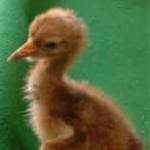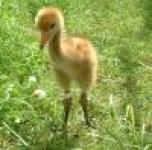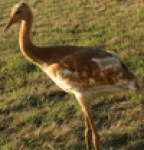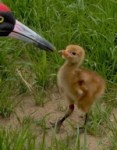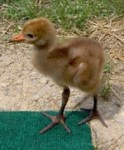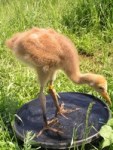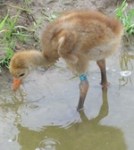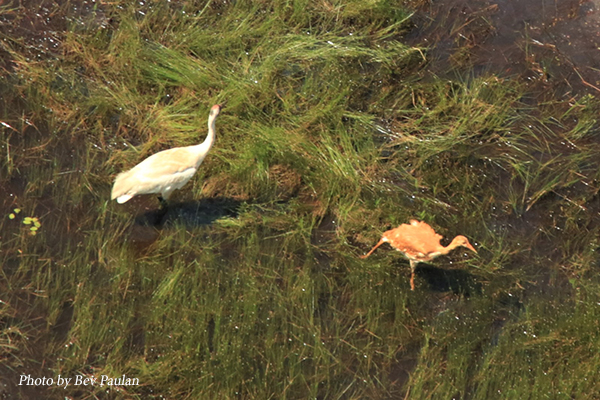This is the first year the Whooping Crane Eastern Partnership utilized two release methods: Ultralight-guided and Direct Autumn Release (DAR).
The DAR method also involves costume handlers raising the young crane chicks in the field. The difference is that prior to the fall migration period, the young cranes are released to form associations with older, experienced Whooping cranes to guide the younger cranes to a safe wintering location.
The aircraft guided migration began at Necedah National Wildlife Refuge in Juneau County, Wisconsin, on October 14, 2005. The 1200-mile trip ended 64 days later on January 12, 2006, in Citrus County, Florida at the Chassahowitzka National Wildlife Refuge.
Group One: Ultralight-guided Whooping Cranes
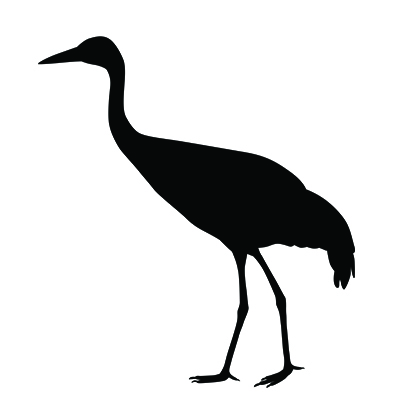
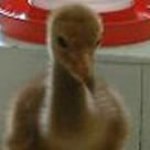


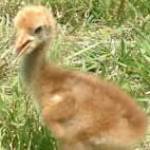
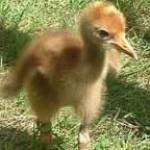

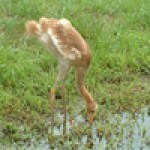

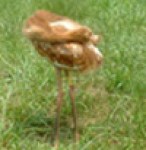
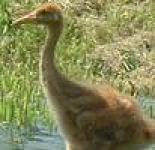
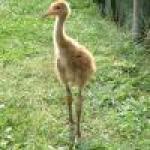
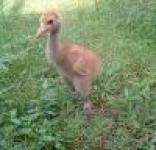
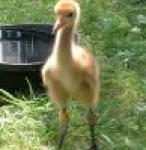
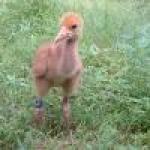
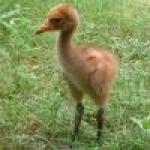
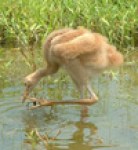
Crane #1-05
Sex: Female
Hatch Date: April 20, 2005
Personality and Characteristics: Migration Training – She missed a few days of training in the first weeks of her life due to a slight health problem, but she quickly recovered. She is dominant over #2-05, who is a very scared bird in general. On May 12, #1-05 was a bit of a hassle during training. During circle pen training, the pilot/trainer stops occasionally to give treats to the birds in the little inner-circle of sand. After each of these brief stops, #1-05 chased after #2-05 as she came running after Mark Nipper (in costume in the trike). Mark wasn’t sure if #2-05 was following him and the trike, or just running away from #1-05–but it worked out well. So far #1-05 doesn’t have the “hate” (though she is getting close), and just seems to be asserting her dominance. She swallowed a puppet string.
She was shipped to Necedah NWR in Wisconsin on June 15 with the rest of cohort #1. On the chicks’ first day of training at Necedah, #1-05 was curious enough to wander off after a scared #2-05 when she headed into the marsh. On July 2, #1-05, #2-05 and #3-05 got airborne. July 9 the three oldest are flying beautifully, crossing entire lengths of the runway. July 13 the three flew with the trike beyond the end of the runway and even landed again with the trike—real progress!
Cohort 1 was doing great until about mid-September, when they went through a bit of regression after the stress of health exams. On September 9, all the birds except one tried to leave the pilot at some point during the training flight. The pilots hope the chicks will be excited to follow the trike again soon.
This picky little girl has always been trouble when it comes to taking her vitamins and medicines. She will not just eat anything; she has to wash her food off first. She follows well enough and is a good flyer. She can be a little feisty at times.
First Migration South: Chick #1-05 left Wisconsin for her first migration on October 14th, 2005. Read day-by-day news about the flock’s migration to see what happens.
She did just great, and landed safely with the 19-bird flock on December 13 at the holding pen at Halpata Preserve. The cranes will be moved 26 miles to their final release pen at Chassahowitzka NWR (“Chass”) in mid-January after all the older cranes have dispersed from the pen site.
The pilots and ultralights tried to move the birds on January 9. Crane #1-05 made it to Chass on the third day of trying, January 11. HOME for the winter!
Spring 2006: Began first spring migration from the “Chass” pen site March 28 with all flock members except #20-05. This flock of 18 split at roost time on March 28, and fourteen juveniles (#1-05, #2-05, #3-05, #5-05, #6-05, #7-05, #8-05, #9-05, #10-05, #12-05, #14-05, #19-05, #23-05, and #24-05) stayed together. They probably roosted near the confluence of 3 counties (Turner, Crisp and Wilcox) in Georgia. They didn’t move the next day. On March 30 they resumed migration and roosted in Hamilton County, TN. The next roosting place was March 31 in Spence County, KY; April 1 in Jefferson County, IN; April 2 and 3 in DuPage County, IL; April 4 in McHenry County, IL. (past Chicago). They are determined to get back to Wisconsin! They flew two days in rain, and in strong headwinds on April 4. On April 5 they resumed migration, stopping in Sauk County, WI—just short of Necedah NWR! Tracker Richard Urbanek was monitoring them the morning of April 6 when they took off. They completed spring migration as they passed the SW corner of Necedah NWR just after noon. (They kept going! They landed, foraged, and roosted that night in nearby Trempealeau County, WI.)
Fall 2006: Female #1-05 began migration with #8-04 on November 3. They roosted that night in Boone County, Illinois. They were in Kankakee County, IL on November 11-12. They successfully migrated to Florida, where #1-05 and #8-04 remained in the sub-adult flock in Pasco County, FL.
Spring 2007: Began migration March 19 (with #8-04 and #14-05). They arrived together at Necedah NWR on March 29. Her nonfunctional transmitter was replaced on August 30, 2007.
Fall 2007: Crane #1-05 and male #10-03 left Necedah NWR on migration November 22 and made it to Jasper-Pulaski wildlife area in Indiana that day. They continued into Kentucky on November 23. The next day they migrated through northern Georgia. They were found back on their old territory in Colleton County, South Carolina, on November 30.
Spring 2008: Confirmed back at Necedah NWR March 29 with mate #10-03. Last summer the pair built a nest so hopes were high for nesting again. But no sooner had they settled on their territory than #27-06 took over and drove off #10-03’s mate. That didn’t last long, and #1-05 was next seen with male #5-01! Will she mate and lay eggs this summer???
Fall 2008: Left Necedah NWR Nov. 20 with #5-01. The pair arrived together at Hernando County, Florida by December 27. Both had nonfunctional transmitters and could not be tracked. The pair was observed at the Chassahowitzka NWR pensite January 18. Next they appeared at Homosassa Springs Wildlife State Park January 20, where two captive Whooping cranes live. They were captured and transferred to the Marion County Halpata-Tastanaki Preserve pen site. Their old transmitter batteries were replaced on January 21, 2009. The pair were then crated, transported, and released in Alachua County, FL on January 22. They returned to Hernando County January 30 only to reappear at the Chass pensite the following day — and found the Class of 2008 had arrived! The next morning, February 1, they returned to the Homosassa Springs State Wildlife Park and were again captured and transported to the Halpata pensite. This time they were taken to Meigs County, TN where they were released on February 4.
Spring 2009: #1-05, #5-01, #6-05, and DAR #37-07 were confirmed by radio signal near Armstrong Bend, TN on March 8. Female #1-05 was confirmed back at Necedah (with her mate #5-01) by the end of March or beginning of April. The pair began incubating on their nest April 21, but the nest failed soon after.
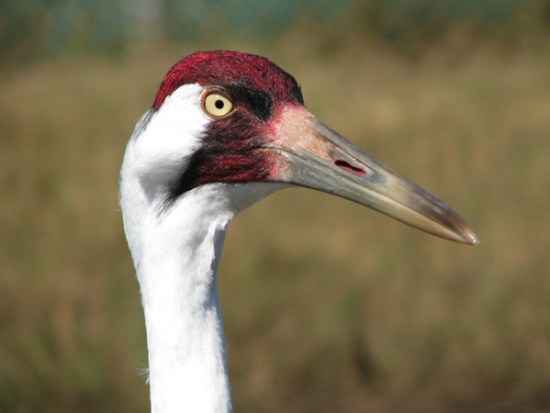
“She has THE most incredibly beautiful head I have ever seen on a Whooping crane. This picture allows you to see that the black facial markings are actually red patches of skin that are sprinkled with tiny black hair-like feathers.” – Eva Szyszkoski, ICF
Fall 2009: The pair #1-05 and #5-01 stayed together over the summer but the pair bond briefly ended after September 26. Crane #16-03 was observed in courtship display directed toward #1-05 on September 28, and these two remained together until October 24. Surprise: #1-05 was back with her previous mate, #5-01, two days later! Crane #1-05 and her old mate #5-01 began migration Nov. 26 and were found at Hiwassee Wildlife Refuge in Tennessee, on November 29. The pair stayed six weeks. In early February they landed back at their first Florida home, the pen site at Chassahowitzka, where they stayed!
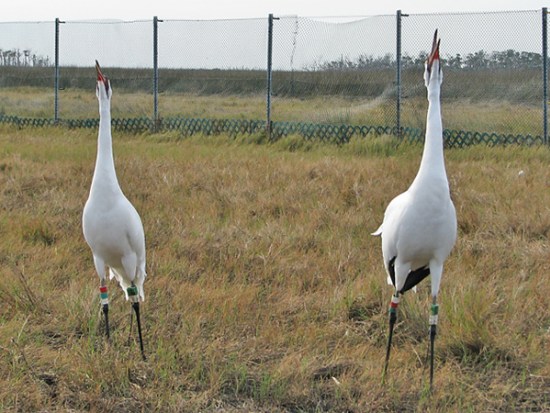
Crane pair #1-05 and #5-01 unison calling in Florida. Unison calling strengthens pair bonds but also asserts dominance and threatens other cranes (or here, the costumes). The cranes are saying: ‘This is my area. You better scram.” – Eva Szyszkoski, ICF
Spring 2010: Adult pair #5-01 and #1-05 and the nine remaining chicks at Chass were beginning to show signs of migration restlessness on March 13. Eva said, “We are not sure if the adult pair will entice the chicks to leave earlier than they would otherwise. We would expect#5-01 and #1-05 to be leaving at any time, as they will want to get back to Necedah NWR to establish their territory on the refuge for nesting season.
On March 19 the carcass of adult female #1-05 was found south of the pen site on Chassahowitzka NWR in Citrus County, Florida. On the previous night, she had been killed by a bobcat on a tidal mudflat. She and her mate #5-01 had roosted during the night with 9 2009 juveniles on the partially flooded flat. Her death reduces the number of pairs that have produced eggs in the new flock from 11 to 10. The carcass was transferred to Dr. Marilyn Spalding, University of Florida, for necropsy.
Click here to jump to the top of this page.
Crane #2-05
Sex: Female
Hatch Date: April 23, 2005
Personality and Characteristics: Migration Training – A little more nervous than the others in the first couple weeks of life. The week of May 28, #1-05, #2-05, and #3-05 began training behind the trike at the hatching center in Maryland. Moved to Wisconsin on June 15 with the other five oldest birds. She has a habit in which she always has to wash off whatever she’s found or been given to eat! On her first day of flight school at Necedah NWR in Wisconsin, she wouldn’t leave the pen. The noise of the approaching engine, though familiar, was too much for her and she was too scared to leave the pen. Pilot Joe Duff said, “She pushed against the back fence as the others tentatively came out the gate. We shut off the engine and spent 10 minutes coaxing her out. Once the engine was started again, and we began to taxi, she headed for the protection of the tall grass. Torn between hiding and following, she ran through the scrub brush, parallel to the runway, as the trike and the rest of the cohort headed north. Once we reached the end of the training strip, we stopped and began foraging for meal worms. Chick #2-05 headed deeper into the marsh. Once we had coaxed, cajoled, and corralled #2-05 back to the pen, we spent the better part of an hour foraging for treats around the aircraft. The birds and I poked the propeller, flicked the antenna, and generally kicked the tires until all the scariness was out of it. For the rest of the day, we replaced the heavy wooden gates with a wire mesh panel, Afterward, we parked the trike right outside. This gave the flock a view of the aircraft and lessened its mystique. This process was repeated the next day, and on the fourth day, #2-05 was the first bird out of the pen and first in line to run beside the aircraft.”
On July 2, #1-05, #2-05 and #3-05 got airborne. July 9 the three oldest are flying beautifully, crossing entire lengths of the run way. July 13 the three flew with the trike beyond the end of the runway and even landed again with the trike—real progress!
On August 1 this cohort flew 17 minutes behind the ultralight! “Chick #2-05 may be the best flyer in this group, and has always been a very cute bird,” said handler Mark Nipper.
At mid-September, Cohort 1 was going through a bit of regression after the stress of health exams. On September 9, all the birds except #2-05 tried to leave the pilot at some point during the training flight. Chick #2-05 is currently the whitest bird among the new flock, and she could be the best flyer in the whole flock–but for sure in this cohort.
History
First Migration South: Chick #2-05 left Wisconsin for her first migration on October 14th, 2005. Read day-by-day news about the flock’s migration to see what happens. She did just great, and landed safely with the 19-bird flock on December 13 at the holding pen at Halpata Preserve. The cranes will be moved 26 miles to their final release pen at Chassahowitzka NWR (“Chass”) in mid-January after all the older cranes have dispersed from the pen site.
The pilots and ultralights tried to move the birds on January 9. Crane #2-05 made it to Chass on the third day of trying, January 11. HOME for the winter!
Spring 2006: Began first spring migration from the “Chass” pen site March 28 with all flock members except #20-05. This flock of 18 split at roost time on March 28, and fourteen juveniles (#1-05, #2-05, #3-05, #5-05, #6-05, #7-05, #8-05, #9-05, #10-05, #12-05, #14-05, #19-05, #23-05, and #24-05) stayed together. They probably roosted near the confluence of Turner, Crisp and Wilcox Counties in Georgia. They didn’t move the next day. On March 30 they resumed migration and roosted in Hamilton County, TN. The next roosting place was March 31 in Spence County, KY; April 1 in Jefferson County, IN; April 2 and 3 in DuPage County, IL; April 4 in McHenry County, IL. (past Chicago). They are determined to get back to Wisconsin! They flew two days in rain, and in strong headwinds on April 4. On April 5 they resumed migration, stopping in Sauk County, WI–just short of Necedah NWR! Tracker Richard Urbanek was monitoring them the morning of April 6 when they took off. They completed spring migration as they passed the SW corner of Necedah NWR just after noon. (They kept going! They landed, foraged, and roosted that night in nearby Trempealeau County, WI.) In the summer she wandered with some flock mates. She later moved to an area of IOWA, along with #3-05 and #7-05.
Fall 2006: Began migration from Winnebago County, Iowa on October 31 with #3-05 and #7-05. On Nov. 6, less than a week later, they had successfully migrated to Florida! This was the first unassisted fall migration for these birds.
Spring 2007: Began migration from FL on March 18 (with #3-05 and #7-05). They were in Tennessee on 20 March (PTT), and in Jackson County, Indiana the next day. They remained there at least through 27 March. A low precision PTT reading for #2-05 indicated the group may have roosted in southwestern Michigan on April 1. By April 5 they had arrived back in Dodge County, Wisconsin.
Female #2-05 paired with male #7-04 and they spent most of their time in Meadow Valley Flowage. She died suddenly before the summer ended. On August 20 her completely intact body was found in a few inches of water. Experts believe death occurred on August 16 or 17, before the rains came and the marsh was likely dried up. Preliminary necropsy results indicated that she had died from an epicardial hemorrhage with cause yet to be determined.
Click here to jump to the top of this page.
Crane #3-05
Sex: Male
Hatch Date: April 23, 2005
Personality and Characteristics: Migration Training – A little distracted at ground school at Patuxent, but still got good scores. At the beginning of May Mark said “#3-05 and #4-05 (she later died of health problems) start off great during trike training, but then get distracted and gradually pay less and less attention. These two have been able to walk together in the afternoons, but do not get along well enough to train together. The two seem to be buddies when they are in separate pens.” Chick #4-05 later died of health problems, and #3-05 was shipped to Necedah NWR in Wisconsin on June 15 with the rest of cohort #1.
By July 9, #1-05, #2-05 and #3-05 were flying low and beautifully along the entire length of the runway at flight school in Wisconsin. July 13 the three flew with the trike beyond the end of the runway and even landed again with the trike—real progress!
At mid-September, Cohort 1 was going through a bit of regression after the stress of health exams. Chick #3-05 often followed #5-05 on his frequent drop outs. On September 9, all the birds except one tried to leave the pilot at some point during the training flight. The pilots hope the chicks will be excited to follow the trike again soon.
By September 15, this male is the biggest bird in the flock. He’s a good flyer, although lately he’s been leading other birds away occasionally. He is a dominant bird in the cohort, and he can be distant or aggressive to the handlers.
History
First Migration South: Chick #3-05 left Wisconsin for his first migration on October 14th, 2005.
Here is more news about Chick #3-05:
Day 1: He returned to the pen and had to be crated and taken to the first stopover. (Chicks #5-05, #6-06, #16-05 and #24-05 turned back too.)
On November 1 (day 19), #3-05 dropped out with about 6 miles left. He landed in an agricultural field. Mark Nipper tells more: “This bird had been struggling to keep up for about 10 miles or so. Shortly after #3-05 landed, I used the radio signals to determine which field the bird was in, but signal became very strange. It kept sounding like the bird was flying for short periods. This happened several times. All of a sudden the signal was back the other way–and a bird was crashing around in a thick hedge row between these two immense farming fields. Poor #3-05 was thoroughly tangled up in some pretty nasty vines. He was understandably rather upset about it. After freeing the bird and getting him out to the field, it became obvious that #3-05 didn’t really want to be in the field. He wanted to hide in the tree line. This ended up working out just fine because there was no way that one person (me) was going to get back to the van, get a crate, and return to the bird without it seeing everything. I placed a vocalizer in a branch of a tree with a clearing of nice moss bedding underneath. The welcoming brood call from the vocalizer made #3-05 rather happy, and allowed me enough time to get the crate out.”
Chick #3-05 was one of the six that had to be crated Nov. 30 as the flock left Hiwassee Wildlife Refuge. He took off, but kept turning back. Pilot Joe said, “#3-05 kept breaking from the aircraft and leading the others back. I am sure it was the one that mutinied on Brooke originally. Once I found these birds in the air, I would get them on the wing and turn them on course but a bird in the middle of the group would turn away. Then they would all go. When I would catch up with them heading north again, #3-05 was always in the lead.” He flew just fine on the next days when the whole flock of 19 flew together.
#3-05 landed safely with the 19-bird flock on December 13 at the holding pen at Halpata Preserve. The cranes will be moved 26 miles to their final release pen at Chassahowitzka NWR (“Chass”) in mid-January after all the older cranes have dispersed from the release pen.
The pilots and ultralights tried to move the birds on January 9. Crane #3-05 made it to Chass on the third day of trying, January 11. HOME for the winter!
On March 25th #3-05’s beak was examined by two Disney veterinarians. It appeared that the bird injured its beak several weeks earlier as the beak became caught in some opening, probably in the fence. It caused a serious scrape wound on the maxilla and an overgrown tip of the mandible, but the beak was healing just fine. No treatment was performed.
Spring 2006: Began first spring migration from the “Chass” pen site March 28 with all flock members except #20-05. This flock of 18 split at roost time on March 28, and fourteen juveniles (#1-05, #2-05, #3-05, #5-05, #6-05, #7-05, #8-05, #9-05, #10-05, #12-05, #14-05, #19-05, #23-05, and #24-05) stayed together. They probably roosted near the confluence of Turner, Crisp and Wilcox Counties in Georgia. They didn’t move the next day. On March 30 they resumed migration and roosted in Hamilton County, TN. The next roosting place was March 31 in Spence County, KY; April 1 in Jefferson County, IN; April 2 and 3 in DuPage County, IL; April 4 in McHenry County, IL. (past Chicago). They are determined to get back to Wisconsin! They flew two days in rain, and in stong headwinds on April 4. On April 5 they resumed migration, stopping in Sauk County, WI – just short of Necedah NWR! Tracker Richard Urbanek was monitoring them the morning of April 6 when they took off. They completed spring migration as they passed the SW corner of Necedah NWR just after noon. (They kept going! They landed, foraged, and roosted that night in nearby Trempealeau County, WI.) In the summer he wandered with some flock mates. He later moved to an area of IOWA, along with #2-05 and #7-05.
Fall 2006: Began migration from Winnebago County, Iowa on October 31 with #2-05 and #7-05. On Nov. 6, less than a week later, they had successfully migrated to Florida! This was the first unassisted fall migration for these birds.
Spring 2007: Began migration from FL on March 18 (with #2-05 and #7-05). They were in Tennessee on 20 March (PTT), and in Jackson County, Indiana the next day. They remained there at least through 27 March. A low precision PTT reading for #2-05 indicated the group may have roosted in southwestern Michigan on April 1. By April 5 they had arrived back in Wisconsin. Last recorded on May 26. He and his mate were not found in Iowa or southwestern Wisconsin during an aerial search on October 11, 2007.
Fall 2007: #3-05 and mate #7-05 were still missing at the end of December.
Spring 2008: On April 20 the remains of #3-05 and #7-05 were found in Wood County, Wisconsin. Radio signals of the two birds had been detected April 7. The mortality site was only 0.5 miles from where the pair had been last been observed in May 2007, an indication that death happened shortly after that observation, and the faint signals from the inundated transmitters had escaped detection.
Click here to jump to the top of this page.
Crane #5-05
Sex: Male
Hatch Date: May 1, 2005
Personality and Characteristics: Migration Training – Chicks #5-05, #6-05 and #7-05 were the first group of birds well-behaved enough to train together in their first weeks of ground school at Patuxent. Mark Nipper says, “They are funny little birds. Dominance in this group seems to change every day. They follow the trike pretty well for most of the time. Chick #5-05 doesn’t cow down to #6-05 readily, even when #6-05 starts trouble. With these guys it isn’t true fighting, but usually just bumping chests to see who is bigger.”
Chick #5-05 was shipped to Necedah NWR in Wisconsin on June 15 with the rest of cohort #1. By July 6, he and buddies #6-05 and #7-05 were trying hard to get airborne with the ultralight plane. He was doing short flights by July 9, but still walked or ran the rest of the runway. On August 1, Brooke flew in and all the birds came out of the pen in a shot. All six took off with the plane, but #5-05 soon came back. The other five birds flew for about 17 minutes. After the flight was over, the crane handlers got everyone but #5-05 back in the pen. They kept him out to get more training time. He flew on the wing for the length of the runway but peeled off quickly as pilot Brooke climbed and turned the trike (ultralight plane). Mark Nipper said, “#5-05 follows well and has a good attitude; it just needs some more time to develop.” It was slow. On August 8th, when his cohort mates took off after the trike, #5-05 would not leave until scared off by the Swamp Monster! After a few minutes, #6-05 joined #5-05 and the two of them went back to the pen. After training the other four birds, and getting them back into the pen, pilots decided to try flying #5-05 and #6-05 again. This time it worked better. They flew over to a plot of flat land where the chicks were fed a small feast of smelt and grapes. They expected these treats as if they were royalty! Then the pilot led them in flight over Rynearson Pool 2, at which time #6-05 decided to go back to the pen. But #5-05 wanted to keep going, and he struggled to get closer to the wing. After a few minutes, #5-05 got the hang of it and he and the pilot flew on a tour of the refuge. On the way back to the pen, #5-05 suddenly went down and, to Richard’s (the pilot’s) amazement, landed next to an adult crane from an earlier ultralight flock. Worried, Richard made a quick turn and flew by the confused chick just as the adult attacked #5-05. But #5-05 flew up and got along the wing as if nothing had happened! He landed safely back at his pen. But after that, #5-05 started not wanting to come out of the pen. For several days, he seemed scared of Mark in his costume and terrified every time the the trike flew by the pen. But once coaxed out of the pen, #5-05 acts perfectly normal and flies wonderfully with the trike. “It beats me,” said Mark. “We will just have to wait to see what happens tomorrow.”
In mid August, #5-05 hurt his leg while playing with a goose feather. Pilot Joe Duff said, “I saw a goose feather on the grass runway and decided to get the birds playing with it. I picked it up with the puppet and let the wind have it. Sure enough, #5-05 got excited and ran and jumped over as if to pounce on it. It went bad as the bird came down and began hobbling and not putting weight on one leg.” It scared the handlers, but luckily the bird improved greatly in just a few hours.
By mid-September, Cohort 1 was backsliding in progress a bit after the stress of health exams. Chick #5-05 causes the most worry, as he remains very timid. Some days he won’t come out of the pen. The commotion seems to scare him. Sometimes he won’t take off after the trike. Other times he returns to the runway before training is over, but he is getting better. He’s not a strong flyer, but does follow well.
Chick #5-05 broke away when Cohort One was flying over to join Cohorts 2 and 3 for the first time on September 17. Joe had to swoop in to lead him over. It took Joe in the air and the swamp monsters on the ground to keep #5-05 on Joe’s wing, and #5-05 kept wanting to land for most of the flight. But–GREAT news–#5-05 stayed with the flock for the whole flight the first time all 20 flew together a few days later!
First Migration South: Chick #5-05 left Wisconsin for his first migration on October 14th, 2005. Read day-by-day news about the flock’s migration to see what happens.
Here is more news about Crane #5-05’s first migration:
On day 1 he returned to the pen and had to be crated and taken to the first stopover. (Chicks #3-05, #6-05, #16-05 and #24-05 turned back too.)
On Day 2, #5-05 thrilled the pilots by flying the entire 27 miles with the ultralight! They have been worried how he’d do on migration. On Day 3 #5-05 didn’t get out of the pen in time to take off with Richard’s plane and the other 19 birds. He flew alone with Brooke’s ultralight for another good travel day!
#5-05 has been difficult in the past, preferring to turn back rather than stay with the rest of the flock. On Oct. 26 (Day 13) Brooke concentrated all his efforts on #5-05 after the others had taken off. The bird kept turning back after a few miles. Only after 30 minutes of aerial drama did the bird finally follow Brooke’s plane. Brooke arrived after being airborne for 2 hours and 6 minutes and walked #5-05 to the pen. WAY TO GO!
#5-05 landed safely with the 19-bird flock on December 13 at the holding pen at Halpata Preserve. The cranes will be moved 26 miles to their final release pen at Chassahowitzka NWR (“Chass”) in mid-January after all the older cranes have dispersed from the release pen.
The pilots and ultralights tried to move the birds on January 9. Crane #5-05 made it to Chass on the third day of trying, January 11. HOME for the winter!
Spring 2006: Began first spring migration from the “Chass” pen site March 28 with all flock members except #20-05. This flock of 18 split at roost time on March 28, and fourteen juveniles (#1-05, #2-05, #3-05, #5-05, #6-05, #7-05, #8-05, #9-05, #10-05, #12-05, #14-05, #19-05, #23-05, and #24-05) stayed together. They probably roosted near the confluence of Turner, Crisp and Wilcox Counties in Georgia. They didn’t move the next day. On March 30 they resumed migration and roosted in Hamilton County, TN. The next roosting place was March 31 in Spence County, KY; April 1 in Jefferson County, IN; April 2 and 3 in DuPage County, IL; April 4 in McHenry County, IL. (past Chicago). They are determined to get back to Wisconsin! They flew two days in rain, and in strong headwinds on April 4. On April 5 they resumed migration, stopping in Sauk County, WI–just short of Necedah NWR! Tracker Richard Urbanek was monitoring them the morning of April 6 when they took off. They completed spring migration as they passed the SW corner of Necedah NWR just after noon. (They kept going! They landed, foraged, and roosted that night in nearby Trempealeau County, WI.) They spent the summer wandering in and out of the core reintroduction area. Crane #5-05 (with #6-05) was last confirmed in Green County, WI on September 15.
Fall 2006: Began migration from Wisconsin on Nov. 19 with #6-05. Made it to SE Indiana that day. Found roosting near the Halpata Tastanaki pensite (last year’s layover site on arrival) in Marion County, FL on Nov. 24! Then detected in flight in Citrus County with female #21-05 on Nov. 25. Cranes #5-05 and #6-05 were in Citrus County at the end of December.
Spring 2007: Began migrating on March 13 with #6-05. They were in Cumberland County, Tennessee, until March 17-24. They arrived on Necedah NWR on April 2.
Fall 2007: Left Wisconsin on migration on November 27 with #12-05. They migrated together at least as far as central Indiana on November 27. Crane #5-05 was found without #12-05 at Hiwassee WR in Tennessee on December 1. He was next seen with with #15-04 in Meigs County, Tennessee, on December 2 and they stayed the winter.
Spring 2008: Crane #5-05, with female #15-04, began migration from Hiwassee WR in Meigs County, TN sometime between February 28 and March 2. They remained with migrating sandhills in Jackson County, Indiana, at least through March 18. The pair was back at Necedah NWR March 27. In April they were nesting, but by April 30 the nest had failed. The pair was seen foraging away from the nest area, and a nest check found only eggshell bits. Sara said, “It’s not surprising; this pair just formed this winter and neither bird had previous nesting experience.”
Fall 2008: Male #5-05 and mate #15-04 were still in Wisconsin in mid-November, due to #15-04’s leg being injured from a fishing line entanglement. However, they successfully migrated south to Meigs County, Tennessee, for the winter.
Spring 2009: On March 8 male #5-05 and mate #15-04 left a migration stop in Jackson County, Indiana, where they’d been since March 5. They were the first whooper sightings reported for the spring 2009 migration. The pair was next reported in White County, Indiana, on March 12 and 13. By April 2 they were already observed incubating on a nest on their usual territory in Wisconsin at Necedah NWR! (Nest later failed before eggs could hatch.)
Fall 2009: Pair #5-05 and #15-04 disappeared from the Necedah NWR at the end of October, likely starting migration. They were found at Armstrong Bend, Meigs County, Tennessee, on December 13.
Spring 2010: Cranes #5-05 and #15-04 were reported in Lawrence County, Indiana, on February 26 – March 8. Both have nonfunctional transmitters. They were reported back on Necedah NWR on April 1 or 2 and already had an active nest by that time. That nest failed. The nest failed but a rescued egg was sent to Patuxent WRC in Maryland where it hatched on May 4 into female chick #3-10 in the Class of 2010!
Fall 2010: Migrated south with #15-04 to the pair’s usual winter territory at Hiwassee Wildlife Refuge in Tennessee.
Spring 2011: Departed on migration from Hiwassee WR in Tennessee in mid February with #15-04 and young #21-10 (DAR). They were next reported Feb. 26 in Hardin County, Kentucky and in Jackson County, Indiana on March 1. The three made the final legs of their journey during the second week of March to arrive on Necedah NWR March 11. Pair #5-05 and #15-04 were sitting on a nest and incubating on April 10. Their nest failed April 29, and two fertile, viable eggs were collected. Both hatched in captivity and one egg became chick #9-11 in the Class of 2011. The other became a member of the new non-migratory Louisiana flock.
Fall 2010: Migrated south with #15-04 to Meigs County, Tennessee.
Spring 2012: Pair #5-05 and mate #15-04 had completed migration back to Necedah NWR by March 14. They had a nest by April 17, but it failed on April 21. They did not build a second nest.
Fall 2012: Male #5-05 and his mate migrated south together.
Spring 2013: Male #5-05 with his mate #15-04 arrived on the nesting grounds of Necedah NWR in Wisconsin on March 29, but the female was not seen after June 11. It appeared that she had died; all summer, a bird with a nonfunctional transmitter, assumed to be male #5-05, had been consistently observed on the pair’s old territory but with a new female: #23-10.
Fall 2013: By November, tracker Eva Syszkoski suspected that Crane #5-05 had died—but In January 2014 she found him in Meigs County, Tennessee! He had paired up with a new mate: female #32-09 DAR. In more good news, parent-reared juvenile #22-13 was hanging around with this new pair! This is a good sign that the chick will have “adoptive parents” to help it survive winter and return to Wisconsin in spring. Well done, #5-05!
Spring 2014: Pair #5-05 and #32-09 DAR began migration from near the Hiwassee Wildlife Refuge in Meigs County, Tennessee, on February 17 or 18, and their “adopted” youngster, #22-13 was still with them. They were reported in Hardin County, Kentucky, on February 18 and had arrived in Washington County, Indiana, by February 21. The pair was confirmed back at the Necedah NWR on March 28. By mid April this pair had a nest, which was still active when checked April 30, but they abandoned the nest in May.
Fall 2014: Left Necedah on October 29 and then left Rock County, WI on migration with #32-09 DAR around mid November. They wintered at Hiwassee Wildlife Refuge in Meigs County, Tennessee.
Spring 2015: Male #5-05 and mate #32-09 (DAR) were observed back on territory in Wisconsin by the March 25 aerial survey. The pair’s second nest produced chick #W15-15 on June second, shown here on June 8, but the chick did not survive the month.
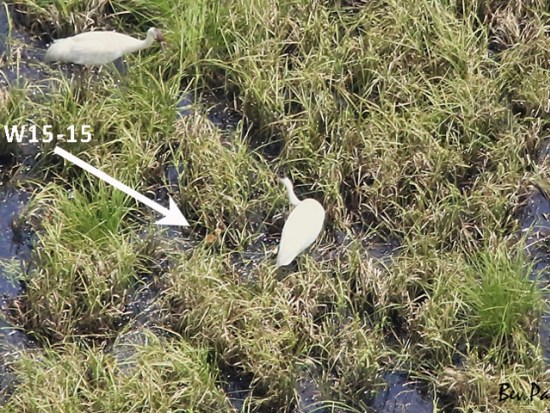
Photo Beverly Paulan, Wisconsin DNR pilot
Male #5-05 also died later in the season. His remains were found September 2, with death likely due to predation.
Click here to jump to the top of this page.
Crane #6-05
Sex: Male
Hatch Date: May 2, 2005
Personality and Characteristics: Migration Training – Chicks #5-05, #6-05 and #7-05 were the first group of birds behaved well enough to train together in their first weeks. Mark Nipper says, “They are funny little birds. Dominance in this group seems to change every day. They follow the trike pretty well for most of the time. #6-05 is the most aggressive, but the dominance is hard to tell during training. Just because he starts everything doesn’t mean he is winning. The other two in his little group don’t readily cow down to him, even when he starts trouble. With these guys it isn’t true fighting, but usually just bumping chests to see who is bigger.” He was shipped to Necedah NWR in Wisconsin on June 15 with the rest of cohort #1.
By July 9, #6-05 was still a “lagger.” He needs a little more coaxing to follow and does very little flying yet. But he IS a little younger than the other Cohort One chicks, and will need a few more days before he can fly as well as the others.
While flying on August 8th, #6-05 joined #5-05 after a few minutes of flying with the trike, and the two of them went back to the pen. After training the other four birds in this group and getting them back into the pen, the pilot decided to try flying #5-05 and #6-05 again. This time it worked better. They flew over to a plot of flat land where the two chicks were fed a small feast of smelt and grapes. (They expected these treats as if they were royalty!) Then they flew back with the trike over a pool, and that’s when #6-05 decided to go back to the pen instead of following the trike some more.
He will eat anything, and he loves corn. He is weaker than some of the birds, and turns back to the runway. He is middle in the order of dominance. On August 10 the handlers said #6-05 sounded very good. His normal-sounding peep was very encouraging, since he’s had periodic respiratory problems since he arrived at Necedah, and he coughs occasionally.
On Aug. 11, #6-05 got lost! The Cohort One birds had a great flight around the Refuge but got spooked by the traffic when the pilots led them near the highway. The pilots knew they’d better take them home. But trouble struck over a thickly wooded area on the way to the pens. Mark said, “Poor little #6-05 just couldn’t get the altitude and speed to keep up with the trike and went down in the woods.” After some frantic circling and searching by pilot Richard van Heuvelen (RVH), a full-scale search was launched. Helpers got the capture gear: crate, first aid kit, and bull horn speaker for the vocalizer, waders, treats, binoculars, and GPS. Everyone pitched in, the rains fell, and Richard circled the trike in the air search as the others slogged through the forest in what became an extremely grueling and fruitless 6-hour march. A further problem was #6-05’s respiratory trouble. This not only weakened the chick, but also affected its peeping ability. A good way to find a bird is to play the vocalizer and then turn it off to listen for the chick to answer. It was looking pretty bleak when RVH came over the radio of the ground searchers, yelling that he had #6-05 in the air and it was heading right for the wing. The bird followed for a short distance then made its way over to another wetland on the refuge and landed. RVH pulled off a daredevil landing on a dike and joined the bird. He arrived to discover the bird in perfect shape and mood. They got #6-05 in the crate and back to the pen. The happy ending is that bird was perfectly fine after being lost for about six hours. Where was he all that time? One of the refuge staff spotted #6-05 walking down Headquarters Road (the main entrance to the refuge)! This was shortly before RVH flew over, so #6-05 must have gotten in the air from that road. Searchers think that #6-05 was in the woods and they just missed it. The chick eventually found a lovely clearing with nice foraging along a road that they had driven back and forth on at least ten times and within ten minutes of RVH spotting it. Mark Nipper said, “We were all quite happy and celebrated by eating lunch and sleeping the rest of the day.”
At mid-September, Cohort 1 was going through a bit of regression after the stress of the health exams. Chick #6-05 often follows #5-05 on his frequent drop outs. On September 9, all the birds except one tried to leave the pilot at some point during the training flight. The pilots hope the chicks will be excited to follow the trike again soon.
First Migration South: Chick #6-05 left Wisconsin for his first migration on October 14th, 2005. Read day-by-day news about the flock’s migration to see what happens. Here is more news about Chick #6-05:
On day 1 he returned to the pen and had to be crated and taken to the first stopover. (Chicks #3-05, #5-05, #16-05 and #24-05 turned back too.)
On day 43 in Tennessee, he dropped away from the birds following Joe’s plane as they climbed to cross the highest mountains on the migration route. As they descended to land after a tough flight, Joe noticed one more bird up high. With 10 on the ground and 9 on their way down, Joe thought that the high one must be one of the older cranes also reaching the Hiwassee Refuge. But once it landed there was no mistake, it was #6-05! Joe said, “All nineteen birds were safely on the ground, which meant one had followed us at tree-top level for the last 10 miles but the other crossed the ridge and kept us in sight for better than 30 miles, joining us as we circled down.” Which do you think was #6-05?
#6-05 landed safely with the 19-bird flock on December 13 at the holding pen at Halpata Preserve. The cranes will be moved 26 miles to their final release pen at Chassahowitzka NWR (“Chass”) in mid-January after all the older cranes have dispersed from the release pen.
The pilots and ultralights tried to move the birds on January 9. Crane #6-05 made it to Chass on the third day of trying, January 11. HOME for the winter!
Spring 2006: Began first spring migration from the “Chass” pen site March 28 with all flock members except #20-05. This flock of 18 split at roost time on March 28, and fourteen juveniles (#1-05, #2-05, #3-05, #5-05, #6-05, #7-05, #8-05, #9-05, #10-05, #12-05, #14-05, #19-05, #23-05, and #24-05) stayed together. They probably roosted near the confluence of Turner, Crisp and Wilcox Counties in Georgia. They didn’t move the next day. On March 30 they resumed migration and roosted in Hamilton County, TN. The next roosting place was March 31 in Spence County, KY; April 1 in Jefferson County, IN; April 2 and 3 in DuPage County, IL; April 4 in McHenry County, IL. (past Chicago). They are determined to get back to Wisconsin! They flew two days in rain, and in stong headwinds on April 4. On April 5 they resumed migration, stopping in Sauk County, WI–just short of Necedah NWR! Tracker Richard Urbanek was monitoring them the morning of April 6 when they took off. They completed spring migration as they passed the SW corner of Necedah NWR just after noon. (They kept going! They landed, foraged, and roosted that night in nearby Trempealeau County, WI.) He spent the summer wandering in and near the core reintroduction area. Crane #6-05 (with #5-05) was last confirmed in Green County, WI on September 15.
Fall 2006: Began migration from Wisconsin on Nov. 19 with #5-05. Made it to SE Indiana that day. Found roosting near the Halpata Tastanaki pensite (last year’s layover site on arrival) in Marion County, FL on Nov. 24! Then detected in flight in Citrus County with female #21-05 on Nov. 25. Cranes #5-05 and #6-05 were in Citrus County at the end of December.
Spring 2007: Began migrating on March 13 with #6-05. They were in Cumberland County, Tennessee, until March 17-24. They arrived on Necedah NWR on April 2.
Fall 2007: Left Necedah NWR on October 6. Radio signal last detected from undetermined location south of Mill Bluff, Wisconsin, during aerial survey on October 10. Reported near Arena, Iowa County, on November 17 and still present on November 23. Next reported with #13-03 and #18-03 on a wildlife refuge in Alabama on December 27-30. The group reached the old Florida pen site on January 5 and roosted that night, along with #9-03 and #3-04. The five moved together the next day but separated in flight on Jan. 7. Crane #6-05 moved to Marion County, Florida.
Spring 2008: Crane #6-05 began migration from Sumter County, Florida, on March 4. On April 3-5 he was observed associating with female #7-01 in Adams County, Wisconsin, so he’s back!
Fall 2008: Crane #6-05 was believed to still be in the southern part of Wisconsin as of November 24, after all other Whooping cranes in the flock had recently departed on migration. He did successfully migrate to Meigs County, Tennessee.
Spring 2009: #6-05, #1-05, #5-01, and DAR #37-07 were confirmed by radio signal near Armstrong Bend, TN on March 8. By March 28 he had been confirmed back at Necedah NWR in Wisconsin. Great news came when once again he and female #7-01 temporarily began hanging out together in Adams County. Would they mate so #7-01 would finally nest and lay eggs? They were together by May 2 but, alas, separated by May 12. He remained single all summer.
Fall 2009: By December 7, all but 11 Whooping Cranes were gone from the new Eastern flock’s summer home in Wisconsin. Those 11 included pair #7-03 and #26-07, two single males (#6-05 and #13-07) and seven of this year’s (2009) nine DAR chicks. They surprised experts when they chose to begin migration on a very snowy December 11, after being content to roost on ice and standing in the brisk winter wind for the previous week. They had reached Winnebago County, Illinois! The birds had moved on by the time trackers got there the next day. Eva said, “When we finally got a reading, we were all surprised to see that they had flown east of Indianapolis, Indiana, 240 miles southeast of their last location and right on track with the main migration route for Sandhill Cranes. I arrived at the location and heard all 11 signals coming from the same area. But I could not see them since it was dark outside.” The next morning they made a couple of local movements before traveling only 50 miles to the Muscatatuck National Wildlife Refuge, near the Indiana/Kentucky Border. In the first three days of migration, which was the first-ever migration for the seven chicks, they flew a total of 430 miles!
Crane #6-05 and the seven 2009 DAR chicks continued to Jefferson County, Kentucky. They moved to Adair County, Kentucky on February 12 or 13. They stayed at least through Feb. 28.
Spring 2010: Cranes #6-05 and youngsters DAR #32-09, #34-09, #35-09, #36-09, #37-09, #40-09 and #41-09 were reported back in Jefferson County, KY on March 1. They migrated from there to Muscatatuck NWR, Jackson County, Indiana, on March 5. On March 15 or 16 they separated into two groups. PTT data for #32-09 (DAR) indicated a roost location for her and presumably #6-05, #37-09 (DAR), and #40-09 (DAR) in Champaign County, Illinois. On March 18 PTT data confirmed #32-09 back at Necedah! A few days later #6-05 and the two others migrating with them were visually confirmed: migration complete. In mid April he was still with the three DAR birds he migrated back north with (#32-09, #37-09, and #40-09) and tracker Eva said, “Hopefully he steals one of those two females when that group breaks up!” But that group was reported in Adams County, WI along with female #7-01 by mid April. Male #6-05 was last detected on Necedah NWR on May 31, when he was observed with female #26-09. (He had previously been disappearing to and returning from an undetermined location.) He was back on the refuge in mid October.
Fall 2010: Migrated and wintered in Hamilton County, Tennessee with #6-09 and #38-09 (DAR).
Spring 2011: The group #6-05, #6-09 and #38-09 (DAR) left Hamilton County, TN sometime between Feb. 25 and 27. Crane #6-05 was found in Juneau County, on March 27, migration complete. During summer he paired with #37-09 DAR. DAR #37-09 paired with #6-05 in 2011 and migrated with him to Jackson County, Indiana, that fall.
Fall 2011: Crane #6-05 migrated with female #37-09 DAR to Jackson County, Indiana, where he was later killed. His carcass was found Dec. 30 by a photographer near the Muscatatuck River basin, about 40 miles north of Louisville, Kentucky. X-rays showed a fatal gunshot wound caused the bird’s death. A reward is being offered for any information leading to prosecution of the shooter of this federally endangered bird.
Crane #6-05 is the second shooting of a Whooping crane in Indiana. The first was in 2009 when female #17-02, the seven-year-old matriarch of the first chicks hatched to the new Eastern Migratory Flock, was killed by illegal gunfire.
As of February 2017, the case remained open with a reward of $7500 for information leading to the arrest of the shooter.
Click here to jump to the top of this page.
Crane #7-05
Sex: Female
Hatch Date: May 4, 2005
Personality and Characteristics: Migration Training – In her first days, trainer Mark Nipper said, “#7-05 is a little, well ‘crazy’ is the only way to put it. This little one runs around her pen screaming more than anything else. The poor little bird is healthy enough, she just needs time to calm down a bit.” Trainers got her to eat and drink a little more and thought that would calm her. “There are always birds that are scared, angry, or just plain nuts, but they all figure it out eventually,” said Mark. Chicks #5-05, #6-05 and #7-05 were the first group of birds behaved well enough to train together in their first weeks. Mark said, “They are funny little birds. Dominance in this group seems to change every day. They follow the trike pretty well for most of the time.” She doesn’t readily back down to the more aggressive #6-05.
She was shipped to Necedah NWR in Wisconsin on June 15 with the rest of cohort #1. On July 9 she was left in the pen during training due to a toe injury. Cohort 1 was doing great until about mid-September, when they went through a bit of regression after the health checks. On September 9, all the birds except one tried to leave the pilot at some point during the training flight. The pilots hope the chicks will be excited to follow the trike again soon.
She is generally a good flyer, but will follow buddy #6-05 back to the runway during training flights. Very submissive, and the lowest bird on the dominance scale. She also acts submissively to handlers, not always pecking at the bill of the puppets.
History
First Migration South: Chick #7-05 left Wisconsin for his first migration on October 14th, 2005.
Here is more news about Crane #7-05’s first migration: On day 2 of the migration, #7-05 (and #12-05) turned back to the launch area. They were crated and traveled by van to the new stopover site in Juneau County, WI. She was a real trooper the rest of the migration, and never made any trouble.
On Dec. 13, #7-05 landed safely with the 19-bird flock at the holding pen at Halpata Preserve. The cranes will be moved 26 miles to their final release pen at Chassahowitzka NWR (“Chass”) in mid-January after all the older cranes have dispersed from the release pen.
The pilots and ultralights tried to move the birds on January 9. Crane #7-05 made it to Chass on the third day of trying, January 11. HOME for the winter!
Spring 2006: Began first spring migration from the “Chass” pen site March 28 with all flock members except #20-05. This flock of 18 split at roost time on March 28, and fourteen juveniles (#1-05, #2-05, #3-05, #5-05, #6-05, #7-05, #8-05, #9-05, #10-05, #12-05, #14-05, #19-05, #23-05, and #24-05) stayed together. They probably roosted near the confluence of Turner, Crisp and Wilcox Counties in Georgia. They didn’t move the next day. On March 30 they resumed migration and roosted in Hamilton County, TN. The next roosting place was March 31 in Spence County, KY; April 1 in Jefferson County, IN; April 2 and 3 in DuPage County, IL; April 4 in McHenry County, IL. (past Chicago). They are determined to get back to Wisconsin! They flew two days in rain, and in strong headwinds on April 4. On April 5 they resumed migration, stopping in Sauk County, WI–just short of Necedah NWR! Tracker Richard Urbanek was monitoring them the morning of April 6 when they took off. They completed spring migration as they passed the SW corner of Necedah NWR just after noon. (They kept going! They landed, foraged, and roosted that night in nearby Trempealeau County, WI.) In the summer she wandered with some flock mates. She later moved to an area of IOWA, along with #2-05 and #3-05.
Fall 2006: Began migration from Winnebago County, Iowa on October 31 with #2-05 and #3-05. On Nov. 6, less than a week later, they had successfully migrated to Florida! This was the first unassisted fall migration for these birds.
Spring 2007: Began migration from FL on March 18 (with #2-05 and #3-05). They were in Tennessee on 20 March (PTT), and in Jackson County, Indiana the next day. They remained there at least through 27 March. A low precision PTT reading for #2-05 indicated the group may have roosted in southwestern Michigan on April 1. By April 5 they had arrived back in Dodge County, Wisconsin. She and #3-05 were last recorded on May 26. They were not found in Iowa or southwestern Wisconsin during an aerial search on October 11, 2007.
Fall 2007: They were still missing by the end of December.
Spring 2008: On April 20 the remains of #3-05 and #7-05 were found in Wood County, Wisconsin. Radio signals of the two birds had been detected April 7. The mortality site was only 0.5 miles from where the pair had been last been observed in May 2007, an indication that death happened shortly after that observation, and the faint signals from the inundated transmitters had escaped detection.
Click here to jump to the top of this page.
Crane #8-05
Sex: Female
Hatch Date: May 8, 2005
Migration Training: Gave trainers a bit of a scare for for the first few days after hatching. She was not gaining weight well and had to be tube fed. Made a comeback on May 11 and is now doing well.
Began first training a few days later when still pretty young, and was quite scared of the trike. After a few days she was much less frightened. On May 15 she was found fighting with #4-05 (who later got sick and died) through the Plexiglas that separates their pens. Their food bowls were right next to each other and they were fighting over them. #8-05 is about 5-7 inches tall, while the older #4-05 was already around 2 feet tall. Birds that young can be violent enough to take on full adults sometimes too. It is a great example of the instinctual aggressiveness of these chicks. She got along with #9-05 while at Patuxent. The trainers worked hard to add chick #13-05 to the little group of #8-05 and #9-05. (#13-05 wants to be in charge all the time.) By the end of June she seemed to grow out of her aggressiveness. She now lets #13-05 dominate this group of oldest birds. Chick #8-05 was held back in Maryland due to injuries when the rest of cohort 2 was shipped on July 6. Instead, #8-05 arrived at Necedah NWR in Wisconsin with shipment 3 (the youngest chicks) on July 13. She and #14-05, also held back with injuries, were reunited in the pen with their old cohort after arrival. They did well on the journey from Patuxent in Maryland and began to drink and eat upon entering the pen at their new summer home in Wisconsin. On July 30 it was too windy to train with the trike, so the birds were let out to exercise. Right away, #8-05 and #9-05 (currently, cohort 2’s two best flyers) took off and easily cleared the short fence bordering the runway to land about 50 yards away in a fun, marshy area.
On August 1 #8-05 was flying on the wing of the trike (while #9-05 flew straight into the marsh as usual)–and #8-05 flew 17 minutes with the ultralight!
On September 9, #8-05 and her Cohort 2 had a great day. All 8 birds took off from the runway on the first try and never looked back. They flew for about 15 minutes, and stayed with the pilot for the entire flight! What a relief after several days of dropping out and missing flying time after the stress of the health checks.
She has gone from being a very aggressive little chick to a submissive colt and a good flyer. She follows and flies well, and loves the water in the wet pen.
First Migration South: Chick #8-05 left Wisconsin for her first migration on October 14th, 2005. Read day-by-day news about the flock’s migration to see what happens.
Here is more news about Chick #8-05’s first migration:
On Day 1, #8-05 landed 1 mile short of the first stopover site. She was just too tired to make the distance. She was crated and driven to the first stopover site, but did just great after that! She landed safely with the flock at the temporary holding site at Halpata Preserve in Marion County, FL on December 13. The cranes will be moved to their final release pen in mid-January after all the older cranes have dispersed from the pen site.
On January 9–nearly a month after the migration ended, Crane #8-05 was the only one to successfully fly with the ultralights from the temporary pen at Halpata Preserve to their final winter pen at Chassahowitzka NWR, 26 miles away. She spent the night by herself in the top-netted pen at Chassahowitzka. Pilots spent the next 2 days trying to move the rest of the birds.
Spring 2006: Began first spring migration from the “Chass” pen site March 28 with all flock members except #20-05. This flock of 18 split at roost time on March 28, and fourteen juveniles (#1-05, #2-05, #3-05, #5-05, #6-05, #7-05, #8-05, #9-05, #10-05, #12-05, #14-05, #19-05, #23-05, and #24-05) stayed together. They probably roosted near the confluence of Turner, Crisp and Wilcox Counties in Georgia. They didn’t move the next day. On March 30 they resumed migration and roosted in Hamilton County, TN. The next roosting place was March 31 in Spence County, KY; April 1 in Jefferson County, IN; April 2 and 3 in DuPage County, IL; April 4 in McHenry County, IL. (past Chicago). They are determined to get back to Wisconsin! They flew two days in rain, and in strong headwinds on April 4. On April 5 they resumed migration, stopping in Sauk County, WI–just short of Necedah NWR! Tracker Richard Urbanek was monitoring them the morning of April 6 when they took off. They completed spring migration as they passed the SW corner of Necedah NWR just after noon. (They kept going! They landed, foraged, and roosted that night in nearby Trempealeau County, WI.)
A PTT reading for #8-05 on the night of 8 September 8 indicated that the pair #8-05 and #7-04 had moved to southeastern MINNESOTA, where #7-04 had been present at the same time in 2005. The pair later moved to Marathon County, Wisconsin, where they hung out with a flock of sandhill cranes.
Fall 2006: Remained in Central Wisconsin with mate #7-04 until late November. She was later reported in Alabama and then by Dec. 27 in Florida. She was in a small flock of sandhill cranes. (Her former mate #7-04 was not seen after a Nov. 29 sighting in Wisconsin, until he was seen without her in Florida on Dec. 28.) PTT signals in early January put her in Louisiana where she was observed with Sandhill cranes.
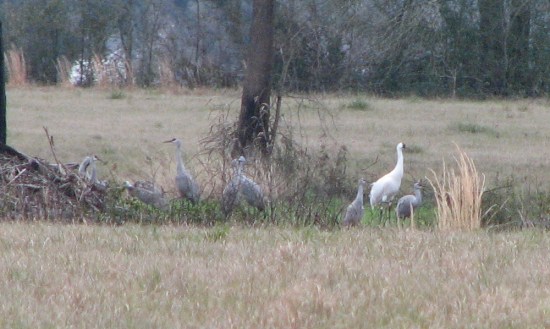
Feb. 2, 2007: Crane #8-05 forages with Sandhill cranes in Louisiana. Photo: Richard Urbanek
Spring 2007: Female #8-05 began migration from Louisiana on March 4. A PTT reading showed she roosted in Illinois, on the night of March 23. She returned to the core reintroduction area in Central Wisconsin by March 29.
Fall 2007: Migrated from Wisconsin to Kane County, Illinois, on November 22 with crane #1-04. By the end of December the two were in Davidson County, Tennessee.
Cranes #8-05 and #1-04 are on private property. The owner put up a sign because people were trespassing to see the pair of whoopers. (Unfortunately, some people still trespassed, endangering the birds’ safety.)
Spring 2008: Signals heard on the refuge March 30 confirmed the pair (#1-04 and #8-05) was back on Necedah NWR. They began nesting around April 16, but only eggshell fragments were found when the nest was checked on May 5.
This pair separated for a short time in early fall but got together again on November 5 or 6.
Fall 2008: Migrated with mate #1-04. They were in Davidson County, Tennessee for the winter.
Spring 2009: Began migration with mate #1-04 on or after March 9.Reported back at Necedah NWR in Wisconsin by March 19. She and mate #1-04 were found on a nest April 9! The nest failed April 24.
Fall 2009: Began migration with mate #1-04 on November 15, a day with clear skies and north winds to help push them south. Amazingly, they met up with another pair (#14-05 and #12-07) and a single crane (#29-08) at the same location in Winnebago County, Illinois, where they remained until December 9. No further reports.
Spring 2010: The signal of #8-05 and mate #1-04 were detected on Necedah NWR on March 17, although the birds had not yet been visually confirmed. They had been reported south of the Jasper-Pulaski FWA in Indiana on March 10 and in Lake County, Indiana, on March 14 and 15. They were reported back at Necedah NWR on March 17.
Fall 2010: Female #8-05 and mate #1-04 migrated to Morgan County, Alabama, but they were no longer found at that location after January 27.
Spring 2011: Female #8-05 and mate #1-04 were back at Necedah NWR by March 21. On April this pair was nesting but the nest failed May 7. Two eggs were destroyed before they could be collected.
Fall 2011: Tracker Eva said #1-04 & #8-05 “have a habit of wintering in areas that we have trouble locating.” They did not winter in Illinois because they were only detected there once or twice and then moved on to an unknown location. This winter, #W1-10 apparently wintered with this adult pair.
Spring 2012: Crane #8-05 and mate #1-04, with #W1-10, showed up in Douglas County, Illinois on Feb. 28, reported ICF tracker Eva Szyszkoski. The three cranes stayed together as they migrated back to Necedah NWR where they showed up on March 14.
Fall 2012: Wintered with mate #1-04 in Davidson Co., Tennessee.
Spring 2013: Pair #8-05 and #1-04 completed spring migration to Wisconsin on March 30.
Fall 2013: Crane #8-05 and his mate #1-04 migrated south to Wheeler NWR in northern Alabama.
Spring 2014: Pair #8-05 and #1-04 were seen in Giles County in mid-Tennessee in early February. They were seen departing on Feb. 22, traveling with Sandhill cranes. This location was north of the wintering location where they were seen in December. They were next reported in Lawrence County, Illinois, on 19 March where they remained through at least 28 March. They were back at Necedah NWR on April 1, but likely arrived March 31st. The pair nested in Juneau County, and the nest was still active as of April 30. However, on the May 29 aerial survey flight the pair was seen foraging away from the nest, so they had abandoned it.
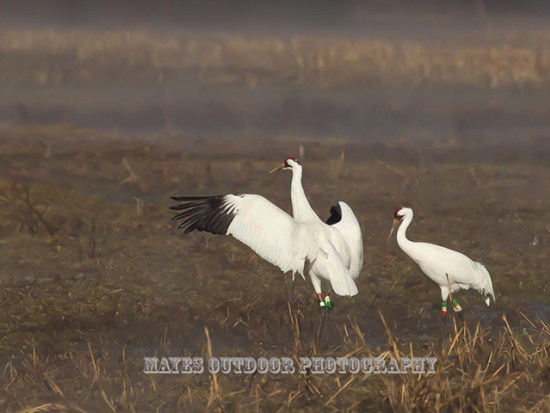
Fall 2014: Pair #8-05 and #1-04 left Juneau County WI, on fall migration around Nov. 8 and migrated to Wheeler NWR in Alabama. They were not consistently there all winter and probably used another nearby area as well.
Spring 2015: Pair #8-05 and #1-04 returned to central Wisconsin and nested. Those first eggs were removed April 16 by experts in the forced renesting program, but their second nest produced chick #W16-5 around June 2. The chick was still alive as of pilot Bev Paulan’s June 23 aerial survey, but did not survive to fledge.
Fall 2015: Crane pair #8-05 and male #1-04 spent about a month in Lawrence County, IL before moving on to their wintering grounds at Wheeler NWR in Morgan County, AL.
Spring 2016: Crane pair #8-05 and male #1-04 were first reported back on the breeding grounds on March 29th, 2016. Their first nest failed; they were seen on a renest May 6 and hatched two chicks: #W9-16 on May 26 and #W10-16 on May 28. Chick #W10 was last seen alive June 2, and #W9-16 was still alive and with the parents on their territory Aug. 4 but by end of August had died.
Fall 2016: No reports on female #8-05 but her mate #1-04 was still in Wisconsin and alone as of Nov. 18.
Spring 2017: No news
Click here to jump to the top of this page.
Crane #9-05
Sex: Male
Hatch Date: May 10, 2005
Personality and Characteristics: Migration Training – Learned quickly how to eat food and drink water with the puppet’s example. #9-05 and #10-05 have been training and walking buddies ever since they were tiny chicks. On June 3 they both started their circle pen training. Chick #9-05 shipped to Wisconsin on July 6 with #10-05 and all the rest of Cohort 2. On the first day of training after arrival at Necedah NWR, #9-05 needed extra coaxing to come out of the pen. Trainer Robert Doyle fed #9-05 smelt (smelly little fish) to get him to follow the trike along the grass training strip. Then, after it finally rained and filled the pond, almost nothing would get #9-05 out of the wet part of the chicks’ pen. Arm flapping, yummy treats, battery-powered vocalizers–all these tricks had to be used to coax #9-05 to come out of the wet pent for training. Sometimes other birds, especially his buddy #10-05, followed his bad example.
By July 30, #9-05 was coming out of the wet pen and onto the runway without any hassles. But his new bad-habit-of-the-week was to fly off the runway and into the non-enclosed marsh area to forage (probe for food). One day #9-05 and #8-05 (the group’s two best flyers at this time) took off and easily cleared the short fence bordering the runway. They landed about 50 yards away in a fun, marshy area, ignoring the costumed crane handlers AND the ultralight planes (trikes). Shortly after, chicks #10-05, #11-05, and #12-05 flew off to join the wayward chicks in the marsh! As trainer John Thomton says, #9-05 has always been a very independent bird. “He’s a little bit of an outsider in the group, but whenever anyone challenges him, he’s quick to put the challenger in his place. He’s also good at ignoring the handlers when he wants. I’m always wondering what #9-05 will do tomorrow!”
Things went well until August 28, when Cohort 2 moved in with Cohort 3 chicks at the east site. When the Cohort 2 birds (the better flyers) were let out to fly with the ultralight, #9-05 spent more time on the grass runway than following the ultralight.
On September 9, Cohort 2 had a great day. All 8 birds took off from the runway on the first try and never looked back. They flew for about 15 minutes, and stayed with the pilot for the entire flight! What a relief after several days of dropping out and missing flying time, most likely from the stress of the health exams.
This is an independent bird, but much improved from a month ago. He flies well, but can be slow to return to the pen after training. He can be aggressive, and is mid-level in dominance.
History
First Migration South: Chick #9-05 left Wisconsin for his first migration on October 14th, 2005. Read day-by-day news about the flock’s migration and you’ll see that #9-05 must have been a real trooper because he never made his own headlines. He landed safely with the flock at the temporary holding site at Halpata Preserve in Marion County, FL on December 13. The cranes will be moved to their final release pen in mid-January after all the older cranes have dispersed from the pen site.
On January 10, Crane #9-05 made it to the final pen site at Chassahowitzka NWR on day 2 of the pilots’ attempts to move the flock. The birds slowly became familiar with the idea of again following the ultralight after a month’s vacation. Richard and Brooke managed to get #9-05 and 5 other birds far enough from the pen that they fell into line and followed the final 26 miles. HOME for the winter!
Spring 2006: Began first spring migration from the “Chass” pen site March 28 with all flock members except #20-05. This flock of 18 split at roost time on March 28, and fourteen juveniles (#1-05, #2-05, #3-05, #5-05, #6-05, #7-05, #8-05, #9-05, #10-05, #12-05, #14-05, #19-05, #23-05, and #24-05) stayed together. They probably roosted near the confluence of Turner, Crisp and Wilcox Counties in Georgia. They didn’t move the next day. On March 30 they resumed migration and roosted in Hamilton County, TN. The next roosting place was March 31 in Spence County, KY; April 1 in Jefferson County, IN; April 2 and 3 in DuPage County, IL; April 4 in McHenry County, IL. (past Chicago). They are determined to get back to Wisconsin! They flew two days in rain, and in strong headwinds on April 4. On April 5 they resumed migration, stopping in Sauk County, WI—just short of Necedah NWR! Tracker Richard Urbanek was monitoring them the morning of April 6 when they took off. They completed spring migration as they passed the SW corner of Necedah NWR just after noon. (They kept going! They landed, foraged, and roosted that night in nearby Trempealeau County, WI.) He wandered a lot during the summer and was reported with sandhills in Barron County, on September 5 after not being seen anywhere since June 18 in Fayette County, Iowa.
Fall 2006: He was seen in Clark County, WI on 22 October. It’s uncertain when he left Wisconsin, but #9-05 was last reported migrating with six Sandhill cranes in Georgia on Oct 28. Arrived in Lake County, Florida on Nov. 22, HOME.
Spring 2007: Left Lake County, Florida between April 21 and April 29 and arrived home in Wisconsin on May 4! He summered on Pool 13 at Necedah NWR last year. Then on October 24 he moved to Rock County WI with #5-05 and #12-05.
Fall 2007: Left Rock County, Wisconsin on migration on November 23, separate from the other two birds he’d been with. Arrived on Hiwassee WR in Tennessee by November 24. Departed Hiwassee sometime between November 25 and 28. Last recorded with wintering sandhills in Lake County, Florida, on Jan. 9, 2008.
Spring 2008: Arrived back in Wisconsin April 15!
Fall 2008: He was reported with #14-05 and sandhill cranes in Jackson County, Alabama, on December 16. He completed migration to Florida, where he was found with sandhill cranes in Lake County during an aerial flight on February 6, 2009.
Spring/Summer 2009: Began migration from Lake County, Florida, on March 18. By March 25 he had been confirmed back at Necedah NWR in Wisconsin. During summer training of the Class of 2009 chicks, #9-05 was a frequent visitor to the grass training strip. He liked to interrupt the training sessions. One day the pilot tried to get him to fly off by acting like a crane: walking tall and slow with his puppet head held high in an aggressive pose, but to no avail. The pilot said, “I uselessly chased him around the trike, some of the chicks joining in the chase. I hopped back in the trike, fired up the engine and taxied back to the west, 9 chicks and one adult in tow. Once we stopped at the end of the runway, the adult pair that frequents this site came out of the marsh and quickly accomplished what I had been unable to do — chase off #9-05. Their unison calls and ability to fly convinced him that he was trespassing, and after a brief chase by one of the adults, he went flying off but will likely be back to bother us another day.” Sure enough, #9-05 camps out behind the pen where the youngest chicks live. One day in September when the ultralight led the youngest chicks on a flight, he found himself alone and called and cried mournfully. Was he sad to be left all alone? On Sep. 30, he interfered when all 21 of the Class of 2009 were together for socializing for the first time as a group, and some of the chicks were aggressive towards #9-05.
Fall 2009: Crane #9-05 was still on Necedah NWR Nov. 30, and closely associating with DAR chick #42-09. Will he lead her on her first migration?
Fall 2009: Adult #9-05 was hanging closely with DAR #42-09 starting on November 11. Would he be her migration leader? Yes! These two birds left Necedah National Wildlife Refuge on December 6 and moved down to Sauk County, Wisconsin. By December 8 they were no longer at this location. Trackers guessed they had started migration but the two birds were never detected or reported during their migration.Then came good news on January 4, 2010. The Florida landowner on whose property #9-05 spent last winter called ICF trackers to report the arrival of two cranes, one browner and one white. Tracker Sara confirmed it was #9-05 returning to his previous wintering area in Lake County, FL—with chick #42-09! Male #9-05 was the leader for the first DAR chick in the Class of 2009 to complete her first journey south!
Spring 2010: Crane #9-05 and #42-09 DAR began spring migration on March 6 or 7. Female #42-09 (DAR) was reported back on Necedah NWR by March 22 and #9-05 by March 24, but both were likely together on March 22. They had separated by April 1 and #9-05 paired with adult female #18-08. This was good news, but #9-05 was once again left alone when his new mate #18-08 was killed by a predator on Necedah NWR sometime between April 21 and April 25, 2010. Will he find another mate? We hope so! He remained in the same area.
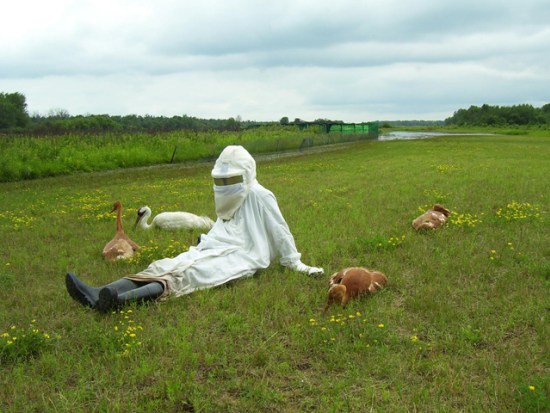
Male #9-05 napped with the chicks on the runway one day because it was the only dry place to lie down during a very soggy, rainy week. He has taken his usual watchful and caring role with the chicks. Photo: Joe Duff
Female #13-03 was observed with #9-05 on his territory several times during October.
Fall 2010: Male #9-05 apparently began migration from Necedah NWR on November 23. He was next found on his usual wintering territory in Lake County, Florida during an aerial survey on December 13.
Spring 2011: He began migration on March 8. Completed migration to Necedah NWR by March 26. He apparently won the heart of #13-03; by April 12 the new pair was incubating on a nest! They hatched one chick (#W3-11) on May 10. The chick survived the May 22 tornado in the nesting territory but disappeared on June 10.
Fall 2011: Male #9-05 and his mate #13-03 began fall migration between November 23-27. Their wintering area was unknown to trackers.
Spring 2012: Male #9-05 and his mate #13-03 were detected as they arrived back at Wisconsin’s Necedah NWR on March 11, migration complete! They were found with a nest on April 6 but they later abandoned it. The pair built a second nest and started incubating April 18. This nest was successful! Chick #W8-12 was confirmed on the May 21 tracking flight. Chick #W8-12 still survives as of Nov., 2012.
Fall 2012: He migrated south with his mate and their chick. The family was believed to be in Indiana as of Dec. 21, per tracker Eva Szyszkoski.
Spring 2013: On March 30 the family of #9-05, with his mate #13-03 and the chick #W8-12 from last summer, completed their migration north. HOORAY! The pair was already sitting on a new nest by mid April. They abandoned the nest—but their two rescued eggs were incubated at ICF, and chicks #1-13 and #4-13 hatched to become part of the ultralight-led cohort for the Class of 2013.
Spring 2014: Pair #13-03 and #9-05 completed migration back to the Necedah NWR on 26 March. The pair nested in Juneau County and were first seen incubating on April 9. They hatched the season’s FIRST chick on May 8 and the second soon after! The first chick was assigned the number #W1-14: “W” for a wild chick, 1 for the first hatch of the year, and 14 for the year. The second chick is #W2-14. Neither chick survived the summer. However, the parents “adopted” one of the chicks from the parent-reared release program when young female #20-14 was set free near them in fall before migration.
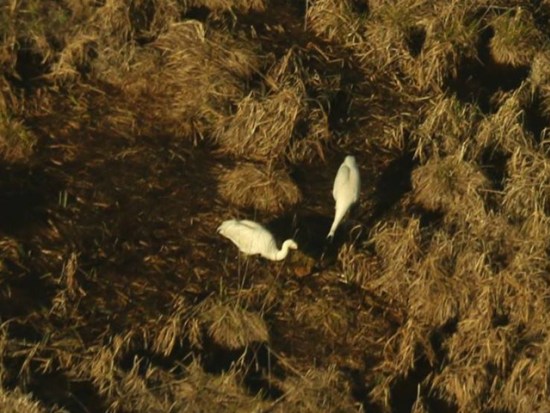
9-05 & 13-03 with chicks W1-14 and W2-14. Photo: Bev Paulan, Wisconsin DNR
Fall 2014: Pair #9-05 and #13-03 and their adopted chick, parent-reared #20-14 (adopted in fall when the young female was released on the refuge) migrated together to Greene County, Indiana, departing Necedah on Oct. 31. Well done! These three birds were seen associating with pair #8-04 and #19-05 in December at their Indiana location. Young #20-14 spent winter with her new parents in Jackson County, Alabama.
Spring 2015: Male #9-05 and mate #13-03 began migration from Jackson County, Alabama, on March 7-8 with their adopted parent-reared chick #20-14, and the three completed migration to Wisconsin by March 19. The adult pair nested and on May 3 they hatched the first chick of the season, but the chick soon disappeared.
Fall 2015: Pair #9-05 and #13-03 were confirmed in Greene County, Indiana by Nov. 13, having departed Necedah NWR sometime in the previous two weeks. Several other whoopers from the eastern flock were also in Geene County on that date.
Spring 2016: Male #9-05 and mate #13-03 were back at Necedah NWR and already tending a nest with two eggs by April 7! They were the first nesters this season and on May 1-2 hatched two chicks, #W1-16 and #W2-16! On May 5, Wisconsin DNR pilot Bev Paulan saw mom #13-03 with both her chicks but the second chick (#W2-16) had died by Bev’s survey flight in mid May. Chick #W1-16 was seen by pilot Bev Paulan on a May 11 flight, but had died by July 1.
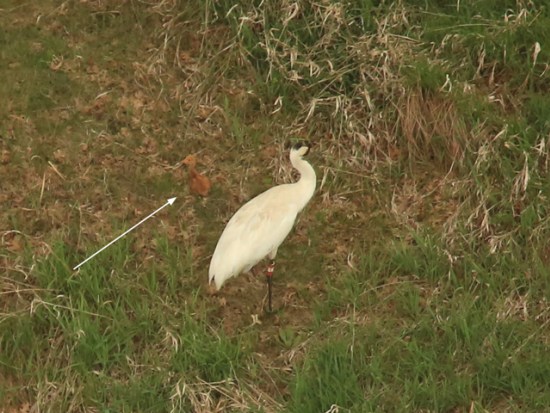
Whooping crane chick W1-16 with Mom #13-03. Photo: Bev Paulan
Fall 2016: Wintered again in Green County, Indiana.
Spring 2017: Male #9-05 and mate #13-03 were back at Necedah NWR and tending a nest by early April. They re-nested and were incubating their second nest when seen on Bev Paulan’s May 12 flight. By June 5th they were off the nest and provisioning for a single chick #W12-17. On June 21 refuge staff collected the remains of tiny #W12-17.
Spring 2018: This pair returned to Necedah NWR in April and began nesting. Unfortunately, their nest was lost in a late winter storm with dropped up to 20 inches of snow. There is still time for them to re-nest.
Summer 2018: 13-03 and 9-05 did not renest in 2018.
Fall 2018: Mid-October 13-03 and 9-05 were sighted on their wintering grounds at Goose Pond, Indiana. They were frequently seen with male 19-10 over the winter.
Spring 2019: Trackers first saw 13-03 and mate 9-05 at Necedah National Wildlife Refuge in early April.
9-05 and 13-03 were first seen incubating a nest by pilot Bev Paulan on April 10. The eggs from this nest were removed as part of the forced renesting program.
On May 3, Bev saw them sitting on a renest, though the nest had failed by May 12.
Amazingly, on May 30, Bev saw them on a nest again! They are only the second pair in the Eastern Migratory Population to nest three times in a season. Chick W19-19 hatched at the end of June, and fledged in September! This is the second chick this pair has raised to fledging.
Fall 2019: 13-03, 9-05, and chick W19-19 migrated together and were first seen at their wintering location of Goose Pond at the beginning of November. They also made a stop in Winnebago County, Illinois on the way. In February, 13-03 was captured and given one of the first new transmitters that sends us GPS locations of her.
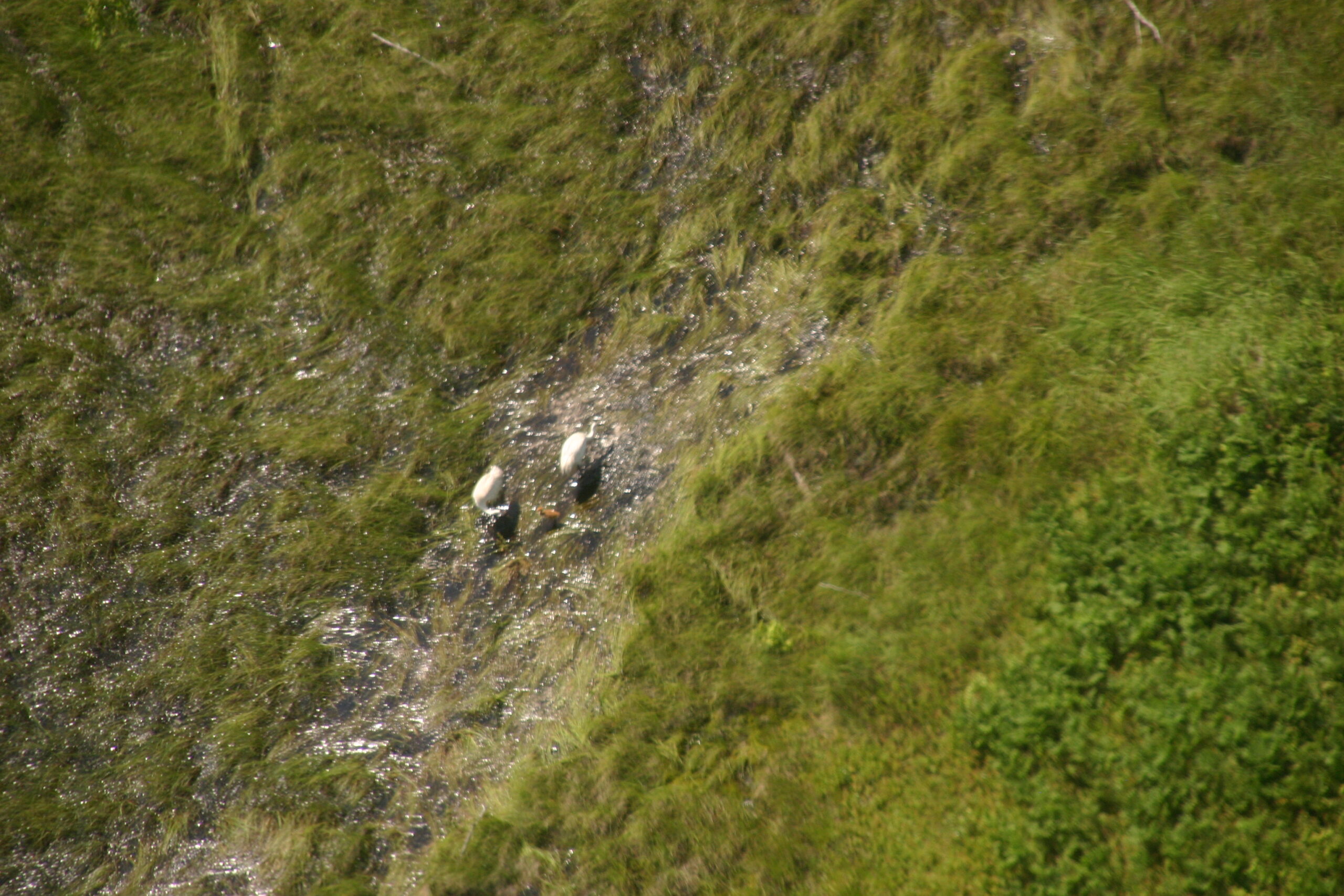
Photo: Bev Paulan
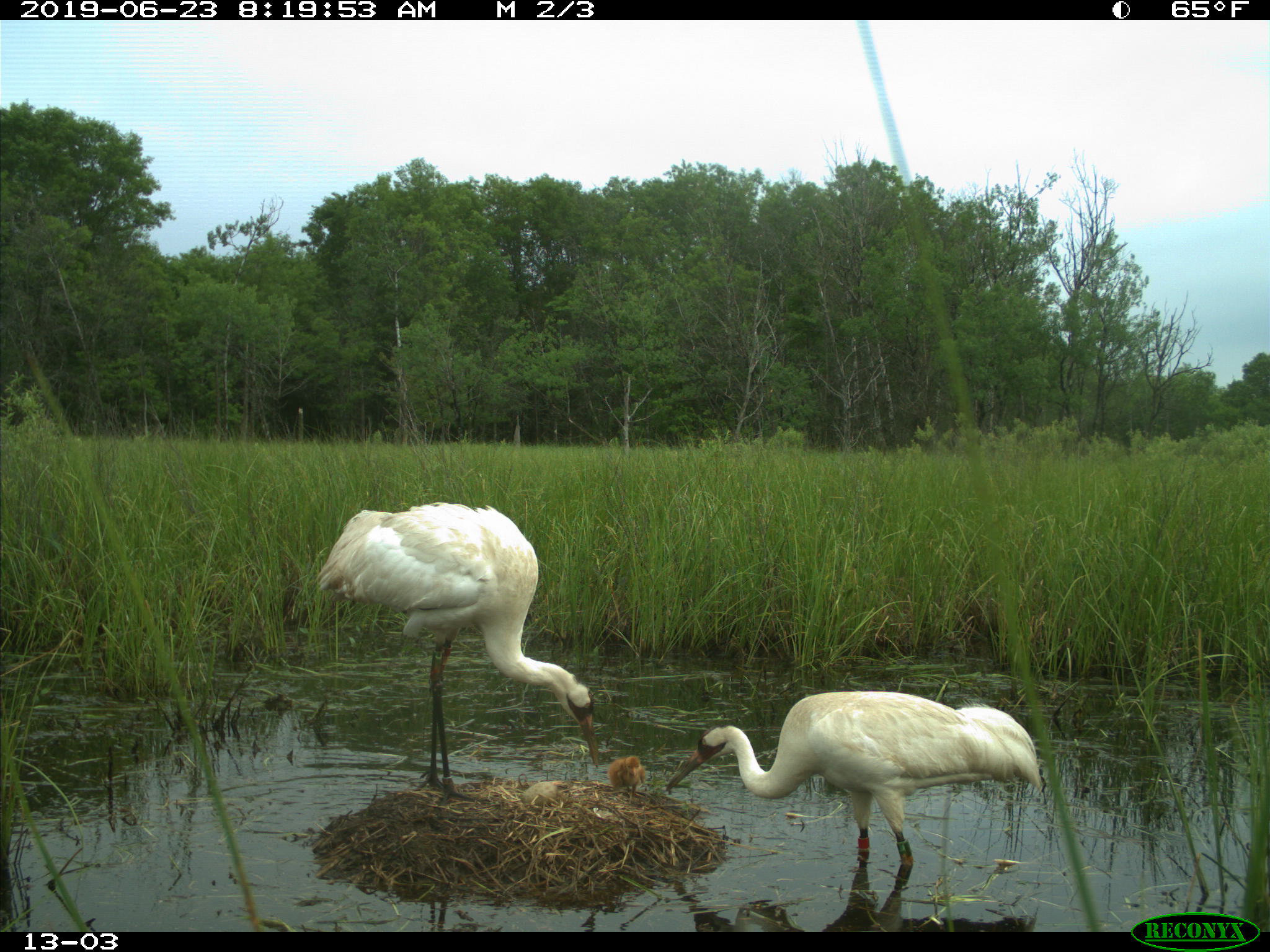
Photo: USFWS
Spring 2020: Looking at the new transmitter data we could see that 13-03 had arrived back at Necedah National Wildlife Refuge on March 27th. They journey up North took about 4 days! Then they began nesting in mid-April and hatched two chicks, W7-20 and W8-20. Sadly, neither of them are still alive. Their chick from last year, W19-19, is still alive and has been seen at Necedah National Wildlife Refuge and seems to be associating with female W3-18 and occasionally male W5-18.
Fall 2020: 13-03 and 9-05 left Necedah NWR in late October and made their way to Goose Pond FWA, Indiana. Their journey took about two days.
Spring 2021: 13–03 and 9–05 migrated north in early March, arriving at their territory in Necedah National Wildlife Refuge, then laid two eggs in late April. Their nest was unsuccessful, but they appeared to be fostering a wayward Sandhill Crane chick for a few weeks in July.
Fall 2021: 13-03 and 9-05 left Necedah NWR in early November. It took them three days to fly from their breeding grounds in WI to their wintering grounds in Greene County, Indiana.
Spring 2022: Sometime in mid-January, 13-03 and 9-05 briefly left their wintering grounds in Greene County, Indiana to spend some time in Jackson County, Alabama. They made their way back to Greene County in February and migrated to their breeding grounds in Necedah National Wildlife Refuge in early April. Eggs from their first nest were collected as part of a forced renesting program, which helps the pair avoid black flies and nest again when black flies are gone. The eggs were sent to Louisiana and hatched in captivity for eventual release back into the wild. During mid-May 13-03 and 9-05 renested and eventually hatched a chick, W11-22!
Fall 2022: Unfortunately, W11-22 was found this summer with a broken wing. The wing was healed in a position that would prevent W11-22 from being able to fly so he was captured and brought to ICF. During fall, 9-05 and his mate 13-03 left their territory at Necedah NWR in early November. They returned to their usual wintering area in Greene County, Indiana.
Spring 2023: After spending some time in Greene County, Indiana, 13-03 and 9-05 briefly left their wintering grounds and flew to Jackson County, Alabama, perhaps in search of some warmer weather! They flew north back to Greene County, Indiana in March. Unfortunately, this pair has not been seen since returning to Wisconsin in March, and we hope they will show up somewhere soon.
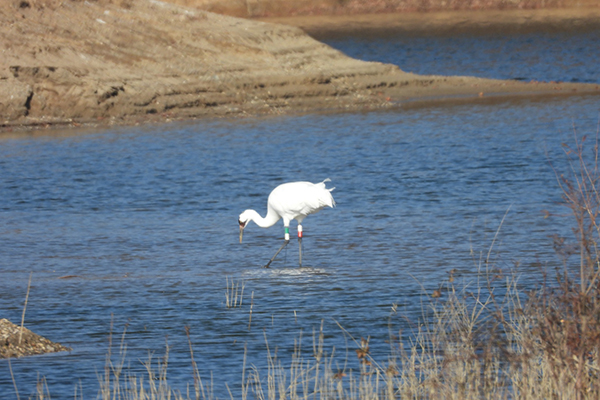
Fall 2023: 9-05 unfortunately has not been seen since March 2023 in Indiana. We hope we will see the pair together again on their breeding territory in Necedah NWR this spring!
Click here to jump to the top of this page.
Crane #10-05
Sex: Female
Hatch Date: May 14, 2005
Personality and Characteristics: Migration Training – She worried the trainers at first because she ate and drank water all the time on her own but didn’t gain weight or stay properly hydrated. Then she got better. Started circle pen training on June 3, same day as #9-05. Arrived in Wisconsin on July 6 with the rest of cohort 2. Chicks #9-05 and #10-05 needed a little extra coaxing to come out of the new pen on their first day of training after they arrived in Wisconsin, but soon improved. She’s a submissive little girl.
On Aug. 5, this cohort had nothing but confusion and chaos during their training session. But on Aug. 6, all of the birds stayed on or really near the runway when they weren’t flying, except for #10-05. The costumed handlers had had to retrieve her from a pool right by the runway, but she came out easily and quickly when the they found her.
The cohort struggled in training for several days. Finally, on September 9, Cohort 2 had a great day. All 8 birds took off from the runway on the first try and never looked back. They flew for about 15 minutes, and stayed with the pilot for the entire flight!
She is a good flyer, but she can have trouble coming in and out of the pen. She is buddies with #12-05.
History
First Migration South: Chick #10-05 left Wisconsin for her first migration on October 14th, 2005. Read day-by-day news about the flock’s migration to see what happens.
Here is more about about Chick #10-05’s first migration:
On Day 5, #10-05 must have wanted a day off from migration. She had to be coaxed out of the pen by Walt, who quickly snuck back into the pen trailer to grab the “swamp monster” cape. With a little help from the scary swamp monster, she charged out of the pen and was soon airborne with Richard and his ultralight!
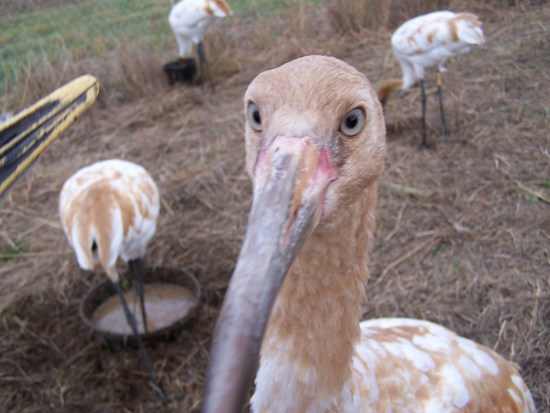
Whooping crane #10-05 and her flockmates at one of the temporary migration stops.
She landed safely with the flock at the temporary holding site at Halpata Preserve in Marion County, FL on December 13. The cranes will be moved to their final release pen in mid-January after all the older cranes have dispersed from the pen site.
On January 10, Crane #10-05 made it to the final pen site at Chassahowitzka NWR on day 2 of the pilots’ attempts to move the flock. The birds slowly became familiar with the idea of again following the ultralight after a month’s vacation. Richard and Brooke managed to get #10-05 and 5 other birds far enough from the pen that they fell into line and followed the 26 miles. HOME for the winter!
Spring 2006: Began first spring migration from the “Chass” pen site March 28 with all flock members except #20-05. This flock of 18 split at roost time on March 28, and fourteen juveniles (#1-05, #2-05, #3-05, #5-05, #6-05, #7-05, #8-05, #9-05, #10-05, #12-05, #14-05, #19-05, #23-05, and #24-05) stayed together. They probably roosted near the confluence of Turner, Crisp and Wilcox Counties in Georgia. They didn’t move the next day. On March 30 they resumed migration and roosted in Hamilton County, TN. The next roosting place was March 31 in Spence County, KY; April 1 in Jefferson County, IN; April 2 and 3 in DuPage County, IL; April 4 in McHenry County, IL. (past Chicago). They are determined to get back to Wisconsin! They flew two days in rain, and in stong headwinds on April 4. On April 5 they resumed migration, stopping in Sauk County, WI—just short of Necedah NWR! Tracker Richard Urbanek was monitoring them the morning of April 6 when they took off. They completed spring migration as they passed the SW corner of Necedah NWR just after noon. (They kept going! They landed, foraged, and roosted that night in nearby Trempealeau County, WI.)
Fall 2006: #10-05 (along with #11-05, #12-05, #19-05 and #7-03) began migration from Wisconsin’s Necedah NWR on November 9 and made it to northern Illinois that night. No further reports until January 2, when they were found in Levy County, FL!
Spring 2007: Began migration from Florida’s Alachua County on March 27 with #11-05 and #12-05. They arrived together at Necedah NWR, on April 1. On July 17 her body was discoverered in a small wet area of an otherwise dry wetland. She was molting and couldn’t fly. Without water to keep predators from reaching her, the flightless crane was killed. Her death was likely around July 7. (Her mate was still in the area, but he often separated from her after she began molting.)
Click here to jump to the top of this page.
Crane #11-05
Sex: Male
Hatch Date: May 16, 2005
Personality and Characteristics: Migration Training – Did well in early circle pen training and walking alone with the trainers. Next, the trainers need to get the chicks into small groups so they get used to being together without fighting. Chicks #11-05 and #12-05 walked together June 2, and trainers had #14-05 join them June 3. Arrived in Wisconsin on July 6 with the rest of cohort 2.
Chick #11-05 is a big bird. He sometimes acts aggressive towards the handlers. He is scared of the adult birds when they appear on the training strip. He acts adversely to them inside or outside the pen.
On September 9, Cohort 2 finally had a great day. All 8 birds took off from the runway on the first try and never looked back. They flew for about 15 minutes, and stayed with the pilot for the entire flight! It was a big relief after several days of struggling and missed flying time that followed the health exams.
By late September, the combined cohort 2-3 was still figuring out a social structure. Normally submissive Chick #11-05 was getting mean. He began attacking the costumes with a vengeance! On Sep. 20, pilots tried to fly all 20 birds together for the first time. Sixteen flew with the trike for about ten minutes, but #11-05 (along with #19-05, #20-05, and #24-05) were the stragglers and they came back to the runway.
This bird has been getting more aggressive. Mark Nipper says #11-05 “hates most of us,” and #11-05 really picked on Charlie Shafer, the “new kid,” when Charlie arrived to join the ground crew in October.
History
First Migration South: Chick #11-05 left Wisconsin for his first migration on October 14th, 2005. Read day-by-day news about the flock’s migration to see what happens. Here is more news about Chick #11-05:
Nov. 30 he wouldn’t follow the ultralight. He kept turning back to Hiwassee with a small group of other cranes who didn’t want to leave the nice marshes at Hiwassee. He was put in a crate and driven to the next stopover site. After that day, he followed the ultralight just fine. He landed safely with the flock at the temporary holding site at Halpata Preserve in Marion County, FL on December 13. The cranes will be moved to their final release pen in mid-January after all the older cranes have dispersed from the pen site.
On January 10, Crane #11-05 made it to the final pen site at Chassahowitzka NWR on day 2 of the pilots’ attempts to move the flock. The birds slowly became familiar with the idea of again following the ultralight after a month’s vacation. Richard and Brooke managed to get #11-05 and 5 other birds far enough from the pen that they fell into line and followed the 26 miles. HOME for the winter!
Spring 2006: Began first spring migration from the “Chass” pen site March 28 with all flock members except #20-05. The flock split, with #11-05 and #21-05 staying in Turner County, GA on March 28. The two were last recorded there on March 30. Trackers had to leave these two birds behind in order to track the others. At 4:00 PM April 19, the radio signals #11-05 and #21-05 were detected over Necedah NWR. They had just completed their first spring migration!
Fall 2006: #11-05 (along with #10-05, #12-05, #19-05 and #7-03) began migration from Wisconsin’s Necedah NW on November 9 and made it to northern Illinois that night. No further reports until January 2, when they were found in Levy County, FL!
Spring 2007: Began migration from Florida’s Alachua County on March 27 with #10-05 and #12-05. They arrived together at Necedah NWR, on April 1.
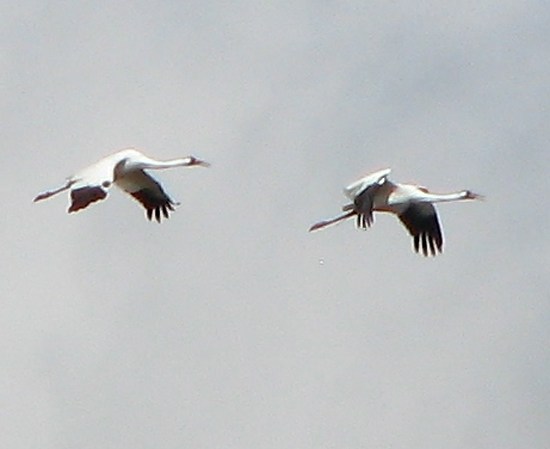
11-05 and 16-03 in flight. Photo: Eva Szyszkoski
Fall 2007: #11-05 began migration from Wisconsin on November 21 along with #7-03, #2-04, #12-04, #14-05, and #W1-06 (the flock’s only wild-hatched chick so far). Cranes #11-05 #14-05 and #W1-06 safely arrived in Hernando County, Florida, on December 2. Later #11-05 was with #16-03 in Marion County, FL.
Spring 2008: The pair #11-05 and #16-03 began migration from Marion County, Florida, on February 24, 25, or 26. Confirmed back on Necedah NWR on March 28.
Fall 2008: In October, 2008, tracker Eva reported that #11-05 and DAR #46-07 have been hanging out together for a while now. She saw them unison calling one day! Eva took the pictures from a distance. She was very happy that that this DAR female seems to have found a male friend and hopes the female will follow #11-05 to Florida this fall. “Male #11-05 used to hang around Site 3 on the refuge last year when I was a DAR intern,” said Eva. “He was always one of our favorite birds to see there because he was so mellow, and he enjoyed being around the costumes and the chicks.”
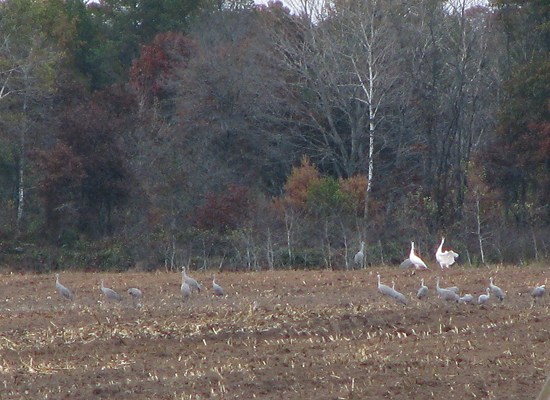
Photo Eva Szyszkoski, WCEP Tracking Team
Left Wisconsin on Nov. 20 in a large group. Not all of them stayed together, but on Nov. 24, crane #11-05 was in a group of eight (including #10-08, who was removed from the ultralight cohort) that reached the border of southern Illinois and southern Indiana. The group stayed together in Gibson County, Indiana until Dec. 21, when they moved to White County, Tennessee. On Dec. 22 he resumed migration from White County, TN and arrived in Cherokee County, Alabama with #12-05, #16-07, #24-07, DAR #46-07 and DAR#37-08. Completed migration sometime Dec. 28-31, where he was at Paynes Prairie Preserve State Park in Alachua County, Florida. With him were first-timers #10-08 and DAR 37-08 and #12-05, #16-07 and #24-07.
Spring 2009: #11-05 (with #16-07 and #24-07) began migration from Alachua County, Florida on March 10. Migration stops were March 12 at Cherokee County, AL; March 16 at Coffee County, Tennessee; March 18-20 at Knox County, Indiana; and March 21 at DeKalb County, Illinois. The birds apparently completed migration to Necedah NWR on 22 March. Male #11-05 was last detected on Necedah NWR on May 11, 2009.
Click here to jump to the top of this page.
Crane #12-05
Sex: Male
Hatch Date: May 16, 2005
Migration Training: This chick is small, feisty and mischievous. Arrived in Wisconsin on July 6 with the rest of Cohort 2. Trainer Mark Nipper said, “This little guy is only half the size of #8-05, but is all attitude. He seems to particularly enjoy running around and biting all the other birds’ butts. He looks odd but proud when he stands tall with a mouth full of fluffy tail feathers from his bullying.” In fact, Chick #12-05 seems to be the most dominant and aggressive bird of Cohort 2. He chases and pecks any bird that dares get near him. Chicks #11-05 and #14-05 are favorite targets.
By July 21, all the Cohort 2 birds followed the trike well. One of the birds even got off the ground for about 50-60 feet. Chicks #12-05 and #14-05 are the bullies, often pounding on the other chicks in their eagerness to exit the pen when the gates are opened for training. By August 1, #12-05 was airborne but not quite climbing high.
On Aug. 5 pilot Brooke decided that he was going to take off from the ground and see how many of the chicks would follow him for a few laps around the pen and runway areas. The birds scattered almost as soon as they were let out of the pen. Brooke quickly found one chick–#12-05–stuck on the other side of a water ditch. The chick was confused by how to get back to the runway. John Thomton stood on the opposite bank of the ditch and motioned for #12-05 to follow, but he wouldn’t come! The chick may have been intimidated by two adult whooping cranes on John’s side of the water. Still, #12-05 refused to walk across the shallow water to John—very strange, since #12-05 practically lives in the wet side of his pen! Eventually, John had to wade over to the bird, flooding his boots and soaking his pants and white costume. No amount of coaxing could get #12-05 into the water. John said, “He didn’t even take any of the yummy grapes I offered as motivation for crossing the ditch.” Finally, Brooke landed his trike and came over. Brooke and John kept walking the long way around because today #12-05 apparently didn’t want his feet wet! As the three costumed handlers neared the pen with #12-05, the bird saw Brooke’s trike parked WAY down on the other side of the runway—and took off flying towards it! The trainers had to keep silent, but they wanted to scream with frustration. Finally, Brooke walked down there and taxied the trike back over to the pen. After an hour, #12-05 followed and the episode was finally over.
On August 28, the first day Cohort 2 and Cohort 3 birds were at the same pen site, #12-05 went through a gap in the fence that divided the two cohorts. He was stuck with the younger birds in their pen while his own cohort was let out for training with the ultralight. Both groups were let out to mix with each other for the first time later that day. What did #12-05 do? He took off alone and flew in a big circle, landing back on the grass runway with the group!
After the health exams, #12-05 started struggling to keep up with the group. He would often fly back to the runway and miss out on over half the training flight. But on September 9, Cohort 2 had a great day. All 8 birds took off from the runway on the first try and never looked back. They flew for about 15 minutes, and stayed with the pilot for the entire flight.
He is about mid-level in dominance, and a good flyer. He can be a character. He often ignores costumed handlers and refuses to go back into the pen after training.
History
First Migration South: Chick #12-05 left Wisconsin for his first migration on October 14th, 2005. Read day-by-day news about the flock’s migration to see what happens.
Here’s extra news about Chick #12-05’s first migration:
On day 2 of the migration, #12-05 (and #7-05) turned back to the launch area. They were crated and traveled by van to the new stopover site in Juneau County (17.1 miles). Again on Nov. 30 he wouldn’t follow the ultralight. He kept turning back to Hiwassee with a small group of other cranes who didn’t want to leave the nice marshes at Hiwassee. He was put in a crate and driven to the next stopover site. After that day, he followed the ultralight just fine.
On Dec. 13, #12-05 landed safely with the 19-bird flock at the holding pen at Halpata Preserve. The cranes will be moved 26 miles to their final release pen at Chassahowitzka NWR (“Chass”) in mid-January after all the older cranes have dispersed from the release pen.
The pilots and ultralights tried to move the birds on January 9. Crane #12-05 made it to Chass on the third day of trying, January 11. HOME for the winter!
Spring 2006: Began first spring migration from the “Chass” pen site March 28 with all flock members except #20-05. This flock of 18 split at roost time on March 28, and fourteen juveniles (#1-05, #2-05, #3-05, #5-05, #6-05, #7-05, #8-05, #9-05, #10-05, #12-05, #14-05, #19-05, #23-05, and #24-05) stayed together. They probably roosted near the confluence of Turner, Crisp and Wilcox Counties in Georgia. They didn’t move the next day. On March 30 they resumed migration and roosted in Hamilton County, TN. The next roosting place was March 31 in Spence County, KY; April 1 in Jefferson County, IN; April 2 and 3 in DuPage County, IL; April 4 in McHenry County, IL. (past Chicago). They are determined to get back to Wisconsin! They flew two days in rain, and in stong headwinds on April 4. On April 5 they resumed migration, stopping in Sauk County, WI—just short of Necedah NWR! Tracker Richard Urbanek was monitoring them the morning of April 6 when they took off. They completed spring migration as they passed the SW corner of Necedah NWR just after noon. (They kept going! They landed, foraged, and roosted that night in nearby Trempealeau County, WI. and hung around the core reintroduction area all summer.)
Fall 2006: #12-05 (along with #10-05, #11-05, #19-05 and #7-03) began migration from Wisconsin’s Necedah NWR on November 9 and made it to northern Illinois that night. No further reports until January 2, when they were found in Levy County, FL!
Spring 2007: Began migration from Florida’s Alachua County on March 27 with #10-05 and #11-05. They arrived together at Necedah NWR, on April 1.
Fall 2007: Left Wisconsin on migration on November 27 with #5-05. They migrated together at least as far as central Indiana on November 27. (Crane #5-05 was found without #12-05 at Hiwassee WR in Tennessee on December 1.) Crane #12-05 (along with #8-04 and #19-05) completed migration and arrived in Florida on December 4.
Spring 2008: Male #12-05 (with #7-03) was confirmed back in Wisconsin at Necedah NWR on March 23. He and #7-03 were reported together in Houston County, Minnesota, on March 14 and 15! Both birds may have wintered together at an undetermined location in Florida. This was the first time #12-05’s signal had been detected since December 29 (in Florida).
Fall 2008: Left Wisconsin on Nov. 20 in a large group. Not all of them stayed together, but on Nov. 24, crane #12-05 was in a group of eight (including #10-08, who was removed from the ultralight cohort) that reached the border of southern Illinois and southern Indiana. The group stayed together in Gibson County, Indiana until Dec. 21, when they moved to White County, Tennessee. On Dec. 22 he resumed migration from White County, TN and arrived in Cherokee County, Alabama with #11-05, #16-07, #24-07, DAR #46-07 and DAR #37-08. Completed migration sometime Dec. 28-31, where he was at Paynes Prairie Preserve State Park in Alachua County, Florida. With him were first-timers #10-08 and DAR #37-08 and #11-05, #16-07 and #24-07.
Spring 2009: #12-05 separated from DAR #37-08 and began migration from Paynes Prairie Preserve State Park by March 25. Confirmed back in Wisconsin at Necedah NWR by early April. He was detected near Sprague Pool on April 4 and 5. (His transmitter was again functioning after failing to produce a signal during the final weeks in Florida.)
Fall 2009: He was captured on October 28 to replace his transmitter, and then released. He began migration Nov. 26 with #22-07 and several other Whooping cranes that migrated as a group before landing to roost at an undetermined location(s) in Illinois. He and #22-07, now traveling just with #16-02, #16-07 and DAR #38-09 were next located by aerial survey while flying over Clark County, Illinois, on Nov. 27. They landed to roost in Lawrence County, Illinois, and continued about 20 miles SE to Knox County, Indiana, on November 28. They were still there Feb. 6.
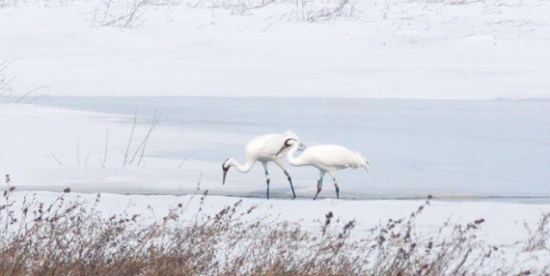
Spring 2010: Crane pair #16-02, #16-07, pair #12-05/#22-07, and #38-09 (DAR) remained along the Wabash River, in Knox County, Indiana until they began migration on March 17. A low precision PTT reading for #22-07 indicated a roost location in Dane County, Wisconsin, on the night of March 20. Female #22-07 was detected back on Necedah NWR on March 22. Male #12-05 was not reported until 24 March, but both were likely together on March 22.
Fall 2010: Crane names hereafter follow the naming conventions of WCEP: Crane #12-05 and mate #22-07 were reported in Gibson County, Indiana, on December 9. They arrived at Paynes Prairie Preserve SP, Alachua County, Florida, by December 30.
Spring 2011: Crane pair #12-05 and #22-07 were on their winter territory in Alachua County, FL when checked on February 24 but they were no longer detected during a check on the afternoon of March 1. Reported back at Necedah NWR by March 21. They had two nesting attempts this summer, begun on April 20 and again on May 18. The second nest failed May 22nd when a tornado passed through. The nest was found abandoned the next day and no eggs or shell fragments were found.
Fall 2011: Crane #12-05 and mate #22-07 migrated to Gibson County, Indiana, for the winter.
Spring 2012: Crane #12-05 and mate #22-07 were detected in flight March 16 south of Necedah NWR and headed north. They’re back! They were on a nest as of April 4. That nest failed on April 26 but they were incubating on nest #2 by May 21. These eggs were due to hatch June 17-19, but the nest had failed by June 15.
Fall 2012: On Nov. 21 male #12-05 and mate #22-07 were discovered in Gibson County, Indiana, where they remained throughout the winter. Also present there were pair #16-02, #16-07 and males #19-09 and #25-10 DAR.
Spring 2013: Crane #12-05 and mate #22-07 completed spring migration on March 30. By late April or early May they were reported nesting but the nest failed, along with nests of many other crane pairs, during a black fly outbreak in early May. The pair did not re-nest this summer.
Fall 2013: Male #12-05 migrated to Knox County, Indiana, apparently re-paired with female #7-09, and they remain there as of January 31.
Spring 2014: Crane #12-05, who joined up on migration with female #7-09 during the winter on the Knox County, Indiana territory she had shared with her now-missing mate, had not yet been confirmed back at Necedah NWR when #7-09 got back March 28. He has a nonfunctional transmitter and remote territory, and is probably no longer with female #7-09 because she was seen with other males, said tracker Eva Szyszkoski. By early May, Eva thought #12-05 was probably paired with #12-03. Sure enough, the pair was later observed with a nest. However, they abandoned their nest (with two eggs) sometime in May.
Fall 2014: Male #12-05 and mate #12-03 likely departed Necedah on Oct. 31 and migrated south. They wintered in Knox County, Indiana, where this photo was taken by Mark Crowley on February 25, 2015:
Whooping crane pair #12-05 and 12-03 in Knox Co., IN. Photo: Mark Crowley
Spring 2015: Male #12-05 arrived back at Necedah by March 30 with female #12-03.
Fall 2015: Male #12-05 (with Female#12-03) was was confirmed in Knox County, Indiana by November 13.
Spring 2016: Male #12-05 migrated back to Necedah NWR and was mostly by himself until summer, when he started associating with female #19-14.
Fall 2016: Male #12-05 was reported with female PR #19-14 in Gibson County, IN in November and then Knox County, Indiana in December.
Spring 2017: Male #12-05 migrated back to Juneau County, Wisconsin with mate PR #19-14. The pair built a nest together, but the nest failed.
Fall 2017: 12-05 and 19-14 migrated to 12-05’s typical wintering ground in Knox County, Indiana. They were first sighted there November 10.
Spring 2018: 12-05 and 19-14 were photographed together in southern Illinois while migrating back to Wisconsin, but 12-05 was seen alone during the summer. He did not nest this year.
Fall 2018: In late October, 12-05 was seen in Knox County, Indiana with female 12-03. These birds have been together before- maybe they’ll stay together and nest this time!
Spring 2019: 12-05 and mate 12-03 had returned to their territory at Necedah National Wildlife Refuge by mid-April
12-05 and 12-03 were first seen sitting on a nest April 16 by pilot Bev Paulan, but the eggs were removed on April 20 as part of the forced renesting program.
On May 4, Bev saw them sitting on a renest. In early June, chick W14-19 hatched!The chick was banded, and blood tests revealed she was a girl. W14-19 fledged at the end of August.
Fall 2019: 12-03 and mate 12-05 were together for the summer on their territory at Necedah National Wildlife Refuge. They migrated south with their chick W14-19 and arrived on their wintering grounds in Knox County, Indiana mid-November. They remained here for the winter until the end of March.
Spring 2020: 12-03 and 12-05 were first observed back at Necedah National Wildlife Refuge at the end of May with a new chick, W14-20! As of July, the chick is still alive.
Fall 2020:12-03 and 12-05 fledged a chick in 2019 and now another in 2020, W14-20. They are on a roll! W14-20 fledged at the beginning of August. She and her parents left Necedah NWR, WI in late October. They were seen in Winnebago County, IL on their way down to their normal wintering spot in Knox County, IN.
Spring 2021:12–03 and 12–05 migrated north in early March. Once at Necedah National Wildlife Refuge, they got right to work and were incubating by mid-April. Their nest was successful and W10–21 is doing well as of July 2021!
Fall 2021: This fall and summer 12-03, 12-05, and chick W10-21 were hiding out deep in the marshes of Necedah NWR. The family was last spotted in Wisconsin on August 19th. Despite numerous efforts to locate the family, they weren’t seen again until they migrated to Knox County, Indiana in early November. Unfortunately, the pair arrived on their wintering grounds without W10-21.
Spring 2022: 12-03 and 12-05 began migrating north in mid-March and were spotted back at Necedah National Wildlife Refuge in early April. They were seen incubating in mid-April. Eggs from this nest were collected as part of the forced renesting program, which helps the pair avoid black flies and nest again when black flies are gone. The pair sat full term on their second nest, but unfortunately the egg did not hatch.
Fall 2022: 12-03 and 12-05 spent the summer on their territory at Necedah NWR and migrated south during mid-October. They arrived on their usual wintering grounds in Knox County, Indiana one day after leaving Wisconsin.
Spring 2023: 12-05 and 12-03 migrated from their wintering grounds in Knox County, Indiana, to their territory in Necedah National Wildlife Refuge in late March and were spotted with a nest. The eggs in their first nest were collected as part of a forced renesting program to help nesting pairs avoid biting black flies and renest when the black flies are gone. Both eggs from their first nest were sent to the reintroduced Whooping Crane population in Louisiana. After the pair renested, they laid two eggs, and one was collected for our captive rearing and release program. Given that Whooping Cranes typically raise one chick a year, this allows us to further increase the number of Whooping Cranes entering the population in one season. The egg collected from their second nest hatched at ICF and will be released back into the Eastern Migratory Population!
Fall 2023: 12-05 and 12-03 spent the summer on their territory in Necedah NWR and began their migration in mid-October. The two made it to their typical wintering grounds in Knox County, where they have been foraging and exploring their familiar grounds ever since.
Click here to jump to the top of this page.
Crane #14-05
Sex: Male
Hatch Date: May 19, 2005
Personality and Characteristics: Migration Training – Started out as a pretty small chick but is active and seems fine. He was beat up by #13-05 on May 28. He is a very scared little bird pretty much all of the time. This chick had a broken toe and then later cracked some ribs in a fall, so it missed training and socializing sessions for a whole week. He stayed back in Maryland when cohort 2 was shipped to Wisconsin so he could recover from injuries. Chick #14-05 arrived in Wisconsin on July 13 with the chicks in the youngest group, cohort 3. Then both #8-05 and #14-05 were reunited with their old cohort 2, now at their new summer home on Necedah NWR. The two chicks fared well on the journey and began to drink and eat upon entering their new pen with their old cohort. #14-05 has a very crooked toe but runs and jumps right along with the rest of them.
By July 21 he trained without any trouble or sign of a limp. All the cohort 2 birds followed the trike well, and one of the birds even got off the ground for about 50-60 feet. However, pilots couldn’t tell exactly which bird flew because all of the chicks’ uniquely colored and numbered leg bands are now all caked with mud!
On August 28, Cohort 2 joined the younger Cohort 3 birds to live at the same pen site. When both groups were let out to mix with each other for the first time, #14-05 and #24-05 chased and bit each other. They jump-raked each other too (jumped into the air and kicked out at each other with their sharp claws). The handlers said they behaved” like jerks” towards the other birds.
After several days of struggling after the health checks, Cohort 2 finally had a great flying day on Sept. 9. All 8 birds took off from the runway on the first try and never looked back. They flew for about 15 minutes, and stayed with the pilot for the entire flight!
On September 15, the combined cohorts 2 and 3 took their first training flight together! Chick #14-05 is Number One in dominance. This aggressive bird is IN CHARGE of all the other birds. He follows the handlers and trikes really well, but he can be hard on the other birds.
History
First Migration South: Chick #14-05 left Wisconsin for his first migration on October 14th, 2005. Read day-by-day news about the flock’s migration to see what happens.
Chick #14-05 landed safely with the flock at the temporary holding site at Halpata Preserve in Marion County, FL on December 13. The cranes will be moved to their final release pen in mid-January after all the older cranes have dispersed from the pen site.
On January 10, #14-05 made it to the final pen site at Chassahowitzka NWR on day 2 of the pilots’ attempts to move the flock. On the second day of trying, the birds slowly became familiar with the idea of again following the ultralight after a month’s vacation. Richard and Brooke managed to get #14-05 and 5 other birds far enough from the pen that they fell into line and followed the 26 miles. HOME for the winter!
Spring 2006: Began first spring migration from the “Chass” pen site March 28 with all flock members except #20-05. This flock of 18 split at roost time on March 28, and fourteen juveniles (#1-05, #2-05, #3-05, #5-05, #6-05, #7-05, #8-05, #9-05, #10-05, #12-05, #14-05, #19-05, #23-05, and #24-05) stayed together. They probably roosted near the confluence of Turner, Crisp and Wilcox Counties in Georgia. They didn’t move the next day. On March 30 they resumed migration and roosted in Hamilton County, TN. The next roosting place was March 31 in Spence County, KY; April 1 in Jefferson County, IN; April 2 and 3 in DuPage County, IL; April 4 in McHenry County, IL. (past Chicago). They are determined to get back to Wisconsin! They flew two days in rain, and in strong headwinds on April 4. On April 5 they resumed migration, stopping in Sauk County, WI—just short of Necedah NWR! Tracker Richard Urbanek was monitoring them the morning of April 6 when they took off. They completed spring migration as they passed the SW corner of Necedah NWR just after noon. (They kept going! They landed, foraged, and roosted that night in nearby Trempealeau County, WI.) Spent summer in the core reintroduction area.
Fall 2006: He began migration (together with female #21-05) on Nov. 11. By Dec. 5, #14-05 was reported in Florida with other sub-adults in Pasco County. He wandered with them in normal behavior.
Spring 2007: Began migration March 19 (with #8-04 and #1-05). They arrived together at Necedah NWR on March 29.
Fall 2007: #14-05 began migration from Wisconsin on November 21 along with #11-05, #7-03, #2-04, #12-04, and #W1-06 (the flock’s only wild-hatched chick so far). Cranes #11-05 #14-05 and #W1-06 were reported safely arrived in Hernando County, Florida, on December 2. He was found with #8-04 and #19-05 in Hillsborough County, FL on Dec. 19.
Spring 2008: After wintering south of Tampa, #14-05, #19-05 and #8-04 were the first cranes to begin their journey north on February 26. A March 18 report of three whooping cranes in Morrison County, Minnesota, may have been these birds.
Fall 2008: Migrated from Wisconsin in a group of other whoopers that reached Alachua County, Florida by Dec. 31/January 1.
Spring 2009: Cranes #7-03, #8-04, and #14-05 began migration from Alachua County, Florida, on March 5 or 6. Reported in Greene County, Indiana during March 9-15. Confirmed at Necedah NWR in Wisconsin on March 19!
Fall 2009: Began migration with male #12-07 on November 15, a day with clear skies and north winds to help push them south. Amazingly, they met up with a pair (#1-04 and #8-05) and another single crane (#29-08) at the same location in Winnebago County, Illinois! All three “groups” had started out from three different locations. He completed migration to his previous wintering area in Florida’s Alachua County.
Spring 2010: Male #14-05 began migration from his Florida winter territory between March 5 and March 16. He was reported in flight over Indiana Dunes State Park, Porter County, Indiana, on April 12. He was last observed on Necedah NWR in May 2010.
Click here to jump to the top of this page.
Crane #16-05
Sex: Male
Hatch Date: May 28, 2005
Personality and Characteristics: Migration Training – Very young and small and cute and clingy at Patuxent. Follows right under the costume or as close to the trike as possible. Screams constantly if not near one of them. During training, he tried to get over the fence to get to the trike.
Arrived in Wisconsin on July 6 with the rest of cohort 2. All behaved as though they had been raised there, and looked very healthy. By July 9, #16-05 and all the other cohort 2 chicks were following well and running after the trike with great enthusiasm. “In fact,” said Mark, “#16-05 is so keen that we think he wants to fly the trike. He continually hugs up next to the trike, almost getting in the way.” By July 21, all the cohort 2 birds followed the trike well, and one of the birds even got off the ground for about 50-60 feet. However, it was hard to tell exactly which bird flew because all of the chicks’ uniquely colored and numbered leg bands are so covered with caked-on mud!
On September 9, Cohort 2 finally had a great day. All 8 birds took off from the runway on the first try and never looked back. They flew for about 15 minutes, and stayed with the pilot for the entire flight! What a relief after several days of struggling after the recent health checks.
Chick #16-05 is much less clingy than he used to be. He’s going the opposite way now, gaining independence. He blends in instead of standing out like he used to. He’s a very good flyer and follows well. He is mid-level in dominance.
History
First Migration South: Chick #16-05 left Wisconsin for his first migration on October 14th, 2005. Read day-by-day news about the flock’s migration to see what happens.
Here is more news about Crane #16-05’s first migration:
The team has watched #16-05 closely since before migration began. First they noticed a small fracture in his bill. On Day 1 of migration, he did not leave the refuge; he came back to the pen with a limp and swollen foot. (This same foot had been swollen a couple months ago.)
On Day 5 (Oct. 18), #16-05 took off with 18 other birds behind Brooke’s plane. But ten minutes later, he got caught in the wires on top of the ultralight. Brooke landed immediately with #16-05 in a cow pasture. The other pilots quickly took over and led the other birds onward to the new landing site in Green County, WI. Brooke examined #16-05 and decided that the bird was able to continue flying, despite a scratched leg. He took off again with #16-05, but landed in another field when the bird lagged behind. Then something spooked #16-05 and he took off again! Brooke took to the air and led #16-05 to a harvested soybean field. Charlie caught up to Brooke and #16-05 resting in this field, and #16-05 finished this leg of the migration stuck in a box on a long, bumpy ride in a motor home. Mark pointed out this isn’t a small list of troubles, even for the most hardy birds. “Through all of these misfortunes he may have walked a little funny over to the pen, but he was still the feisty little bird he always has been. This morning [Oct. 19] the little guy looks even better still, and we are all encouraged by his quick recovery.” But when they next flew (Oct. 23, day 10), #16-05 did not want to fly. He finally took off with Brooke but broke away after only a minute. The young bird landed in a field and would not be coaxed back up. Joe said, “It may still have been sore–or maybe it just recognized Brooke!” He didn’t fly the next time, day 13, either.
By Oct 27 (day 14), #16-05 still was hesitant. Angie arranged for Dr. Barry Hartup to X-ray the bird to see the condition of the wing. By Oct. 31, Angie reports: “For physical therapy, we have been putting a warm compress on his right carpal joint for about five minutes, then work his wing on passive range of motion exercises until his joint loosens up. During his exercise sessions, we let him out of the pen by himself and run with him to encourage him to fly near the pen. At first he seemed a little awkward and was reluctant to extend his wing fully, but On Oct. 31 he flew about 100 yards or so 6 or 7 times and looked great. The crew is very encouraged by his willingness to fly, at least around the pen, and we are going to encourage him to fly with the rest of the group on our next leg of the journey once the wind dies down. For the last 5 legs he has made all or most of the journey in a crate, and we hope that he will soon have the strength and the stamina to keep up with the other birds.”
November 30: #16-05 refused to take off with the flock when they left Hiwassee Wildlife Refuge. He just landed in the field next to the pen because the swamp monsters were out (trying to scare the birds into taking off with the ultralight). He and five other reluctant cranes were crated and driven to the next stop.
December 13, arrival day! Chick #16-05 was the one bird who landed early–in a field near the Dunnellon Municipal Airport. He was crated and driven the short distance to the temporary drop-off site at Halpata Preserve.
In the month at Halpata Preserve, the birds were let out of the top-netted pen to exercise their wings. But #16-05 worried the aviculturalists. He either couldn’t (or wouldn’t) fly.
The cranes will be moved 26 miles to their final release pen at Chassahowitzka NWR (“Chass”) in mid-January after all the older cranes have dispersed from the pen site.
January 9, 2006: Crane #16-05 didn’t fly with the ultralights on the first day of the move. On the second day of trying (January 10), #16-05 flew but then dropped out. The good news is that he is flying again. The pilots tried again on January 11 to get the remaining cranes over to Chass. All the rest of the birds EXCEPT #16-05 made it to Chass on the third day of trying: January 11.
January 12: “#16-05 did not much want to fly this morning,” said Mark Nipper. “We went out to the Halpata pensite with all three pilots and an army of swamp monsters. Richard lined up in front of the pen and Sara opened the panels. #16-05 didn’t want to come out on his own so Sara had to herd him out. He did take off behind Richard but then quickly turned away. He headed right for the little spot that he has been landing in for the last few days. But today we were already there with a swamp monster, so he kept flying. But rather than climb over the trees with the planes, he flew through the tops of the trees instead, and landed in a clearing right on the other side. It was pretty scary watching him weave through the branches, not gaining altitude but actually descending. When Sara and I rounded him up, he followed us back to the pen and went right in. He seems happy as can be in there. We will be discussing the situation with the vets and hoping that this bird will still be able to join the flock.” He remains in the top-netted pen until doctors decide on a plan for him.
January 18: Team member and crane monitor Mark Nipper reports: “We went to Halpata to let #16-05 out for some exercise. He was excited to get out of the pen and while he took a few short flights, he wasn’t able to fly very high or far, and he looked uncoordinated. It was still rather gusty though, so maybe it was good that he flew at all. We will be moving #16-05 out to the Chass pen in the next few days. Hopefully, the change of setting, and being back with his buddies will encourage him to fly.”
January 20: #16-05 went to Chass and rejoined the flock. Mark Nipper reports: “We got #16-05 in the crate just before dawn Thursday morning. Traffic was light, so we made it to the boat launch in good time. Once the crated bird was in the boat everything went pretty well. We had to go slowly, and even had to get out and push/pull the boat through a few shallow areas, but it was a smooth and quiet ride. . . At the Chass pen site, #16-05 came out of the box just fine and looked good on the walk to the pen. He followed us to the pen just fine, and went right in. He has always been a good follower, and easy to get in and out of gates. He looked good in the pen, and none of the other birds seemed too concerned about him.”
“A few days later, the top net was removed and the birds were free. Happily, #16-05 (and others) took off and flew circles around the new area. He looked good in the air! He then attempted to come in for a landing in the pen…..but on the part of the pen that still had some net on top. Oops. When he realized there was something in the way, it looked like he tried to power back, but he just couldn’t. As a result, he landed on the top-netting and Mark and Sara had to struggle to get him off.” Mark said he seemed fine when they finally got him off. He followed them easily back into the covered pen and then out into the big pen with the open top.
March 12: GREAT NEWS! Mark said, “#16-05 has made marked improvement over the last month. He definitely has the willingness to fly and stay with the group. It is usually hard to spot him in the air now because he is right in with the flock.”
Spring 2006: Began migration March 28 in the flock of 18 that left that day. They made it to Turner County, Georgia, but other flock members took off shortly after landing. Only cranes #16-05 and #22-05 stayed at this first stop to roost. Despite his earlier wing problems, #16-05 is doing great! He and #22-05 were in Meigs County, TN on Mar. 30 and 31. They migrated to Floyd County, IN on April 1. Location unknown April 2 and 3. On April 4 they resumed migration. They were hampered and blown eastward by a strong northwest wind and landed to roost in Decatur County, Indiana at least to May 5. On May 12-13, #16-05 was reported from a yard and hayfield in Eaton County, MICHIGAN. He was alone. Because of injury, #16-05 missed a significant portion of the northern part of the ultralight-led migration in autumn 2005. Separated from #22-05, he is unlikely to complete migration to Wisconsin on his own. Thus, on May 16, the crane team and a small private plane retrieved him from a flooded backyard and brought him home to Wisconsin. Migration complete! By mid-June his limp was barely noticeable. He moved to Dane County, WI (outside the core reintroduction area) for most of the summer.
Fall 2006: #16-05 left Wisconsin on Nov. 19 with #16-02 and #32-05 (DAR) and made it that night to to SE Indiana. After migrating 5 days in a row, he landed at the Florida pen site at 4:37 pm on November 23!
Spring 2007: Began migration from Marion County, FL between April 21 and 29. (He tied with #9-05 for the record of staying the latest in Florida before beginning spring migration!) He was reported May 14 in Ohio and June 4 in Michigan, where he remained all summer with Sandhill cranes on farmlands and a sanctuary in Jackson County.
Fall 2007: Migrated from Michigan after November 19 back to Marion County, Florida.
Spring 2008: Wow! He was not reported on his usual summering area in Jackson County, Michigan until July 5. He stayed in Levy County, Florida (about 30 miles north of his wintering area in Marion County) at least until June 24. This bird was tied with #9-05 for the latest spring departure from Florida, when in 2007 they both initiated spring migration between April 22-28. This year #16-05 smashed that record and everyone was starting to wonder if he would migrate at all. He showed up for summer in Michigan with sandhill cranes.
Fall 2008: He continued to be reported with sandhill cranes NE of Jackson County, Michigan into mid November. But he migrated south, and was confirmed on his usual wintering area in Marion County, Florida, on December 22. Trackers suspect his transmitter failed after that. He was not observed in any of his usual areas during search flights on January 20, February 4 or March 4.
16-05 was last seen in Florida in December 2008.
Click here to jump to the top of this page.
Crane #19-05
Sex: Female
Hatch Date: May 30, 2005
Personality and Characteristics: Migration Training – During their first weeks, #19-05, #21-05, #22-05, and #23-05 trained well together at the circle pen. “These guys are hilarious,” reported trainer Mark Nipper at Patuxent WRC. “They run in a tight little bunch in the circle. They are constantly knocking into each other and a couple of them really compete to be the closest to the trike. After a few minutes, they will start getting tired and hot, or just lazy, and break up a little.

19-05 training with the trike in the circlepen.
There is usually a bird in every group that will linger behind and forage on its own. For a long time, I thought that #19-05 was that bird. Lately, however, each bird has been taking a turn at this “lagging” behavior.” On July 10, Mark said, “Lately #19-05 has decided it doesn’t like me and is trying to beat me up all the time. Today we have had a breakthrough with these chicks out at the pond. We have not been able to leave the pen without them becoming highly stressed and pacing along the fences. This leads to banged up faces and raw spots on the body from rubbing. The birds will stick their heads through the fence if they can. All of this is pretty common for a while, but these guys seem particularly clingy. What we trainers usually do is take turns sitting in the pen with them. It is really pretty fun to hang out with the birds and just let them do their own thing in the water. They usually take baths and are running around all over the place trying to catch everything that moves. It is very important, though, that they be able to spend time away from us. Once we’re all moved to the reintroduction site at Necedah NWR, we try to spend as little time as possible with the birds. That time becomes less and less as we get closer to migration. We hope this helps the chicks to be less attached to us and allows them to just be birds.”
Chick #19-05 shipped to Wisconsin’s Necedah NWR on July 13 with other cohort 3 (youngest) chicks, ready for flight school. All cohort 3 birds surprised the ultralight pilots by quickly coming out of their pen on their first day of training after arriving at Necedah NWR. They all ran after the trike, following closely. Hooray! She’s meek and mild, but by August she doesn’t take any garbage from the older ultralight-led adult whoopers hanging around the training strip. She loves to chase them away!
As days of flight training passed, some days #19-05 doesn’t even get off the runway. She follows the trike, flying along the ground until reaching the unmowed grass. Then she stops. She has been missing out on some flight training. The September 9 training session was an improvement for this group of struggling young flyers.
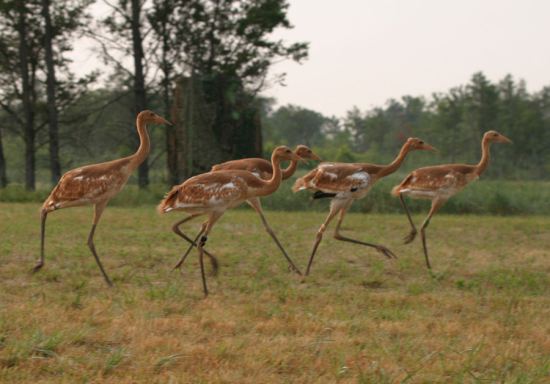
Taxi-training at Necedah NWR with the second cohort.
All took off with the trike and followed the pilot for a few minutes. Then #19-05 and two other birds dropped out and returned to the grass runway—but when the pilot circled back around in hopes the dropouts would take off and follow again, it worked! All three became airborne and followed for about half a circle before breaking off and again returning the runway.
On September 15, Cohorts 1 and 2 took their first flight together. All came out of the pen very excited, all flew well, and only #19-05 and her buddy #20-05 turned back early. Mark said, “That’s okay. They just don’t have the strength that the rest do.”
On Sep. 20, pilots tried to fly all 20 birds together for the first time. Sixteen flew with the trike for about ten minutes, but #19-05 (along with #11-05, #20-05, and #24-05) were the stragglers and they came back to the runway. She’s still a submissive bird.
September 28, the crew had a surprise. Angie said, “#19-05 has always been a relatively submissive bird but has suddenly become pretty gutsy. She will chase almost any bird that comes near her, but will generally back down to other more dominant birds. In fact, a couple of days ago, we noticed that she was missing a patch of feathers on the left side of her face. We guess that she tried to take on one of the more aggressive birds and paid for it with a few feathers. The feathers are growing back nicely now, and we think she learned a valuable lesson because she has been a little more mellow the past few days.”
History
First Migration South: Chick #19-05 left Wisconsin for her first migration on October 14th, 2005. Read day-by-day news about the flock’s migration to see what happens. She performed wonderfully during the migration with no behavior problems or illness. On Dec. 13, #19-05 landed safely with the 19-bird flock at the holding pen at Halpata Preserve. But in the few weeks at Halpata, she became very submissive and the other birds picked on her a lot. She became terrified of both the other birds AND the costume. The cranes will be moved in mid-January after all the older cranes have dispersed from the release pen.
The pilots and ultralights tried to move the birds on January 9. Not until the third day of trying (January 11) did #19-05 follow the ultralights over to Chass. HOME! After being at the Chass release site for a week, the birds were let out of the top-netted pen to exercise. (They had not yet been “turned loose” full time.) From the pen, Mark Nipper reported: “#19-05 was one of the birds that flew. When she landed she came down on the other side of the pen, and as usual, she didn’t make it easy for us to get her back into the pen.”
Spring 2006: Began first spring migration from the “Chass” pen site March 28 with all flock members except #20-05. This flock of 18 split at roost time on March 28, and fourteen juveniles (#1-05, #2-05, #3-05, #5-05, #6-05, #7-05, #8-05, #9-05, #10-05, #12-05, #14-05, #19-05, #23-05, and #24-05) stayed together. They probably roosted near the confluence of Turner, Crisp and Wilcox Counties in Georgia. They didn’t move the next day. On March 30 they resumed migration and roosted in Hamilton County, TN. The next roosting place was March 31 in Spence County, KY; April 1 in Jefferson County, IN; April 2 and 3 in DuPage County, IL; April 4 in McHenry County, IL. (past Chicago). They are determined to get back to Wisconsin! They flew two days in rain, and in stong headwinds on April 4. On April 5 they resumed migration, stopping in Sauk County, WI—just short of Necedah NWR! Tracker Richard Urbanek was monitoring them the morning of April 6 when they took off. They completed spring migration as they passed the SW corner of Necedah NWR just after noon. (They kept going! They landed, foraged, and roosted that night in nearby Trempealeau County, WI.)
Fall 2006: #19-05 (along with #10-05, #11-05, #12-05 and #7-03) began migration from Wisconsin’s Necedah NWR on November 9 and made it to northern Illinois that night. Next report was January 2, when they were found in Levy County, FL!
Spring 2007: Began migration on March 28 with #5-01. They arrived on #5-01’s old territory at Necedah NWR on April 16!
Fall 2007: She left on migration with male #8-04 on November 27. Crane #19-05 (along with #8-04 and #12-05) completed migration and arrived in Florida on December 4. She was found with #8-04 and ##14-05 in Hillsborough County, FL on Dec. 19.
Spring 2008: After wintering south of Tampa, #8-04, #14-05 and #19-05 were the first cranes to begin their journey north on February 26. A March 18 report of three whooping cranes in Morrison County, Minnesota, may have been these birds. On March 30, #19-05 and #8-04 were observed on Necedah NWR in Wisconsin. It was later determined they arrived on March 27. The pair was reported nesting on the refuge and it appeared on April 23 as if they had just begun to incubate. The nest failed on or before May 5, when it was found empty.
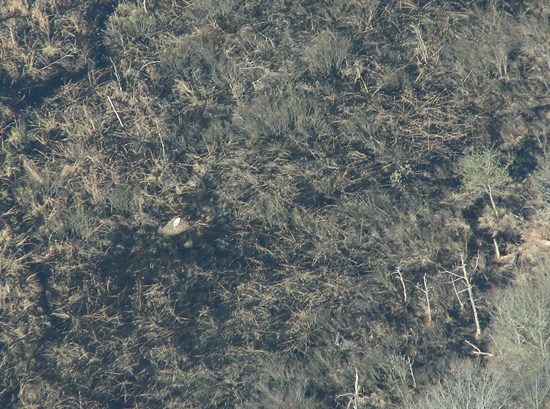
Sara Zimorski took these photos of the pair’s nest from a plane on April 23, 2008. She checked the nest on May 5, 2008, only to find it empty.
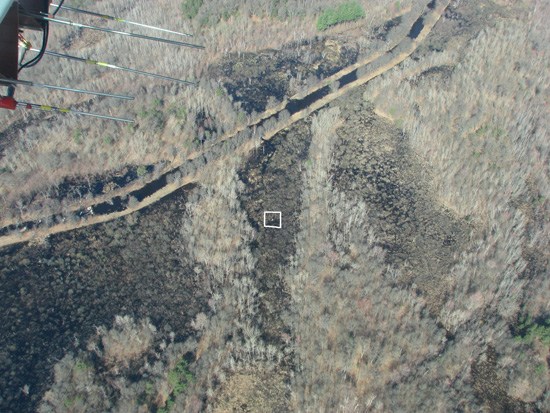
Fall 2008: She migrated with mate #8-04 in a group of other whoopers that reached Alachua County, Florida by Dec. 31/January 1. The group stayed together at the wintering site.
Spring 2009: During aerial checks of this wintering group on February 25 and March 4, #19-05’s signal was not detected and only 8 birds (including #19-05’s mate, #8-04), were observed. Crane #19-05 was last recorded alive at this location on February 21. Trackers suspected she may have died — until she was reported in Greene County, Indiana during March 9-15 with male #8-04! (Her transmitter does not work so she can’t be tracked.) The signal of #8-04 was heard on Necedah NWR March 19 and a week later #19-05 was also confirmed there. Wonderful news! It got even better when the pair was found April 8 incubating on a nest. (Nest failed before eggs could hatch when black flies tormented the parents off the nest.) In late May trackers located a possible re-nest of this pair, but they did not become parents and spent the rest of the summer in the same area.
Fall 2009: Crane #19-05 and mate #8-04 had not yet begun migration as of Nov. 30 but they did migrate and spent winter in their old territory in Alachua County, Florida, where they remained at least until Feb. 16.
Spring 2010: Crane #19-05 and mate #8-04 were detected at Armstrong Bend, Meigs/Rhea Counties, Tennessee, on February 25. They arrived in Greene County, Indiana by March 14 and remained there until departure March 18-22. They were reported back on Necedah NWR by March 24 and observed on a nest during an aerial survey on April 5.
Fall 2010: She migrated with her mate #8-04 to their previous winter territory in Alachua County, Florida. They apparently split as winter ended.
Spring 2011: Female #19-05 started a new chapter in her life! She left her mate #8-04 during the winter. She was sometimes seen after that with a male Whooping crane from the Florida non-migratory flock (see glossary for more on this flock). While her former mate #8-04 completed migration back to Wisconsin by March 29, #19-05 stayed in Florida until at least March 24, still associating with the non-migratory male (#1343).
On April 7, tracker Eva received a photo of #19-05 and nonmigratory male #1343. SURPRISE! The photo was taken that evening at a location in Monroe County, Indiana—which means male #1343 is migrating north with #19-05! “Must be love,” said Eva. (Male #1343 nested on Paynes Prairie, Florida, last year, but his mate and the two chicks that hatched were all killed by predators.) What might happen when this female returns to her former territory with a new male? (Her previous mate #8-04 is associating with female #8-09 on their old territory.)
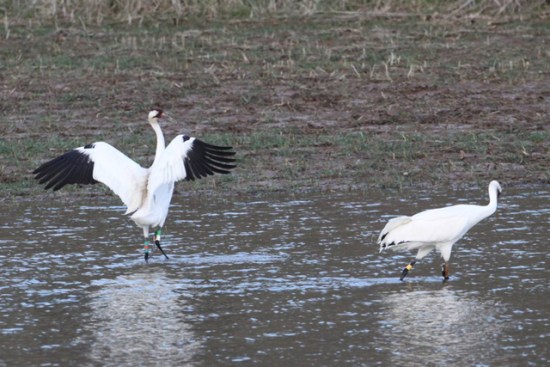
Female #19-05 was spotted in Monroe Co., Indiana with male #1343 from the Florida non-migratory flock.
On April 10 female #19-09 was reported back on Necedah NWR but it was not confirmed whether the male was with her. On April 13 female #19-05 was located with her old mate, #8-04. Because nonmigratory male #1343 doesn’t have a functional transmitter and can’t be tracked, his whereabouts can only be known if there is a sighting. Biologist Tom Stehn predicted he would spend summer in Wisconsin and go back to Florida in the fall, but this male crane didn’t wait! he was already back in Florida with his old mate in May! Meanwhile, back in Wisconsin for the summer, reunited pair #19-05 and #8-04 built a nest and began incubating on April 25! Their nest failed on May 9, so no chicks hatched.
Fall 2011: Migrated with mate #8-04 to Greene County, Indiana.
Spring 2012: Female #19-05 was reported back on Necedah NWR on March 16, migration complete. She and her mate #8-04 were found incubating on an April 26 nesting survey flight by trackers. The first nest failed but they nested again on May 14 and were still incubating May 29, but this nest also failed.
Fall 2012: Departed on November 17 with #8-04 and migrated to Greene County, Indiana.
Spring 2013: Completed spring migration with #8-04 on March 30.
Fall 2013: Migrated after November 8 with #8-04 and they may have spent the winter in Greene County, Indiana, although trackers are not certain because both cranes have nonfunctional transmitters. They were in Greene County in mid January, so Tracker Eva assumes they stayed the winter.
Spring 2014: Pair #19-05 and mate #8-04 completed migration to the Necedah NWR by April 1. They nested but by April 30 the nest had flooded and failed.
Fall 2014: Pair #19-05 and #8-04 migrated to Greene County, Indiana, where they have been seen associating with pair #9-05 and #13-03 and their adopted chick #20-14.
Spring 2015: Pair #19-05 and mate #8-04 completed migration to the Necedah NWR and nested, but did not have nesting success again this spring.
19-05 was in May 2015.
Click here to jump to the top of this page.
Crane #20-05
Sex: Female
Hatch Date: May 31, 2005
Personality and Characteristics: Migration Training – Chick #20-05 and #26-05 did very well in training at the circle pen at the hatching center in Maryland (at Patuxent Wildlife Research Center). Chick #20-05 shipped to Wisconsin’s Necedah NWR on July 13 with other cohort 3 (youngest) chicks, ready for flight school. All cohort 3 birds surprised the ultralight pilots by quickly coming out of their pen on their first day of training after arriving at Necedah NWR. They all ran after the trike, following closely. Hooray! She was a pretty good little flyer by August 28. That’s when the older, better flyers of Cohort 2 moved in with the younger Cohort 3 chicks at the east site. (The two groups will live together but train separately until the younger ones become stronger flyers.) When the Cohort 3 birds were still flying around with the ultralight, #20-05 landed in a marsh, right behind the Cohort 2 side of the pen. She stayed close. But when it was Cohort 2’s turn to fly, #20-05 tried to follow. She flew down to the end of the runway, but she stopped as the ultralight and the other birds came closer. John was glad, because she’s probably not ready yet to fly with Cohort 2. “She wouldn’t have been able to keep up.”
Chick #20-05 is one of the chicks struggling to keep up with the group. She’s been flying back to the runway and missing out on over half the flights. The September 9 training session was an improvement for this group. All the Cohort 3 birds took off with the trike and followed the pilot for a few minutes. Then three birds dropped out and returned to the grass runway—and #20-05 wasn’t one of them! Handler John Thomton said, “I was happiest for #20-05, who has been hugging the runway a lot lately. She followed the trike for the entire time today! That’s my girl!!”
On September 15, all the birds of Cohort 1 and 2 took their very first flight together. All came out of the pen very excited, all flew well, and only #20-05 and her buddy #19-05 turned back early. Mark said, “That’s okay. They just don’t have the strength that the rest do.” She tends to be submissive in the cohort, and can’t keep up with the other birds in the air. She has dropped out of the flight over the refuge, but returns to the runway on her own.
On Sep. 20, pilots tried to fly all 20 birds together for the first time. Sixteen flew with the trike for about ten minutes, but #20-05 (along with #11-05, #19-05, and #24-05) were stragglers that came back to the runway.
First Migration South: Chick #20-05 left Wisconsin for her first migration on October 14th, 2005.
Here is more news about Chick #20-05:
On Day 14, Joe looked down to see a lone bird flying far below. It was #20-05, who was tired, struggling, and dropping. Joe did a fast descent to collect the lone bird. She was panting hard and anxious to join Joe’s wing. #20-05 dropped into place and soon closed her beak and began to breathe normally. She got a nice lift from the current under Joe’s wing and had a much easier flight with more gliding and less flapping.
On Day 58, she was one of the 12 birds who didn’t make it to the Cook County, GA stop. She dropped off Richard’s wing and landed in a sod farm south of Albany, Georgia. Trackers located her signal and turned back to find her. As soon as she saw the trike flying low over the field she popped up and followed it back to the starting point. Not long after the pilot got #20-05 on the wing, the team began wondering if he had enough gas to get there. Luckily, he was able to make it back and the bird was fine.
On Dec. 13, #20-05 landed safely with the 19-bird flock at the holding pen at Halpata Preserve. The cranes will be moved 26 miles to their final release pen at Chassahowitzka NWR (“Chass”) in mid-January after all the older cranes have dispersed from the release pen.
The pilots and ultralights tried to move the chicks on January 9, 10 and 11. Crane #20-05 made it to Chass on the third day of trying, January 11. HOME for the winter!
Spring 2006: #20-05 began spring migration with adult whooping crane #9-03 (who has never successfully returned to Wisconsin) on March 27, one day before the rest of her flock mates. They made it to Dooley County, Georgia March 27, and then to northern Georgia on March 28. On March 29 the two were still together in Meigs/Rhea Counties in Tennessee, right on the route back to Wisconsin! On March 30 they were in Ripley County, IN. The two resumed migration April 2. According to PTT readings, they roosted that night in Huntington County, Indiana; on April 3 in Allen County, Indiana; and on April 4-5 along the western shore of Lake Huron in Sanilac County, Michigan. On April 6 they continued northward and stayed along the shore of Lake Huron in Huron County, MI until April 13 when they moved into Ontario, Canada. On Apr 15 they continued eastward re-entered the U.S. to roost in Jefferson County, NY. Both birds returned to Lewis County, NY April 17 before moving on April 21 to Addison County, Vermont. They flew back to Lewis County NY (the area that #9-03 occupied in the spring of 2005) on April 29.
The two were captured May 5, 2006 and flown in a private plane HOME to Necedah NWR in Wisconsin. Will #20-05 get it right next year?
Fall 2006: Departed undetected in the Nov. 19 mass migration of 28 whoopers. Until then, she was in farm fields and wetlands in Monroe County, near the flock’s Wisconsin summer home. She was still with #9-03 as they migrated south. On Dec. 18 they completed migration to the Chassahowitzka pen site! HOORAY! This is a BIG DEAL because it was the first successful unassisted migration between Wisconsin and Florida for BOTH of them. Crane #9-03 went to North Carolina the past two autumn migrations, leading #20-05 astray with her.
They left “Chass” on Dec. 20 and moved to Pasco County. By December 22 they had moved to Hernando County, where they were quite close to houses. She wandered between Pasco and Hernando Counties, hanging out with #7-04, #9-03 and sandhill cranes. She visited the Chass pen on January 12 wandered off by herself and flew back to Hernando County Jan. 14.
Spring 2007: Crane #20-05 (and #1-04) arrived to roost on Necedah NWR by the night of March 22. They had begun migration from Pasco County, FL on March 13.
Fall 2007: Found with staging sandhills near Clark County, Wisconsin, on October 9, then with a sandhill pair in Monroe County. Left Wisconsin on migration November 27. Found on Hiwassee WR in Tennessee throughout December.
Spring 2008: Female #20-05 began migration from Armstrong Bend and Hiwassee WR, Meigs County, Tennessee, sometime between February 28 and March 14. Sara reported on April 9 that #20-05 has been confirmed back in Jackson County, Wisconsin, where she typically spends the summer. She was there through at least September 30. Her transmitter is nonfunctional, and she cannot be tracked.
Fall 2008: #20-05 was observed with Sandhill cranes near the refuge Nov. 16, but her transmitter does not work so she cannot be tracked. She was next reported in Benton County, Indiana on Nov. 21 — and confirmed there with #9-03 and #3-04 on November 25. The three ended up in Lafayette County, Florida in December. (Crane #20-05 has a nonfunctional transmitter and cannot be tracked.)
Spring 2009: Female #20-05 (with her paired friends #3-04 and #9-03) apparently began migration from Taylor County, Florida, between February 19 and 25. Unpaired, she was last reported in Jackson County, Wisconsin on June 16.
Click here to jump to the top of this page.
Crane #21-05
Sex: Female
Hatch Date: May 30, 2005
Personality and History
Migration Training: During their first weeks, 19-05, 21-05, 22-05, and 23-05 trained well together at the circle pen. “These guys are hilarious,” reported trainer Mark Nipper at Patuxent WRC. “They run in a tight little bunch in the circle. They are constantly knocking into each other and a couple of them really compete to be the closest to the trike. After a few minutes, they will start getting tired and hot, or just lazy, and break up a little. There is usually a bird in every group that will linger behind and forage on its own. For a long time, I thought that 1-059 was that bird. Lately, however, each bird has been taking a turn at this “lagging” behavior.”
On July 10, Mark said, “Today we have had a breakthrough with these chicks out at the pond. We have not been able to leave the pen without them becoming highly stressed and pacing along the fences. This leads to banged up faces and raw spots on the body from rubbing. The birds will stick their heads through the fence if they can. All of this is pretty common for a while, but these guys seem particularly clingy. What we trainers usually do is take turns sitting in the pen with them. It is really pretty fun to hang out with the birds and just let them do their own thing in the water. They usually take baths and are running around all over the place trying to catch everything that moves. It is very important, though, that they be able to spend time away from us. Once we’re all moved to the reintroduction site at Necedah NWR, we try to spend as little time as possible with the birds. That time becomes less and less as we get closer to migration. We hope this helps the chicks to be less attached to us and allows them to just be birds. Chick #21-05 shipped to Wisconsin’s Necedah NWR on July 13 with other cohort 3 (youngest) chicks, ready for flight school. All cohort 3 birds surprised the ultralight pilots by quickly coming out of their pen on their first day of training after arriving at Necedah NWR. They all ran after the trike, following closely. Hooray!
In flight training, she tried hard to keep up, but can’t quite do it. She lags behind, but only occasionally returns to the runway or lands in the marsh. She likes to chase the white birds (the adult whooping cranes). She’s “kind of spunky” and will peck back at more dominant birds!
The September 9 training session was an improvement for this group of struggling young flyers. All took off with the trike and followed the pilot for a few minutes. Then three birds dropped out and returned to the grass runway—but when the pilot circled back around in hopes the dropouts would take off and follow again, all three became airborne and followed before dropping out again. Not #21-05 — who hung in there all the way!
History
First Migration South: Chick #21-05 left Wisconsin for her first migration on October 14th, 2005. Read day-by-day news about the flock’s migration to see what happens. She landed safely with the flock at the temporary holding site at Halpata Preserve in Marion County, FL on December 13. The cranes will be moved to their final release pen in mid-January after all the older cranes have dispersed from the pen site.
On January 10, Crane #21-05 made it to the final pen site at Chassahowitzka NWR on day 2 of the pilots’ attempts to move the flock. The birds slowly became familiar with the idea of again following the ultralight after a month’s vacation. Richard and Brooke managed to get #21-05 but only 5 other birds far enough from the pen that they fell into line and followed the final 26 miles.
Spring 2006: Began first spring migration from the “Chass” pen site March 28 with all flock members except 20-05. The flock split, with #21-05 and #11-05 staying in Turner County, GA on March 28. The two were last recorded there on March 30. Trackers had to leave these two birds behind in order to track the others. At 4:00 PM April 19, the radio signals #11-05 and #21-05 were detected over Necedah NWR. They had just completed their first spring migration!
Fall 2006: She began migration (together with male 14-05) on Nov. 11. They roosted in Kane County, IL before continuing migration against a headwind on Nov. 12. At last report they roosted in Ford County, IL. Then detected in flight in Citrus County, Florida (home!) with #5-05 and #6-05 on Nov. 25.
Remains of Crane #21-05 were found in her wintering area in Citrus County, Florida, on February 20, 2007. Telemetry data indicated that her death occurred between 9 and 12 February. Bobcat predation is suspected.
Click here to jump to the top of this page.
Crane #22-05
Sex: Male
Hatch Date: June 1, 2005
Personality and Characteristics: Migration Training – During their first weeks, #19-05, #21-05, #22-05, and #23-05 trained well together at the circle pen. “These guys are hilarious,” reported trainer Mark Nipper at Patuxent WRC. “They run in a tight little bunch in the circle. They are constantly knocking into each other and a couple of them really compete to be the closest to the trike. After a few minutes, they will start getting tired and hot, or just lazy, and break up a little. There is usually a bird in every group that will linger behind and forage on its own. Lately, however, each bird has been taking a turn at this “lagging” behavior.” On July 10, Mark said, “Today we have had a breakthrough with these chicks out at the pond. We have not been able to leave the pen without them becoming highly stressed and pacing along the fences. This leads to banged up faces and raw spots on the body from rubbing. The birds will stick their heads through the fence if they can. All of this is pretty common for a while, but these guys seem particularly clingy. What we trainers usually do is take turns sitting in the pen with them. It is really pretty fun to hang out with the birds and just let them do their own thing in the water. They usually take baths and are running around all over the place trying to catch everything that moves. It is very important, though, that they be able to spend time away from us. Once we’re all moved to the reintroduction site at Necedah NWR, we try to spend as little time as possible with the birds. That time becomes less and less as we get closer to migration. We hope this helps the chicks to be less attached to us and allows them to just be birds.
Chick #22-05 shipped to Wisconsin’s Necedah NWR on July 13 with other cohort 3 (youngest) chicks, ready for flight school. All cohort 3 birds surprised the ultralight pilots by quickly coming out of their pen on their first day of training after arriving at Necedah NWR. They all ran after the trike, following closely. Hooray!
On July 19, Mark raised a concern: “This bird has had an odd gait since it was very young at Patuxent Wildlife Research Center. It seemed to clear up some as it got older, but now that it is here in Wisconsin the gait looks just as bad as it did before. The bird is not necessarily lame or limping. It holds its body very oddly while running and kicks its legs high behind it making it lose balance often.”
By mid-September, he still has a funny gait when he runs, but it doesn’t cause problems for #22-05 or anyone around him. (Sometimes when a bird runs or flies oddly it can run into the others and be a burden or danger.) Chick #22-05 is a good flier. He has become a very independent bird, and he doesn’t want to go back in the pen after training sessions.
History
First Migration South: Chick #22-05 left Wisconsin for his first migration on October 14th, 2005.
Here is more news about Chick #22-05’s first migration:
On Day 13 (Oct. 26) #22-05 got tired and dropped out 12 miles from the destination. Luckily, one of the ultralights later turned back to pick him up and he flew to the new stopover site–60.6 miles from where they started.
He landed safely with the flock at the temporary holding site at Halpata Preserve in Marion County, FL on December 13. The 19 cranes will be moved to their final release pen in mid-January after all the older cranes have dispersed from the pen site.
On January 10, Crane #22-05 made it to the final pen site at Chassahowitzka NWR on day 2 of the pilots’ attempts to move the flock.The birds slowly became familiar with the idea of again following the ultralight after a month’s vacation. Richard and Brooke managed to get #22-05 and only 5 other birds far enough from the pen that they fell into line and followed the final 26 miles.
Spring 2006: Began migration March 28 in the flock of 18. They made it to Turner County, Georgia, but other flock members took off shortly after landing. Only cranes #16-05 and #22-05 stayed at this first stop to roost. They were in Meigs County, TN on Mar. 30 and 31. They migrated to Floyd County, IN on April 1. Location unknown April 2 and 3. On April 4 they resumed migration. They were hampered and blown eastward by a strong northwest wind and landed to roost in Decatur County, Indiana. They were seen together at this location on May 5. The next sighting of #16-05 was on May 13 in Eaton County, Michigan but #22-05 was NOT with him. Crane #22-05’s location was confirmed in Montcalm County, MI on May 16. He stayed in Michigan with sandhill cranes during May and June, moving on to Oceana County, MI. He was last detected leaving there on 14 June when he flushed with sandhill cranes as WCEP trackers tried to capture him to relocate him to Wisconsin. He was not tracked further. He is the only HY05 bird that was NOT found during the summer.
October 28, 2006: Sad news. Male #22-05 has died. His remains were found in Mason County, Michigan during aerial radio-tracking on October 25. The young male had probably died 2-4 months ago. As of Oct. 2006, #22-05 was the 16th from among 80 individuals so far released during the reintroduction (2001-06) and the first crane death from the HY2005 cohort.
Click here to jump to the top of this page.
Crane #23-05
Sex: Male
Hatch Date: June 1, 2005
Personality and Characteristics: Migration Training – During their first weeks, #19-05, #21-05, #22-05, and #23-05 trained well together at the circle pen. “These guys are hilarious,” reported trainer Mark Nipper at Patuxent WRC. “They run in a tight little bunch in the circle. They are constantly knocking into each other and a couple of them really compete to be the closest to the trike. After a few minutes, they will start getting tired and hot, or just lazy, and break up a little.”
On July 10, Mark said, “Today we have had a breakthrough with these chicks out at the pond. We have not been able to leave the pen without them becoming highly stressed and pacing along the fences. This leads to banged up faces and raw spots on the body from rubbing. The birds will stick their heads through the fence if they can. All of this is pretty common for a while, but these guys seem particularly clingy. It is very important, though, that they be able to spend time away from us. Once we’re all moved to the reintroduction site at Necedah NWR, we try to spend as little time as possible with the birds. That time becomes less and less as we get closer to migration. We hope this helps the chicks to be less attached to us and allows them to just be birds.”
Chick #23-05 shipped to Wisconsin’s Necedah NWR on July 13 with other cohort 3 (youngest) chicks, ready for flight school. All cohort 3 birds surprised the ultralight pilots by quickly coming out of their pen on their first day of training after arriving at Necedah NWR. They all ran after the trike, following closely. Hooray!
The September 9 training session was an improvement for this group of struggling young flyers, which was probably a result of the health check. All took off with the trike and followed the pilot for a few minutes. Then three birds dropped out and returned to the grass runway—but when the pilot circled back around in hopes the dropouts would take off and follow again, all three became airborne and followed before dropping out again. #23-05 held up and flew the distance.
He is large is size, but not in attitude. He usually blends in with the crowd, but sometimes challenges other birds. He loves to chase adults. He has a chronic deep peep. He used to resist returning to the pen, but is getting better.
History
First Migration South: Chick #23-05 left Wisconsin for his first migration on October 14th, 2005.
Here is more news about Chick #23-05’s first migration:
On Day 13 (Oct. 26) #23-05 got tired, dropped out, and had to be crated and moved the final 6 miles to the pen in LaSalle County, IL. On Nov. 30 he wouldn’t follow the ultralight. He kept turning back to Hiwassee with a small group of other cranes who didn’t want to leave the nice marshes at Hiwassee. He was put in a crate and driven to the next stopover site.
On Dec. 13, #23-05 landed safely with the 19-bird flock at the holding pen at Halpata Preserve. The cranes will be moved 26 miles to their final release pen at Chassahowitzka NWR (“Chass”) in mid-January after all the older cranes have dispersed from the release pen.
The pilots and ultralights tried to move the birds on January 9, but only #8-05 made it on this day. On the second day of trying (January 10), six more made it. The pilots tried again on January 11 to get the remaining cranes over to Chass. Crane #23-05 and all the rest of the birds EXCEPT #16-05 made it to Chass on the third day of trying, January 11. HOME for the winter!
Spring 2006: Began first spring migration from the “Chass” pen site March 28 with all flock members except #20-05. This flock of 18 split at roost time on March 28, and fourteen juveniles (#1-05, #2-05, #3-05, #5-05, #6-05, #7-05, #8-05, #9-05, #10-05, #12-05, #14-05, #19-05, #23-05, and #24-05) stayed together. They probably roosted near the confluence of Turner, Crisp and Wilcox Counties in Georgia. They didn’t move the next day. On March 30 they resumed migration and roosted in Hamilton County, TN. The next roosting place was March 31 in Spence County, KY; April 1 in Jefferson County, IN; April 2 and 3 in DuPage County, IL; April 4 in McHenry County, IL. (past Chicago). They are determined to get back to Wisconsin! They flew two days in rain, and in strong headwinds on April 4. On April 5 they resumed migration, stopping in Sauk County, WI—just short of Necedah NWR! Tracker Richard Urbanek was monitoring them the morning of April 6 when they took off. They completed spring migration as they passed the SW corner of Necedah NWR just after noon. (They kept going! They landed, foraged, and roosted that night in nearby Trempealeau County, WI., but spent the summer in the core reintroduction area.)
Fall 2006: Making their first Fall migration after learning from the ultralights, #23-05 and #24-05 left Necedah NWR, undetected, on October 22. They were found north of the Halpata pen site (site of their layover last year) in Marion County, FL Nov. 22! They were in Levy County through Jan. 10 and not with sandhill cranes. When next checked on Jan. 13, the signal of #23-05 was detected staying in one place but the signal of #24-05 was no longer detected.
Spring 2007: Crane #23-05 remained in Levy County, where he was seen alone on March 1 during an aerial survey. He was still there April 7. His weak radio signal was detected during an aerial survey of the area on April 21 and April 29 but the crane was not seen. A ground search was conducted and his remains were found May 4, 2007, in Big Wolf Arbor, Levy County, Florida. He had been dead for several weeks, likely the victim of an alligator attack.
Click here to jump to the top of this page.
Crane #24-05
Sex: Male
Hatch Date: June 1, 2005
Personality and Characteristics: Migration Training – Hatched June 1, 2005. His toes had to be taped at Patuxent, and he often tripped and fell over the toe-taped foot when walking. But the toe got straight, the tape came off, and he walked much better! He was the dominant chick in his cohort at Patuxent. On July 10 (just before cohort 3 shipped to Necedah), Mark said, “#24-05 is a little bit of a pain to the other birds.”
Chick #24-05 shipped to Wisconsin’s Necedah NWR on July 13 with other Cohort 3 (youngest) chicks, ready for flight school. All Cohort 3 birds surprised the ultralight pilots by quickly coming out of their pen on their first day of training after arriving at Necedah NWR. They all ran after the trike, following closely. Hooray!
On August 28, Cohort 2 joined the younger Cohort 3 birds to live at the same pen site. When both groups were let out to mix with each other for the first time, #24-05 and #14-05 chased and bit each other. They jump-raked each other too (jumped into the air and kicked out at each other with their sharp claws). They “acted like jerks,” said the handlers.
As days of flight training passed, some days #24-05 doesn’t even get off the runway. He and #19-05 follow the trike, flying along the ground until reaching the unmowed grass. Then they stop, so they have been missing out on some flight training. The September 9 training session was an improvement for this group of struggling young flyers. All took off with the trike and followed the pilot for a few minutes. Then #24-05 dropped out and #26-05 and #19-05 followed. They all returned to the grass runway—but when the pilot circled back around in hopes the dropouts would take off and follow again, it worked! All three became airborne and followed for about half a circle before breaking off and again returning the runway.
By September 15, chicks #24-05 and #26-05 are grappling for second place in the combined 2/3 Cohort, with #14-05 in first place. Chick #24-05 is not yet a great flyer. He often returns early to the runway. He can still be clingy with the handlers, peeping loudly and begging.
On Sep. 20, pilots tried to fly all 20 birds together for the first time. Sixteen flew with the trike for about ten minutes, but #24-05 (along with #11-05, #19-05, and #20-05) were stragglers that came back to the runway. But he’s getting better–and he is still one of the top birds in dominance on the ground.
History
First Migration South: Chick #24-05 left Wisconsin for his first migration on October 14th, 2005. Read day-by-day news about the flock’s migration to see what happens. Here is more news about Chick #24-05’s first migration:
On day 1 he returned to the pen and had to be crated and taken to the first stopover. (Chicks #3-05, #5-05, #6-05 and #16-05 turned back too.) on Nov. 30 he wouldn’t follow the ultralight. He kept turning back to Hiwassee with a small group of other cranes who didn’t want to leave the nice marshes at Hiwassee. He was put in a crate and driven to the next stopover site. After that day, he followed the ultralight just fine.
On Dec. 13, #24-05 landed safely with the 19-bird flock at the holding pen at Halpata Preserve. The cranes will be moved 26 miles to their final release pen at Chassahowitzka NWR (“Chass”) in mid-January after all the older cranes have dispersed from the release pen.
The pilots and ultralights tried to move the birds on January 9. Crane #24-05 made it to Chass on the third day of trying, January 11. HOME for the winter!
Spring 2006: Began first spring migration from the “Chass” pen site March 28 with all flock members except #20-05. This flock of 18 split at roost time on March 28, and fourteen juveniles (#1-05, #2-05, #3-05, #5-05, #6-05, #7-05, #8-05, #9-05, #10-05, #12-05, #14-05, #19-05, #23-05, and #24-05) stayed together. They probably roosted near the confluence of Turner, Crisp and Wilcox Counties in Georgia. They didn’t move the next day. On March 30 they resumed migration and roosted in Hamilton County, TN. The next roosting place was March 31 in Spence County, KY; April 1 in Jefferson County, IN; April 2 and 3 in DuPage County, IL; April 4 in McHenry County, IL. (past Chicago). They are determined to get back to Wisconsin! They flew two days in rain, and in strong headwinds on April 4. On April 5 they resumed migration, stopping in Sauk County, WI—just short of Necedah NWR! Tracker Richard Urbanek was monitoring them the morning of April 6 when they took off. They completed spring migration as they passed the SW corner of Necedah NWR just after noon.
Fall 2006: Making their first fall migration after learning from the ultralights, #24-05 and #23-05 left Necedah NWR, undetected, on the morning of October 22. They were found north of the Halpata pen site from last year’s layover in Marion County, FL Nov. 22! They were in Levy County through Jan. 10 and not with sandhill cranes. When next checked on Jan. 13, the signal of #24-05 was no longer detected. His transmitter is not working.
Spring 2007: #24-05’s status is unknown and trackers are worried that he may have died. His transmitter does not work. He was last observed with #23-05 on February 16. During an aerial survey on March 1, #24-05 was not with #23-05. Richard Urbanek noted that it was unlikely, although possible, that the two wintering cranes would have separated by choice. Because of vegetation and water conditions of that area, Richard said, “If #24-05 died there, finding his remains without the assistance of a transmitter would be almost impossible.” By the end of March, #24-05 was presumed dead, with death likely sometime between Feb. 16 and March 1, 2007 in Florida.
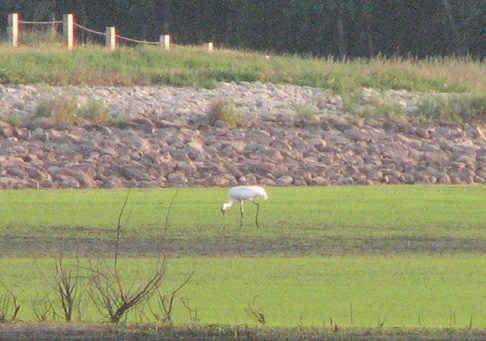
On June 13, 2007, #24-05 was spotted alive and well, back on the summer home at Necedah NWR in Wisconsin. Photo: Nicole Frey, ICF
Fall 2007: #24-05 began migration from Necedah NWR after October 28. He was observed flying south at Jasper-Pulaski Fish and Wildlife Area in Indiana. Unfortunately, his transmitter doesn’t work so he cannot be tracked. A whooping crane was found at Jasper-Pulaski FWA (in Indiana) on November 4, and on November 7 this bird was confirmed to be #24-05. He was still there Nov. 24.
Spring 2008: Where is #24-05? Late on the night of April 14 Sara received word from the landowner on whose land five of the 2007 DAR birds were staying in Fayette County, Indiana. A new Whooping Crane had joined the DAR youngsters there!
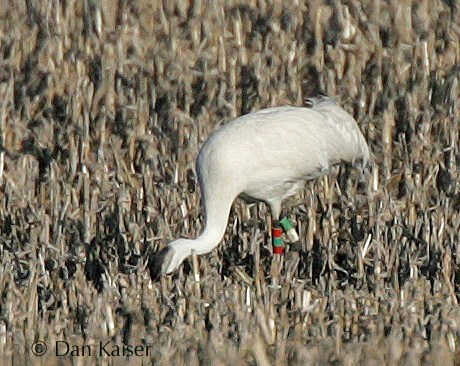
Photo: Dan Kaiser
Colored leg bands proved it was #24-05, whose transmitter is dead and who hadn’t been seen since November 2007. On April 16 the five DAR birds resumed migration and #24-05 departed too, but was not seen again until August 26. Eva was tracking on the south half of the refuge, “zeroing in on #7-03 and #21-07 who are always together, when I saw three birds near the road. One of them turned out to be #24-05! It’s possible that he has been on the refuge for a long period of time, but was never in the right place at the right time for a tracker to see him.” Hooray!
Fall 2008: He was captured and his transmitter replaced on Nov. 13 so he can now be tracked. Began migration from Wisconsin on November 17, along with pair #13-02 and #18-02. He was next reported with the pair on their wintering territory in Morgan County, Alabama on Nov. 21. He wintered on Wheeler NWR in Morgan County, AL.
Spring 2009: Trackers believe he likely began migration from Alabama along with pair #13-02 and #18-02 between March 9 and 13. He was last reported with them in Warrick County, Indiana, on the morning of March 15, 2009. No further confirmations on him, although #13-02 and #18-02 arrived back at Necedah NWR March 19. He was unpaired and stayed in the area all summer.
Fall 2009: He was reported in Dane County, Wisconsin, from November 15-25 with #27-06 (DAR) and #42-07 (DAR). They were no longer at this location on November 26 and completed their migration in Morgan County, Alabama.
Spring 2010: Male #24-05 with #27-06 (DAR) and #42-07 (DAR) began migration from Alabama after March 6. Crane #24-05 was found with #42-07 (DAR) back in Adams County during an aerial survey on April 5.
Fall 2010: Male #24-05 and mate #42-07 (DAR) were confirmed at their wintering area on Wheeler NWR, Morgan County, Alabama, on November 29.
Spring 2011: Male #24-05 and mate #42-07 (DAR) were observed in flight on the morning of March 3 and did not return to their winter location. They were back in Adams County, Wisconsin by March 21. The pair nested for the first time and began incubating on April 24. The nest failed on April 29 but two fertile, viable eggs collected.
Death: Sad news came on June 13 when the carcasses of this breeding pair were found on their Adams County territory by ICF Field Ecology Intern Mike Wheeler. Both carcasses were sent to the USGS National Wildlife Heath Center in Madison, Wisc. for necropsy. The carcass of male #24-05 was too decomposed to determine the cause of death and tissues were unsuitable for further analysis. The suspected cause of death for the female was septicemia, and analysis of lab cultures and tissues is pending.
Click here to jump to the top of this page.
Crane #26-05
Sex: Male
Hatch Date: June 3, 2005
Personality and Characteristics: Migration Training – Chick #20-05 and #26-05 did very well in training at the circle pen at the hatching center in Maryland (Patuxent Wildlife Research Center). Chick #26-05 shipped to Wisconsin’s Necedah NWR on July 13 with other cohort 3 (youngest) chicks, ready for flight school. All cohort 3 birds surprised the ultralight pilots by quickly coming out of their pen on their first day of training after arriving at Necedah NWR. They all ran after the trike, following closely.
On July 19, #26-05 was able to displace adult whooping crane #18-02 while in the midst of an aggressive display. (Adult #18-02 hangs around the new chicks’ training site, where she herself trained as a chick in 2002.) A peck at those pretty white tail feathers and #18-02 moved right over!
He has a crooked bill, but it causes no problems.
By September, #26-05 and a few others have been struggling to keep up with the group, especially since the health check. They’ve been flying back to the runway and missing out on over half the flight. But the September 9 training session was an improvement. All took off with the trike and followed the pilot for a few minutes. However, #26-05 and two other chicks soon dropped out. They all returned to the grass runway. But when the pilot circled back around in hopes the dropouts would take off and follow again, it worked! All three became airborne and followed for about half a circle before breaking off and again returning the runway.
By September 15, when the combined cohorts 2 and 3 took their first training flight together, #26-05 was grappling with #24-05 for second place in the large group, with #24-05 in first place. He isn’t the strongest flyer, but #26-05 follows the costume well. He is a little over-aggressive to any other birds.
History
First Migration South: Chick #26-05 left Wisconsin for his first migration on October 14th, 2005. Read day-by-day news about the flock’s migration to see what happens.
The team was shocked and sad to find #26-05 dead in the pen the evening of November 9, day 27 of the migration. They were at the Morgan County, Indiana stopover site. The youngest bird, #26-05 was a strong, large male. He was a long way from the bottom of the dominance order. Why did he die? The team first thought it might be aggression between birds due to their long stay in one place. That kind of fight results in multiple and obvious injuries but #26-05 only had one injury around the left eye; none of the other birds showed any signs of aggression or injury. Maybe a disease or swallowing a foreign object caused a collapse and the other birds pecked at him once he was down. He could have jumped up in the high winds blowing through the pen and hit his head on something hard. No one knows. His carcass was sent to the USGS National Wildlife Health Center in Madison, WI for a necropsy to learn the cause of death.
The exam showed a puncture through the left eye and into the head, but no penetration to the brain. Some bruising was found, and a hemorrhage in the brain that would result from a powerful blow to the head. The doctors believed the fatal injury was caused in the pen in a fight with another crane.
Click here to jump to the top of this page.
Group Two: Direct Autumn Release (DAR) cranes
Crane #27-05 “Jumblies”
Sex: Female
Hatch Date: June 5, 2005
Personality and Characteristics: Migration Training – She was hatched at ICF and named “Jumblies.” She was transferred to the Necedah NWR at 1 month of age. Marianne Wellington is a chick-rearing specialist who wore a costume and raised the four DAR chicks there. They fledged (learned to fly) when they were around 70 days old. Unlike their cousins for the ultralight-led migration, the DAR chicks roamed freely on the refuge. Marianne and other costumed parents checked on them many times each day. At night until they’re released the chicks are safe in a big pen with a pond and a net over the top.
DAR Chick #27-05 (along with #33-05) was released for good on the refuge near adult whooping cranes on Oct. 25, 2005. She has been hanging out with other sandhill cranes and whooping cranes on the refuge and nearby areas.
History
Fall 2005: First Migration South as a Direct Release Bird:The four DAR birds began migration Nov. 24 from Necedah NWR when an Arctic air mass with 20 to 40 mile per hour winds moved into Wisconsin. They left at 10:33AM with +50 sandhill cranes. Taking advantage of a strong tailwind, these birds soon were far ahead of the tracking team, who were snarled in a traffic jam on the WI-IL border. The three DAR females each carry a PTT transmitter, and #27-05 was detected northeast of Louisville, KY. That means she traveled a whopping 455 miles on the first day of her migration! She was not with the other DAR chicks, whose signals were not detected. After circling Louisville for a day in a small airplane, tracker Sara Zimorski found her at an arboretum south of town, right next to a public walking path. Sara knew that a place so near human activity was unsafe for #27-05. She notified her supervisor, Dr. Richard Urbanek. He was providing ground support for Sara when she was tracking from the airplane. Dr. Urbanek and a helper, wearing the familiar white costumes, got near to #27-05 on Nov. 28 with a cardboard box and an ear of corn. She had been raised by biologists wearing these same suits, so #27-05 cautiously came near. They carefully pushed her into the box. The captured #27-05 was then driven 28 miles eastward. They released her among sandhill cranes in a remote waterfowl refuge that was closed to the public. She left on Nov. 29, with a 20 mph west wind. She was migrating alone. Without guidance from other cranes, she proceeded slowly southward while being blown eastward by the wind. She landed to roost about 5 PM in Laurel County, Kentucky. She resumed migration the next day (Nov. 30), flying southward alone. She landed about 1 PM in Bledsoe County, Tennessee–one ridge and valley west of Hiwassee Wildlife Refuge. Then she likely heard or saw sandhill cranes (they’re loud), and flew the short distance over Walden Ridge to land about 4 PM among more than 100 sandhills in a wetland near Hiwassee Wildlife Refuge. Hooray! She made it from north-central Kentucky to the big crane gathering area at Hiwassee without the guidance of other cranes except for the final short incoming flight. She remained to roost with more than 300 sandhill cranes, and is still there, along with DAR #28-05.
Spring 2006: Began migration from Hiwassee Wildlife Refuge in Tennessee on February 26! She was with DAR female #28-05. PTT readings showed they roosted that night in Kentucky. They were in northwestern Indiana by February 28. Then the two separated. Chick #27-05 moved to another Indiana wildlife area with a flock of migrating sandhills until March 30, when PTT readings showed she resumed migration. She made it to Green Lake County and Fond du Lac County, Wisconsin on that date. She completed migration to Necedah NWR on April 27. At that time she was observed briefly associating with #12-04 on the refuge. She was occasionally observed during the summer and often in autumn prior to migration. She spent the summer with a large sandhill crane flock in Winnebago County and Marathon County, WI. Male #12-04 continued to attempt to pair with her without success, and they migrated and wintered separately.
Fall 2006: Began migration Nov. 19 and made it to Jasper-Pulaski SFWA in Indiana, by 20 November. As of Dec. 27, remained with thousands of staging or wintering sandhills on Hiwassee Wildlife Refuge in Meigs County, Tennessee.
Spring 2007: Began migration from Hiwassee Wildlife Refuge in Tennessee after February 12. According to PTT readings, DAR #27-05 roosted in Pike County, Indiana, on the night of February 21. On March 18 she was reported with sandhill cranes in Jasper-Pulaski FWA, Indiana — good crane habitat on the migration route. A signal (exact location undetermined) was detected in Columbia County, Wisconsin, during an aerial survey on March 29.
Fall 2007: Arrived on Jasper-Pulaski FWA in Indiana on or by November 22. Arrived on Hiwassee WR in Tennessee on December 3 and was still there the end of December.
Spring 2008: Female DAR #27-05 began spring migration during sometime between February 28 and March 3. She was reported with migrating sandhills in Jackson County, Indiana, until she resumed migration on March 16 or 17. An unconfirmed sighting in Fond du Lac County, WI on April 17 may have been this bird.
Fall 2008: Reported with large numbers of Sandhill cranes in Wisconsin in mid October. She was confirmed on her winter area at Hiwassee WR in Tennessee on November 23.
Spring 2009: She was reported on migration— in Hardin County, Kentucky on February 22 in large flocks of migrating sandhills. She was reported with sandhill cranes in Sawyer County, Wisconsin, on March 24. An unconfirmed report of a whooping crane in Shawano County on March 26 may have been of this bird. She was in Alger County on Michigan’s Upper Peninsula on April 18, and she was next observed on Necedah NWR on June 9 with #12-04.
Fall 2009: The wayward DAR #27-05 was observed on Necedah NWR, still with #12-04, in early October. She remained there until she moved to Columbia/Sauk Counties, WI, where she was reported on November 26-27. As in previous years, she wintered at Hiwassee State Wildlife Refuge in Tennessee.
Spring 2010: Crane #27-05 (DAR) was reported with migrating sandhills in Barren County, Kentucky on February 7 and in Gibson County, Indiana, on February 20. She remained at this location through at least March 2. She was reported with #16-04 in Newton County, Indiana, on March 15. She has a nonfunctional transmitter but was seen by Eva at Necedah NWR on April 12, hanging out with male #12-04 south of the refuge. “Last year I know he was extremely interested in pairing with her, but she didn’t seem to care so much,” said Eva. “Hopefully this year he is able to win her over! I’m excited that she has apparently renounced her wandering ways and is deciding to stay near the refuge.” (Last spring, 2009, she took a trip up to Michigan’s Upper Peninsula!)
Male #12-04 DID win her over! The tracking team found that pair #27-05 (DAR) and male #12-04 began a nest south of Necedah the week of May 17! “This is a particularly exciting discovery because #27-05 is the oldest DAR female in the population and she has spent the past 3 years with sandhill cranes away from the Necedah area,” reports Matt of the tracking team. As of May 28, the nest was still active as the pair took turns incubating two eggs. But an Operation Migration pilot noted during a monitoring flight that one of the two eggs had fallen into the water. Although the nesting adults had done their best to push the egg back into the nest, it was the tracking team that placed the egg back in the nest. It proved too late to save that one egg, but the next day, June 11, chick (#W6-10) hatched!
This nest is only the second nest produced by a DAR (Direct Autumn Release) bird, and the first chick hatched by a DAR bird. Concern about the family grew when mother crane #27-05 was reported missing on June 30. She had a non-functional transmitter so she couldn’t be tracked. Her mate, #12-04, continued to tend the chick until the chick disappeared July 3-6, and #27-05 DAR came back to her mate again on July 12.
Fall 2010: Female #27-05 (DAR) was captured for a new transmitter before fall migration. Now she can be tracked once again! (See her new banding colors, above.) She and mate #12-04 again migrated to their previous wintering area in Cherokee County, Alabama for the winter. Her mate was illegally and tragically shot before January 28 on the pair’s territory in eastern Alabama. A reward of more than $23,000 is offered for information leading to the arrest and conviction of the shooter(s). By February #27-05 (DAR) had moved to Hiwassee Wildlife Refuge in Tennessee, while the other cranes that had been in the group moved into north central Alabama.
Spring 2011: Female #27-05 (DAR), whose mate was killed weeks earlier, was the first migrating Whooping crane reported this spring. On February 14 she began migration from the Tennessee area to where she had moved by Feb. 1, after the death of her mate. She was reported with migrating sandhill cranes in Hardin County, Kentucky, on February 19. She had migrated back to Necedah NWR by March 21. She built a nest with #31-08 (DAR) and the pair was incubating by April 18. The nest failed but one fertile egg was collected on April 29. No further nesting attempts this summer. The pair stayed mainly in Wisconsin’s Juneau County Forest.
A sad announcement of their death came on July 7 when the carcasses of this breeding pair were found on their summer territory in Juneau County Forest. Both carcasses were sent to the National Wildlife Health Center in Madison for necropsy.
Click here to jump to the top of this page.
Crane #28-05 “Poe”
Sex: Female
Hatch Date: June 6, 2005
Personality and Characteristics: Migration Training – She was hatched at ICF and named “Poe.” She was transferred to the Necedah NWR at 1 month of age. Marianne Wellington is a chick-rearing specialist who wore a costume and raised the 4 DAR chicks there. They fledged (had all their flight feathers and could fly) when they were around 70 days old. Unlike their cousins for the ultralight-led migration, the DAR chicks roamed freely on the refuge. Marianne and other costumed parents checked on them many times each day. At night until they’re released, the chicks are safe in a big pen with a pond and a net over the top. Weight: 6.3 kg on Oct. 22. She has been hanging out with other whooping cranes, sandhill cranes and DAR chicks on the refuge and nearby areas.
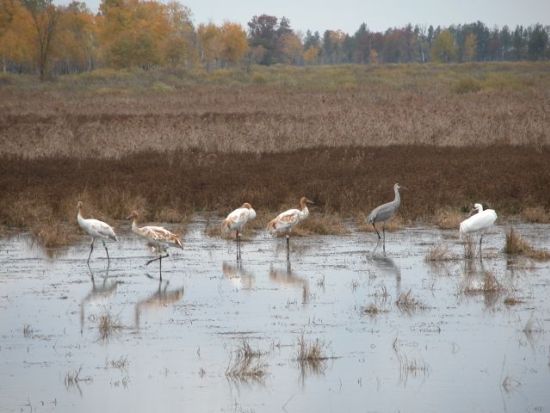
Four DAR chicks hanging out with a sandhill and #12-02 in a marsh a Necedah NWR
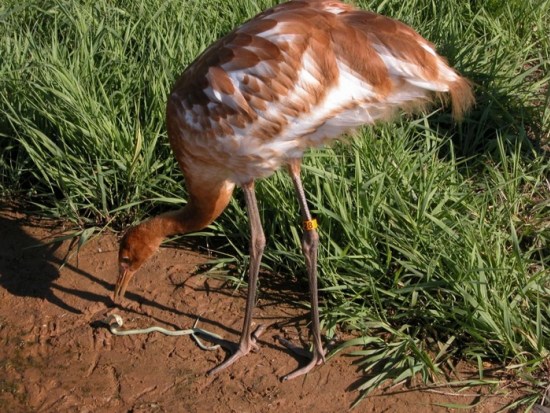
Whooping cranes are omnivores. They eat plants and snakes, crayfish, grasshoppers. Here 28-05 has found a small snake to eat.
History
Fall 2005: First Migration South as a Direct Release Bird – All four DAR birds began migration Nov. 24 from Necedah NWR, leaving at 10:33 AM. They took off together with +50 sandhill cranes. Taking advantage of a strong tailwind, these birds soon outdistanced the tracking team. Trackers heard no signals the rest of Day 1. On Nov. 25, Day 2, DAR #28-05 (with #32-05 and #33-05) again joined sandhill cranes and flew all the way to Hiwassee NWR in Tennessee. Each of the whooper chicks arrived separately with a different sandhill flocks.
Poe (DAR #28-05) was last of the three to reach Hiwassee on Nov. 25. Tracker Stacie and pilot Charles Koehler had been looking for her from their small plane. There she was, flying in a “V” formation with more than 50 sandhill cranes! In the next few miles, the birds would have to climb nearly 2,000 feet to clear the highest ridge before reaching the haven of Hiwassee Wildlife Refuge in Tennessee. She looked very tired. The pilot said, “She was obviously sucking air. Every time we saw her, she was farther back in the V. The last time I saw the formation she was only six birds from the end.” For over an hour the pilot circled over the dark ridge line while Tracie monitored her progress by listening to #27-05’s radio signals. Whether on her own, or clinging to the “V,” Poe made it over the mountains and landed at the refuge. HOORAY! Amazingly, these three DAR chicks arrived at the halfway point on the same day as their flock mates led by ultralights! DAR Chicks #27-05 and #28-05 remained in the large sandhill flocks on or near Hiwassee Wildlife Refuge.
Spring 2006: Began migration from Hiwassee Wildlife Refuge in Tennessee on February 26! She was with DAR female #27-05. PTT readings showed they roosted that night in Kentucky. They were in northwestern Indiana by 28 February. Then the two eventually split from each other. Chick #28-05 joined with migrating sandhill cranes and stayed in the area. She resumed migration on March 30 and arrived at Green Lake County, Wisconsin on April 3. She was the FIRST of the four DAR chicks to return! She stayed there until making the flight to Necedah NWR on April 23. She returned to the exact site where she was reared last summer! She wandered and then spent most of the summer with a sandhill crane flock in Marathon County, WI.
Fall 2006: Still in Marathon County, WI as of Nov. 18. In Jasper county, IN on Nov. 25. Remained with about 100 sandhill cranes in northwest Tennessee.
Spring 2007: Confirmed back on Necedah NWR in Wisconsin on March 23.
Fall 2007: Began migration from Wisconsin on November 22. Found on Hiwassee WR in Tennessee on December 1 and was still there at the end of December.
Spring 2008: DAR #28-05 was reported with migrating sandhills in Jackson County, Indiana, from March 13 until she resumed migration March 16 or 17. She was reported in Wisconsin’s Clark County on April 2 , and in Marathon County April 5. Home!
Fall 2008: Reported with large numbers of Sandhill cranes in Wood County, WI on October 7. Confirmed at Hiwassee Wildlife Refuge on November 27, but her transmitter was not working. She was confirmed on her wintering area in Meigs County, Tennessee, on February 5.
Spring 2009: First home! Early Bird DAR #28-05 was reported with four sandhill cranes in Dodge County, Wisconsin, on March 8! By March 23 she was reported on her usual summering area in Marathon County, Wisconsin.
Fall 2009: She migrated and wintered as usual in Meigs County, Tennessee.
Spring 2010: Crane #28-05 (DAR) was reported with migrating sandhills northwest of White County, Tennessee on February 6 and 14. She was reported with migrating sandhills S of the Jasper-Pulaski FWA, Indiana, on March 9. She was confirmed back on her usual Wisconsin summer territory March 17.
Fall 2010: #28-05 (DAR) apparently departed from Jackson County, Indiana, on November 28. She was reported on her usual wintering area at Hiwassee WR, Meigs County, Tennessee, on December 2.
Spring 2011: Migrating female #28-05 (DAR) was reported in Montgomery County, Indiana, on March 1 and 2. She was reported on her summering territory Marathon County, Wisconsin on March 24.
Fall 2011: #28-05 (DAR) spent the first part of the winter in Jackson County, IN and then moved to Greene County, Indiana.
Spring 2012: Arrived back at her summering territory in Marathon County, Wisconsin by mid March, where she remained with sandhill cranes for the rest of the summer.
Fall 2012: #28-05 (DAR) migrated south by late November. She was reported at the Jasper-Pulaski FWA in Jasper County, Indiana, on Nov. 25 but continued south to Hiwassee WR in Tennessee, where she arrived by late December.
Spring 2013: Crane #28-05 completed migration on April 2. She was photographed 245 miles to the north on January 20, 2013 in Indiana among many sandhill cranes as well as in flight (below). Tracker Eva said, “It looks like she has started spring migration!” She has a nonfunctional transmitter and doesn’t generally hang out with other whoopers, so it was great to see her back! On April 24 she was positively identified at a location in Marathon County, Wisconsin.
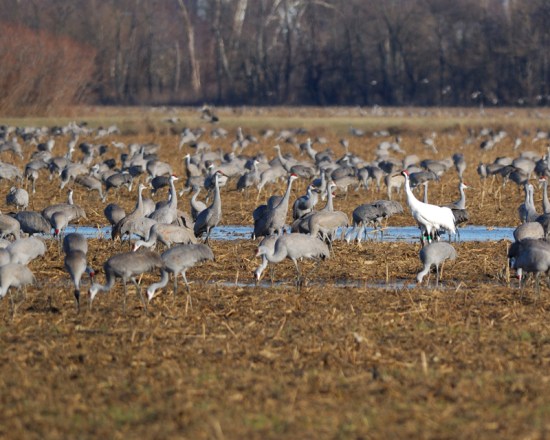
#28-05 among many Sandhill cranes. Photo: Jim Anno
Fall 2013: Crane #28-05 DAR wintered at the Hiwassee WR in Tennessee with many other whooping and sandhill cranes.
Spring 2014: Crane #28-05 DAR was reported in Jackson County, Indiana, on March 10-12. She was next reported in Jasper County, Indiana, on March 23.
Fall 2014: Crane #28-05 DAR began migration from Marathon County, WI on Nov. 3 and wintered as usual at the Hiwassee WR in Tennessee.
Spring 2015: Crane #28-05 DAR moved in late January from her wintering area in Meigs County, TN to southern Indiana. She stayed there until mid-March and was first seen back in Marathon County, WI on March 24, 2015. She was alone on territory for the rest of the spring and summer.
Fall 2015: She she was first seen on her wintering grounds in Jackson County, IN on January 3, 2016.
Spring 2016: Female #28-05 began moving north in early March and was seen in LaPorte County, IN on March 6th. By April she was back in Marathon County, WI. She was soon seen sitting on a nest, but no other Whooping Cranes were ever seen in the area. She was seen alone in Marathon County for the rest of the spring and summer.
Fall 2016: Female #28-05 DAR migrated to Jasper County, Indiana.
Spring 2017: Female #28-05 DAR migrated back to Marathon County, Wisconsin by March 19th and was with female #2-15. In a surprising turn of events, these two females were seen sitting on a nest in Marathon Co. when Wisconsin DNR pilot Beverly Paulan spotted them on May 12! This is anomalous behavior and the only plausible explanations the team has been able to come up with are: One of the females is actually a male, OR they’re incubating infertile/un-viable eggs, OR a nearby bachelor male paid a visit. Bev will continue to monitor the nests as time permits to see how they progress.
Egg fragments were collected well past the date they would have been expected to hatch. Unfortunately, we weren’t able to determine if the egg(s) were viable.
On October 18th this crane was captured and had a new VHF transmitter placed on her leg. At this time, blood was drawn so we hope to soon have a definitive answer on 28-05’s sex.
IT’S A GIRL! Blood test results confirm 28-05 is indeed a female.
Fall 2017: 28-05 and 2-15 were chosen to be foster parents to parent-reared chicks 19-17 and 25-17. The chicks were released near them in Marathon County on September 14th. Luckily, these two females took the chicks under their wing and migrated south with them! The group of four migrated to Jackson County, Alabama at the end of November. Male 37-07 also joined them. Trackers are hoping that these females will pair with the males that are with them.
Spring 2018: Unfortunately, the females moved on and left all the boys behind. They moved north into Hardin County, Kentucky, in early February, and were back in Wisconsin in early May. They are suspected to have nested again, but it was not confirmed.
Fall 2018: In early October, 28-05 and 2-15 began associating with young female 36-17. In mid-November, the group of three migrated first to southeast Indiana, then continued further south. Unfortunately, 36-17’s remains were recovered in late November after the group of three was roosting on a farm in Kentucky.
28-05 and 2-15 continued to move south to 28-05’s previous wintering grounds in Meigs County, Tennessee. They arrived in Tennessee on November 20, and stayed until early January, when they moved north to 28-05’s other previous wintering ground in Jackson County, Indiana.
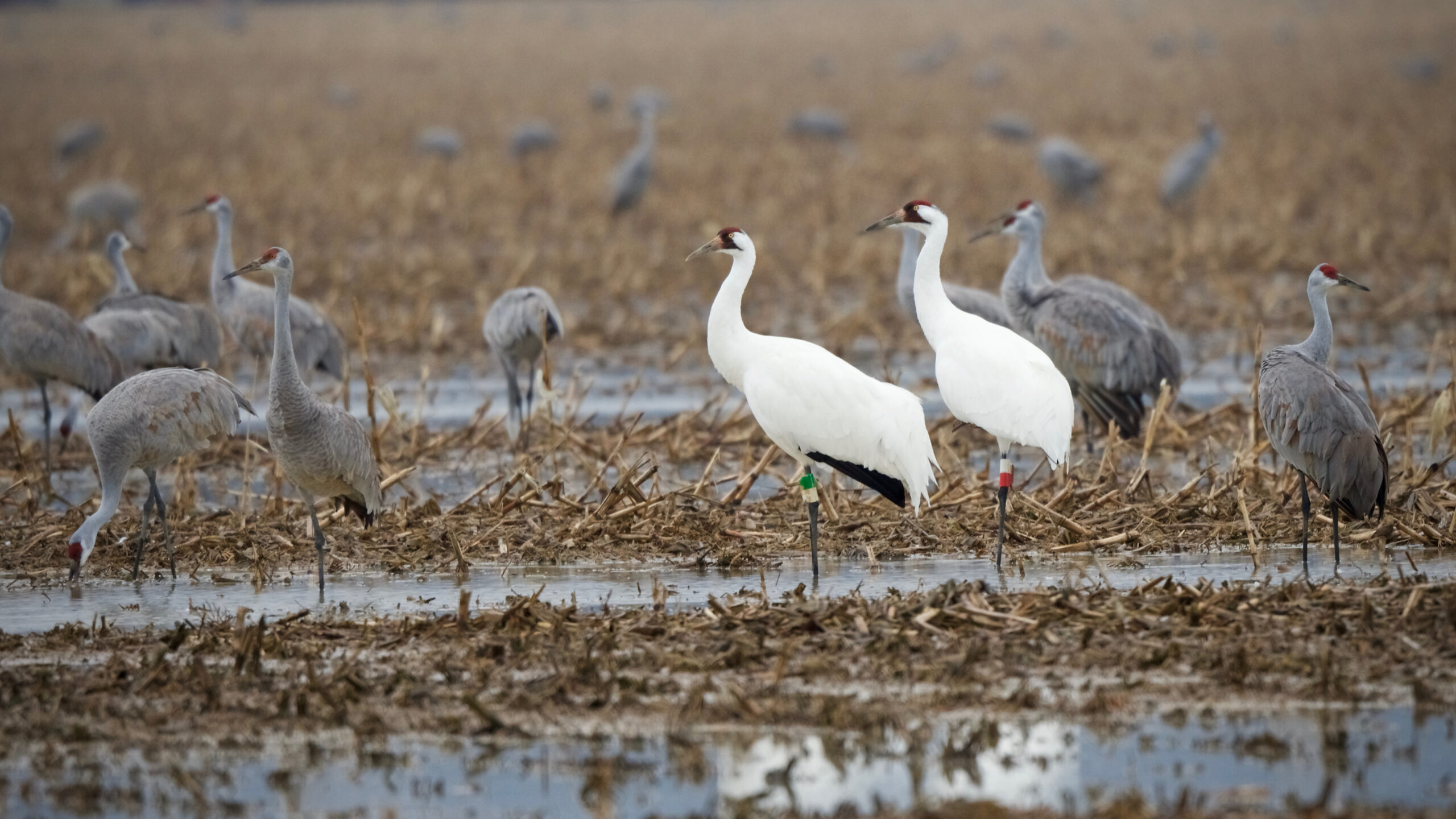
Spring 2019: After making many short stops over winter 2019, 28-05 and 2-15 were seen back in Marathon County, Wisconsin on March 26th! Trackers are very interested to see whether this female-female pair will nest again in 2019.
28-05, female mate 2-15, and male 19-17 were all seen around a nest by pilot Bev Paulan in early May. Male 19-17 died of a powerline collision shortly after. Though 28-05 and 2-15 have nested unsuccessfully before, researchers were hoping that male 19-17 may have fertilized the eggs before his death leading to a hatch.
The pair left the nest in early June. A nest camera shows that the eggs did not hatch, but the cause of the abandonment is unknown. Learn more about their nest attempt here.
Fall 2019: 28-05 and mate 2-15 spent the summer together in Marathon County, Wisconsin. By the end of November, the two arrived on their wintering grounds in Jackson County, Alabama. They spent the winter here.
Spring 2020: 28-05 and 2-15 were first spotted back in Wisconsin at the end of March. Shortly after, the two started nesting and laid 3 eggs between the two of them. Since they were not fertile, ICF staff took eggs from a pair at Necedah National Wildlife Refuge and gave them to the pair. The ladies hatched one chick; however, the chick did not survive. Later in the summer, pilot Bev Paulan, found the remains of 28-05 and saw 2-15 was injured.
Click here to jump to the top of this page.
Crane #32-05 “Waldo”
Sex: Male
Hatch Date: June 12, 2005
Personality and Characteristics: Migration Training – He was hatched at ICF from an egg laid at Patuxent Wildlife Research Center in Maryland. The biologists who raised him there called him Waldo. He transferred to the Necedah NWR at 1 month of age. Marianne Wellington is a chick-rearing specialist who wore a costume and raised the 4 DAR chicks there. They fledged (had all their flight feathers and could fly) when they were around 70 days old. Unlike their cousins for the ultralight-led migration, the DAR chicks roamed freely on the refuge. Marianne and other costumed parents checked on them many times each day. At night until they’re released the chicks are safe in a big pen with a pond and a net over the top. Weight: 6.4 kg on Oct. 22. He has been hanging out with other whooping cranes, sandhill cranes and DAR chicks on the refuge and nearby areas.
History
Fall 2005: First Migration South as a Direct Release Bird – All four DAR birds began migration Nov. 24 from Necedah NWR, leaving at 10:33 AM. They took off together with +50 sandhill cranes. Taking advantage of a strong tailwind, these birds soon outdistanced the tracking team. Trackers heard no signals the rest of Day 1. On Day 2, #32-05 (with DAR #28-05 and #33-05) again joined sandhill cranes and flew all the way to Hiwassee NWR in Tennessee–each arriving separately with a sandhill flock, but on the same day as their flock mates led by ultralights! (Chick #32-05 was second of the three to reach Hiwassee.) He resumed migration again Nov. 30. He has not been located since then, and tracking aircraft have not been available to complete a search of sandhill crane wintering areas where he might be found.
January 31, 2006: DAR Chick #32-05 is found! Tracker Lara Fondow and a helper found him on a ranch in Osceola County, Florida. On Feb.1 he was observed with small numbers of nonmigratory sandhill cranes in a wetland on the ranch.
Spring 2006: He was no longer on his wintering spot when checked on March 23. He began migration between 8 and 23 March. He was not tracked, and no reports were received during migration. His radio signals were detected on May 4 at home in central Wisconsin (Jackson County). He remained in that general location one more day before disappearing again until his arrival on Necedah NWR on May 18 with two sandhills. Soon he joined #3-04 and #12-04.
Fall 2006: #32-05 (DAR) left Wisconsin on Nov. 19 with #16-02 and #16-05. They made it that night to SE Indiana. Last detected in flight in Dixie County, FL Nov. 22 and not seen again until February 9, 2007. Crane #32-05 (DAR) was located in Florida during an aerial search. He was in a flock of about 25 apparently nonmigratory Sandhills cranes in a cattle feedlot and near to human activity. A local resident said he’d been there for about a month. (It would be safer for him if he would avoid humans.)
Spring 2007: Confirmed back on Necedah NWR in Wisconsin on March 23. On July 31, his body was discovered on the edge of a dried-up pond. He likely was killed by a predator sometime in the first two weeks of July.
Click here to jump to the top of this page.
Crane #33-05 “Maya”
Sex: Female
Hatch Date: June 15, 2005
Personality and Characteristics: Migration Training – She was hatched at ICF and called “Maya.” She was transferred to the Necedah NWR at 1 month of age. Marianne Wellington is a chick-rearing specialist who wore a costume and raised the 4 DAR chicks there. They fledged (had all their flight feathers and could fly) when they were around 70 days old. Unlike their cousins for the ultralight-led migration, the DAR chicks roamed freely on the refuge. Marianne and other costumed parents checked on them many times each day. At night until they’re released the chicks are safe in a big pen with a pond and a net over the top. Weight: 6.5 kg on Oct. 22.
Chick #33-05 (along with #27-05) was released for good on the refuge near adult whooping cranes on Oct. 25, 2005, near wild adult whooping crane #5-02. She has been hanging out with other whooping cranes, sandhills, and DAR chicks on the refuge and nearby areas.
History
Fall 2005: First Migration South as a Direct Release Bird – All four DAR birds began migration Nov. 24 from Necedah NWR, leaving at 10:33 AM. They took off together with +50 sandhill cranes. Taking advantage of a strong tailwind, these birds soon outdistanced the tracking team. Trackers heard no signals the rest of Day 1. On Day 2, #33-05 (with #28-05 and #32-05) again joined sandhill cranes and flew all the way to Hiwassee NWR in Tennessee–each arriving separately with a sandhill flock, but on the same day as their flock mates led by ultralights! (Chick #33-05 was first of the three to reach Hiwassee Meigs County, on Nov. 25.) Her PTT reading on Dec. 17 was still at Hiwassee Wildlife Refuge. On Dec. 22 she was found in a marsh in Alachua County, FLORIDA (in a flock of about 120 sandhill cranes). She stayed in Alachua County, usually in a cattle pasture and associated wetlands with nonmigratory sandhill cranes.
Spring 2006: Began migration March 29. Tracked in flight on March 30th as she migrated through northern Georgia into Tennessee. She roosted in Jefferson County, IN on April 1, just 8 miles north of the HY2005 group of 14! Radio signals indicated that she resumed migration April 2 (behind the fourteen 2005 birds) from Jefferson County, IN, but apparently landed because of bad weather after only a short flight. Blown by strong west winds, she was discovered in Rush County, IN, April 4. She stayed at that location for the remainder of the week. On April 20 we learned she corrected her course and is now in Michigan.
She was still in Barry County, Michigan in early June. The crane team tried to capture her for return to Wisconsin. The attempt was unsuccessful because there were so many sandhill cranes present that it was hard to get to her, and she was still in Michigan at the end of August. The good news is that she is not alone, but among many sandhill cranes.
Fall 2006: Began migration Nov. 19 and made it to Hiwassee NWR in Meigs County, Tennessee, by November 20. Still there, with #27-05 and thousands of sandhill cranes, as of Jan. 20. She was reported as limping with an injured left leg.
Spring 2007: Began migration from Meigs County, TN on an unknown date and arrived Jackson County, IN by Mar. 1. She stayed there with Sandhill cranes until March 21. She resumed migration and moved to Indiana (PTT reading). On March 26 she was in Oceana County, Michigan, where she remained. On May 25 her PTT batteries stopped working, so she will be hard to track. She was observed June 11 in Van Buren County, MI, but was not found when the area was last checked August 9.
Fall 2007: Remained with large numbers of staging Sandhill cranes in Michigan. Left Michigan on migration after November 19. Found on Hiwassee WR in Tennessee on December 1. She was still there at the end of December.
Spring 2008: DAR #33-05 was reported with migrating sandhills in Jackson County, Indiana, until she resumed migration March 16 or 17. She was next reported with Sandhill cranes in Mason County, Michigan on April 11, 2008. (The eastern shore of Lake Michigan in Oceana and Mason Counties is the area where spring-moving Whooping cranes most frequently stop after they encounter Lake Michigan and do not cross.) On September 22 and 25 she was reported with one sandhill crane in Van Buren County, MI.
Fall 2008: She was reported with several hundred sandhill cranes in Michigan on Nov. 20, but she was found on Hiwassee Wildlife Refuge in Tennessee on the morning of December 1. She had likely arrived the night before. Where did she spend her previous winters?
Spring 2009: DAR #33-05 was reported with sandhill cranes in Hardin County, Kentucky, on February 22 through at least March 1. A Whooping crane reported in Van Buren County, Michigan, on August 18 and again Oct. 27 was probably her.
Fall 2009: A Whooping crane, probably DAR #33-05, was reported in Cass County, Michigan, at mid-November. She was found with sandhills in Jackson County, Indiana, on December 14. Her transmitter was confirmed nonfunctional but she was confirmed in her usual wintering area on Hiwassee WR and Armstrong Bend, in Meigs County, Tennessee.
Spring 2010: DAR #33-05 was reported with migrating sandhills in Barren County, Kentucky on February 6. She was reported with migrating sandhills in Jackson County, Indiana, on February 25. She remained there through at least March 6.
33-05 was last seen March 2010.
Click here to jump to the top of this page.

